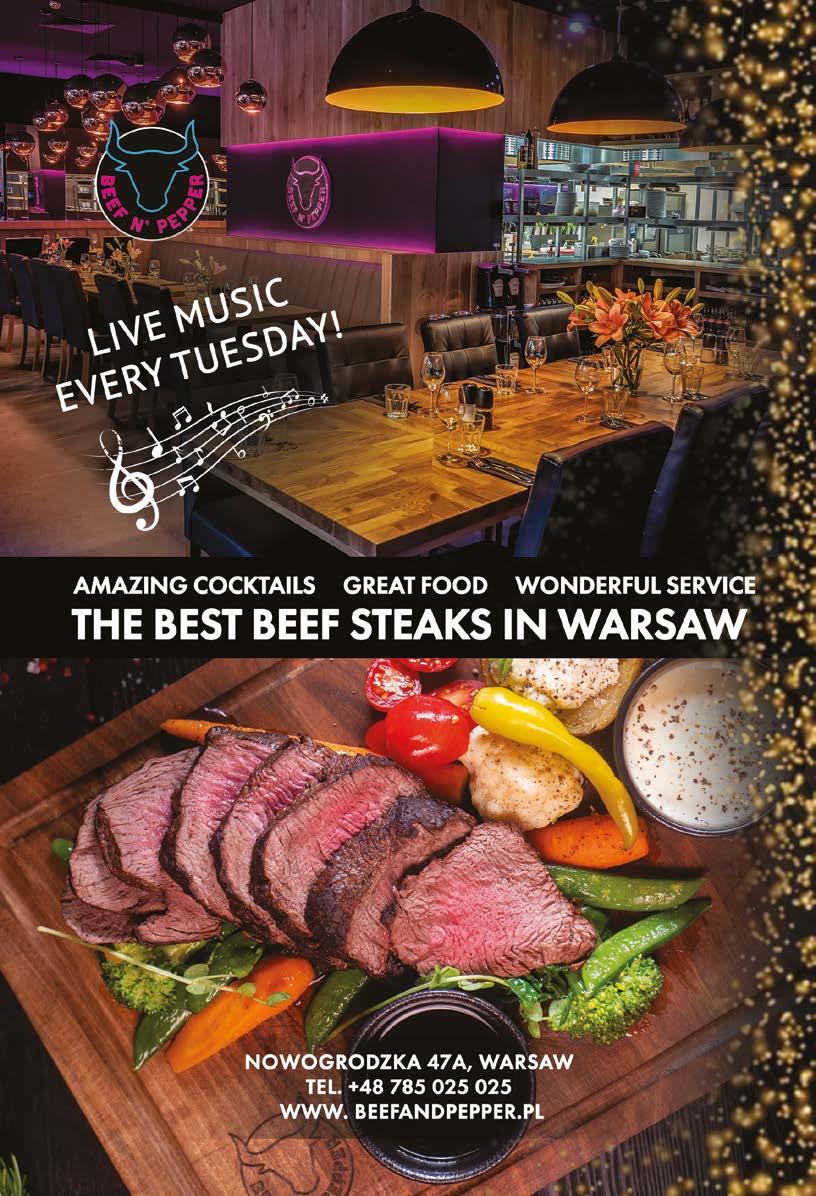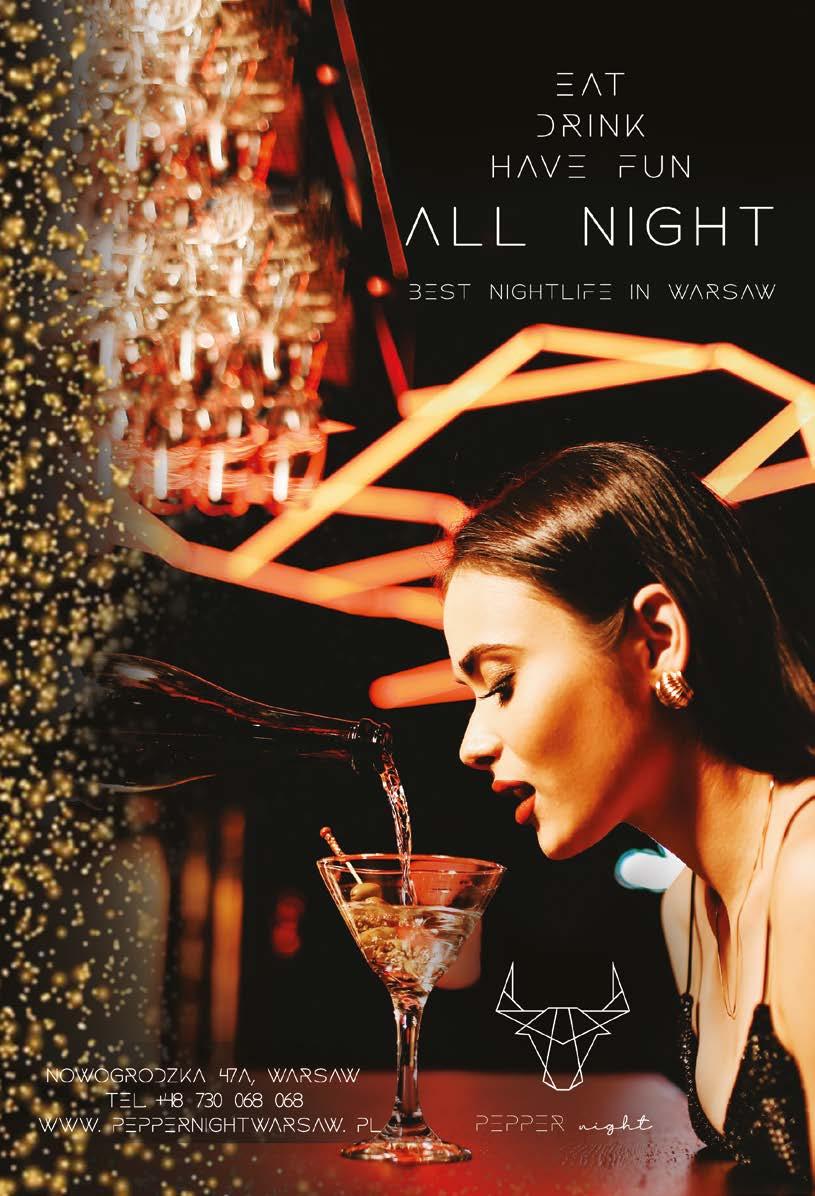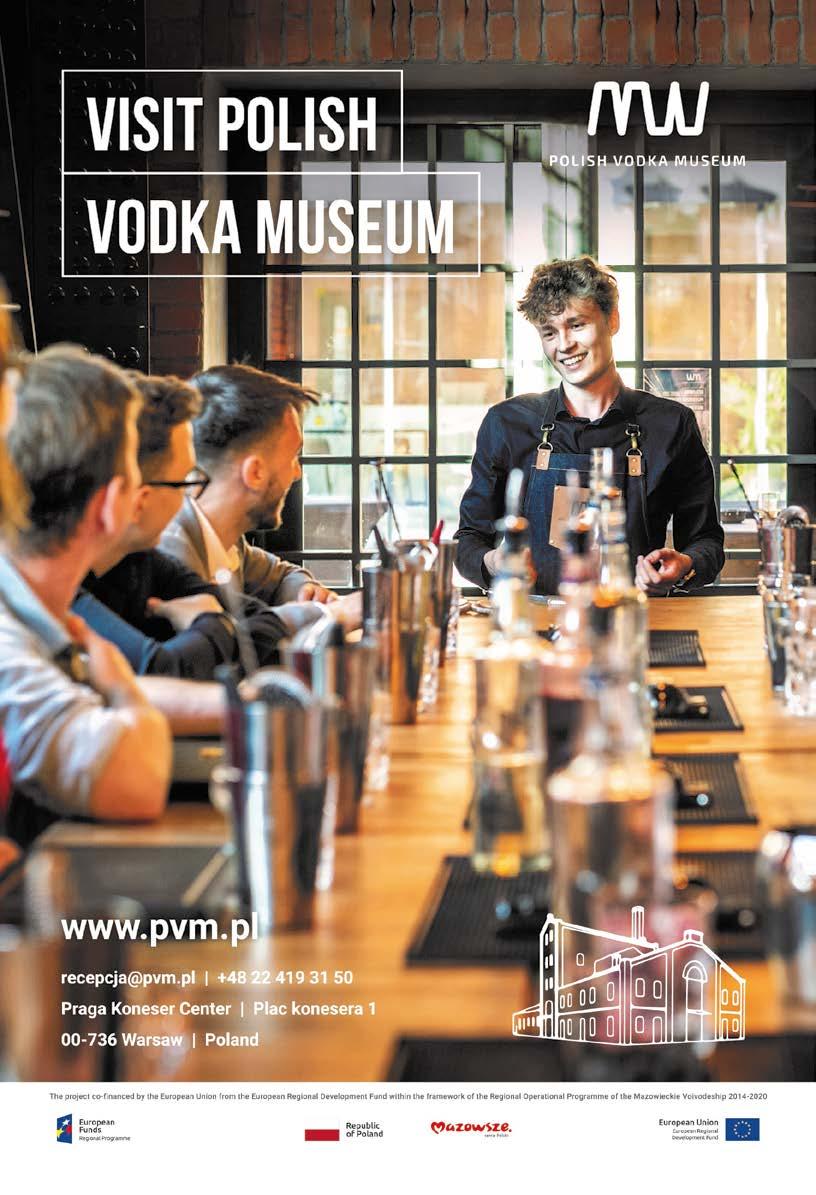Warsaw
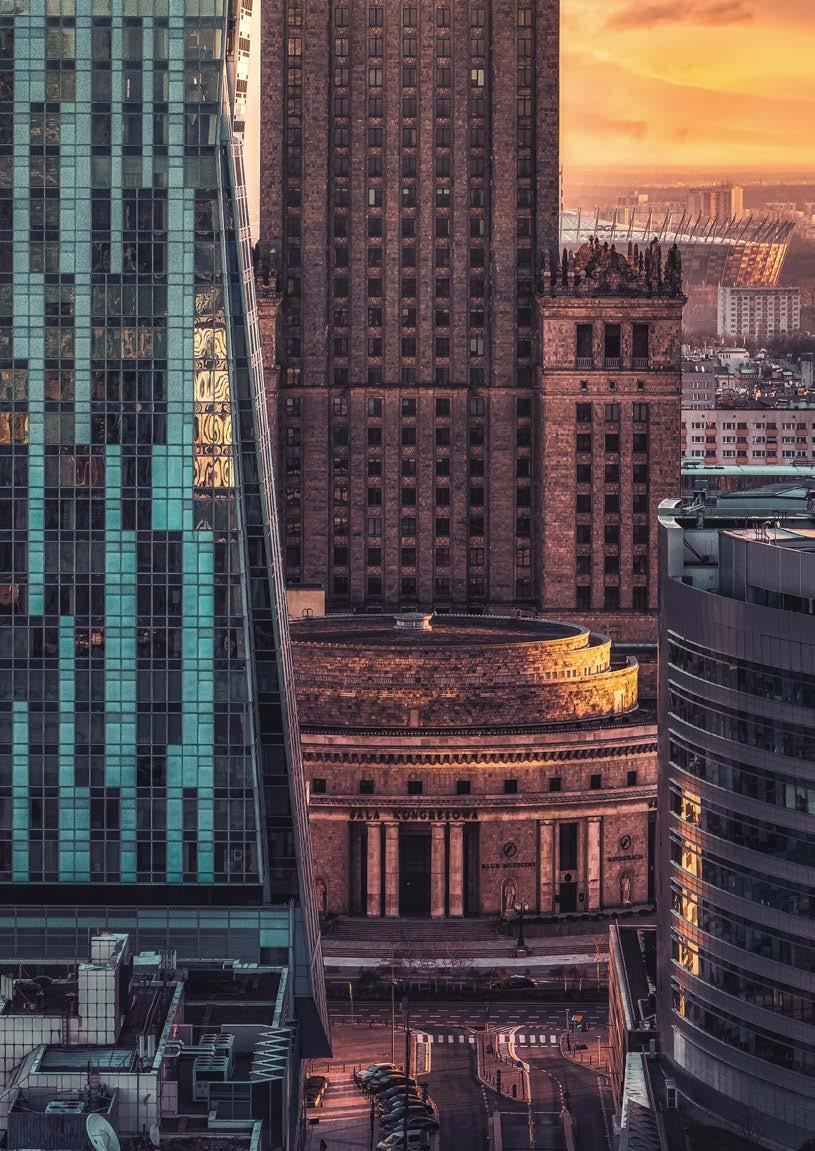
No. 126, February – March 2023
City Guide SINCE 2001
Featured this issue: The Many Faces of Warsaw p.10
7 Varsovians you need to know!
Browary Warszawskie
- What’s Happening in 2023? p.14
Food, Drink & Fun at the historic brewery site!
Art, History & Culture p.60
‘What’s on?’ and ‘Where?’ in Warsaw!
Maps Sightseeing Activities Dining Nightlife Shopping


8 8 7 7 6 6 5 5 4 4 3 3 2 2 B 1 C D E F G H I J K L M 1 WARSAW CENTRE p . Warszawa Centralna Warszawa Wschodnia Warszawa Stadion Warszawa Powiśle Warszawa Gdańska Warszawa Wileńska Warszawa Śródmieście Warsz. Śródm. Centrum M2 M1 M1 Świętokrzyska Rondo ONZ Stadion Narodowy Dworzec Wileński Rondo Daszyńskiego Nowy Świat-Uniwersytet M2 Dworzec Gdański M2 Ratusz Arsenał Centrum Nauki Kopernik M1◀Młociny Szwedzka Trocka▶M2 POWIŚLE PRAGA MARIENSZTAT STARA PRAGA OLD TOWN NEW TOWN SASKA KĘPA MURANÓW PORT PRASKI MIRÓW CYTADELA ONZSEL TOWAROWA TOWAROWA MICKIEWICZA ATSORP ŃIMOŁS OGEIKS LA EIKSMILOZOREJ. LA . " "ICŚONRADILOS WYB.GDYŃSKIE WYB.HELSKIE WYB.GDAŃSKIE JAGIELLOŃSKA WYB.SZCZECIŃSKIE WIOŚLARSKA SZWEDZKA WYB.SZCZECIŃSKIE LA . " "ICŚONRADILOS LA . " "ICŚONRADILOS WAŁMIEDZESZYŃSKI GROCHOWSKA AL. "SOLIDARNOŚCI" MARSZAŁKOWSKA AL.JANAPAWŁAII AL.JANAPAWŁAII TARGOWA LA ANOTGNYZSAW. OKOPOWA OKOPOWA GEN.ANDERSA Sp o koj n a K lo s k a W lo s k a Burakowska Ż tyin a Karolkowa Dizanle Piwa a Wolność A l . W o jks a P loks i e og iNks a hC ł doan łiM a K ł o p o t ilGinana Gbyzrkswo a G zr bykswo a G ne . J ó z fe a Z a j ą c z k a Łkcu a Wronia Dzika ikwatS S tkwa i Nowolipie Niska inAleiweazc Miła Odorgawo Smocza Khcorlaman Miedziana Sberanr J . ogeikswotraweL Dizlean Biała anlarotkelE adrawT ilowoNikp Nilowoikp Karmelicka hCimlean Pawia Śmiała lfnIakcna Ldu kiw a R dyigy e r a łZto a adrawT Żelazna Żelazna iSanne Ciepła Orla Bonifraterska awokrapyzdęiM Pńaks a aksrotkiwnoK Wałowa P t isa a Ś l i ks a Nowiniarska łZto a Śiw tęko zr ksy a Świętokrzyska Bielańska Próżna B a ong wódeneW Hżo a Zakroczymska Rafała K r a j e iksw e og Ciasna EmiliiP EmiliiPlater Ś iwę t o jaksre Koźla Klórkswe a ałaceiN agułD R isy a Bul.Karskiego Freta Miodowa Kdertyawo Podwale Rybaki S aksrotane Ndorgowokz a Żiwaru a Piwna Jasna diWko Ndorgowokz a Kozia W s óp l an akzdorG hCimlean aworaK Wkcera a źobO an Bracka K Krucza No w y Z j a z d Fkolas Bdeksran a Browarna Dynasy aworaK iLawop K s ią żę c a daRan Topiel ńyzczseLks a óJycjanazSafez lomSan Wi Takma ogeikswokzcurK Panieńska Solec Dobra Dobra jaZazcę J.Sierakowskiego Namysłowska F lo r iańska awozsutaR Dąbrowszczaków kOiezr anduL Czerniakowska Inżynierska Rozbrat Targowa Okrąg Mała anpęK akswonaliW Bulw.FlotylliWiślanej Solec Z kbąkswo a iBakcotsoła Z a m o ś ic e adapotsiL11 Brzeska Konopacka alokoS Środkowa anwóR Jakubowska Markowska W a l e c z n hcy B e r ze ńyaks Czeska awolatS Stalowa L i ksp a Gdorńeizaks Dąbrowiecka ńyzcęwaKks a icywZóczę w Katowicka Al.Zieleniecka jiKkswo a akswojiK iSldekce a akslebuL Poselska aksńaipokaZ Łżmoaksńy aksńimyzdaR Francuska ikwórbąD KrakowskiePrzedmieście NowyŚwiat Poznań Mke s kyńaks a Saska Saska Obrońców Niekłańska Londyńska Międzynarodowa ńiMks a Ż u inpazc Łhcokswo a arellihcS óGksr i e og Czackiego Smocza Ficnarkzsńaaks S a ipżeńyks a Moliera Wierzbowa Zg o da lP . iMkswor i Waliców Zamenhofa Mazowiecka ParyskaWandy Nobla B Wąchocka Kbuńaks a lParellaH. Bathcer Borowskiego ńeliWaks Otwocka aksńimołoW Grajewska Jagiellońska ikswotopołKoge ogeikswoknicraM Żelaz Pńaks a drawT a otnarepsE Bulw.Religi Bulw.Pattona Bulw. Pattona Bugaj Wisła Wisła Złote Tarasy PKIN Westfield Arkadia Fort Traugutta CH Warszawa Wileńska Pl. Trzech Krzyży Polonia Stadium ROYALROUTE Mtso Pinotakswo i e og LA OZOREJ. EIKSMIL Śląsko-DąbrowskiMost Most Gdański kotęiwŚtsoMiksyzr Presidential Palace Park Kultury ParkŚmigłego-Rydza SkaryszewskiPark ZOO Park JaninyPorazińskiej Saxon Garden OgródKrasińskich Park Praski PowązkiCemetery Okopowa Street Jewish Cemetery Platinum Residence BrowaryWarszawskie FabrykaNorblina PragA!partments National Museum Warsaw Chamber Opera Ateneum National Theatre Hit Premiere Classe Hilton The Westin Hetman Ibis Stare Miasto Ibis Centrum Maria Leonardo Royal Hotel Po Wiśle RóżyckiBazaar PragaMuseum National Stadium Le Targ Rolniczy Targ DobregoJedzenia Klif VITKAC St. Augustines St. Carlo Borromeo St. Mary's A Footbridgeof Memory Ghetto Heroes Monument Anielewicz Bunker POLIN Ghetto Wall Fragment Umschlagplatz Willy Brandt 'Kniefall' Monument CopernicusScience Centre Fryderyk ChopinMuseum Katyń Museum Railway Wola Museum Multimedia Fountain Park Pawiak Prison Warsaw University Warsaw Rising Museum Neon Museum Soho Factory HolidayInn NYX SapperMonument Poniatówka Beach Saska KępaBeach Praga DistrictBeach Ibis Styles PragaKoneser Center Polish Vodka Museum Moxy Holiday Inn Express Crowne Plaza Plac Europejski ◀Ks.M2 Janusza 23
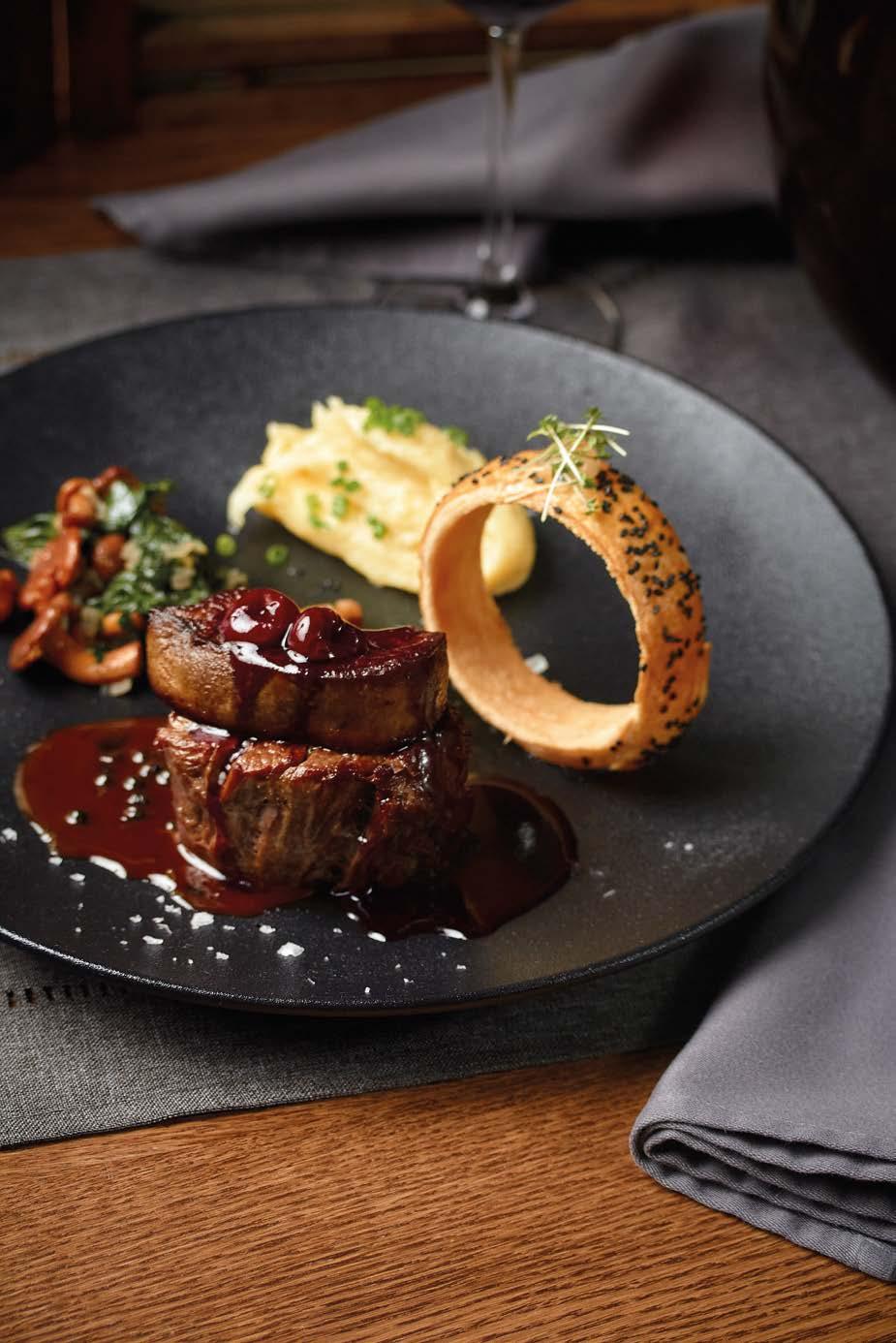

5 Contents Warsaw
an immersive guidebook for independent travel... Introducing Warsaw p.07 How to Use This Guide p.0 8 Features The Many Faces of Warsaw p.10 Browary Warszawskie p.14 Traditional Polish Dishes p.16 Transport p.18 Sightseeing Essential Warsaw p. 21 City Centre p. 22 Old Town Walking Tour p.32 The Royal Route p.40 Powiśle p.46 Łazienki Park p.50 Wilanów p.54 Praga p.56 Art, History & Culture Art Tourism p.59 Current Exhibitions p.60 Museums p.62 Jewish Warsaw p.66 Warsaw Uprising p.68 Activities p.70 Kids & Families p.72 Dining Featured p.75 Breakfast & Brunch p.76 Casual Dining p.78 Fine Dining p.82 Food Markets p.86 Nightlife Featured p.89 Bars & Clubs p.90 Adult Entertainment p.95 Shopping p.96 Venue Index p.102 Maps City Map p. 2 City Centre Map p. 23 Old Town Map p.33 Royal Route Map p.41 Powiśle Map p.47 Łazienki Map p.50 Wilanów Map p.55 Praga Map p.56
The brand new Museum of Fantastic Art - p.64 | Maksymilian Novak Zempliński ‚Untitled’
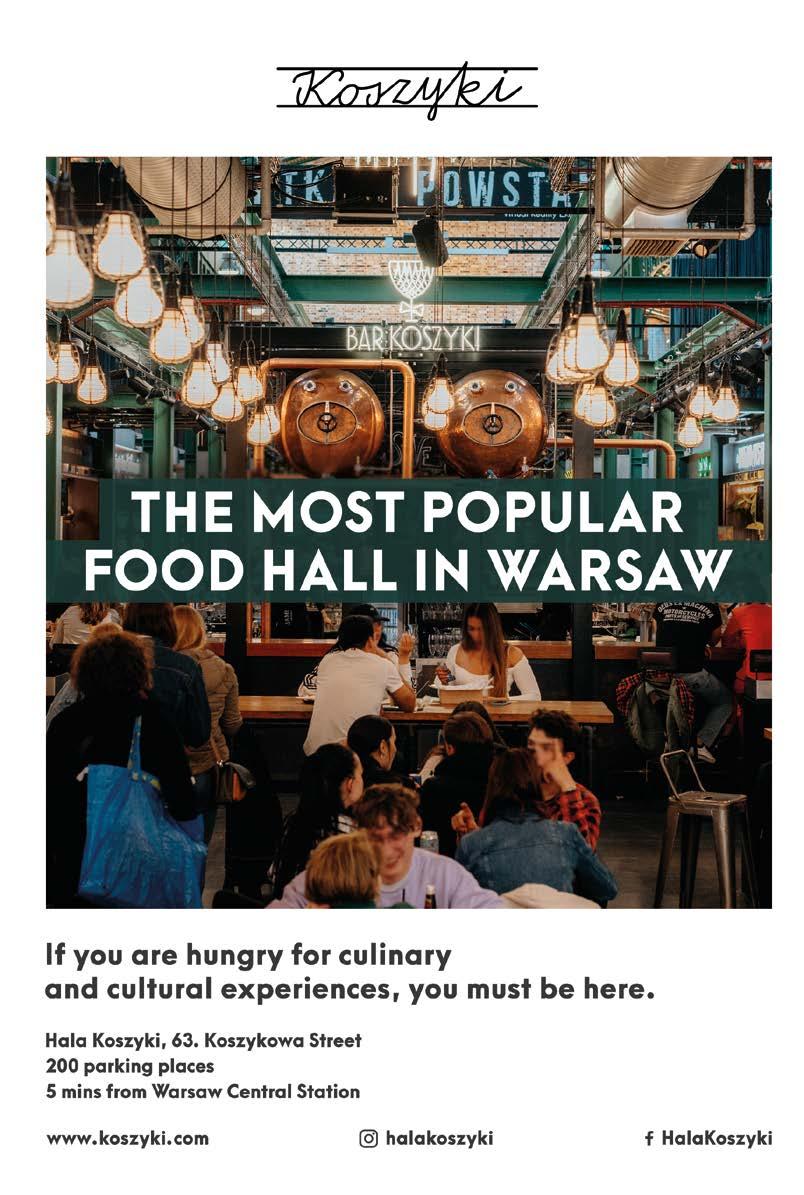
Welcome to Warsaw
Located on the Vistula River at the very crossroads of Central Europe, Warsaw is the 8th most populous city in the European Union (1.7 million people) and a major cultural, political and economic hub.

The city has had a troubled history ever since King Sigismund III Vasa moved his royal court from Kraków, making Warsaw the new Polish capital in 1569. Pillaged by the Swedes in the 17th century, and occupied by Russia for most of the 19th century, Poland was off the map for 123 years before returning in the aftermath of WWI. The interwar period signalled a golden age for Warsaw, as the city developed on par with other great European capitals.
WWII brought new suffering, however. Occupied by Nazi Germany, Warsaw saw its cultural monuments defiled or stolen, and its Jewish population of 350,000 systematically exterminated. With liberation in sight, the Polish population rose up against their German occupiers in August 1944, only for Soviet forces to look on as the Nazis brutally crushed the Uprising and destroyed the city in reprisal. When the fires were extinguished, 150,000 more civilians were dead and German occupation had merely been traded for Soviet oppression, as Poland was pinned under Moscow’s influence for the next four decades, during which Warsaw was rebuilt in communist fashion, earning a reputation as a charmless city of concrete.
But that was then, this is now. A compelling blend of East and West, past and future, today’s Warsaw is a modern metropolis of complex character and rich rewards for those who get to know it. Gone are the gloomy images of yesteryear as the city restlessly evolves, buzzing with energy and optimism. Whether you’re here to explore trendsetting urban culture or UNESCO treasures, world-class dining or luxury boutiques, you’ll hardly be disappointed by all the modern capital has to offer. Enjoy Warsaw!
7 Introducing Warsaw
Snow-covered Warsaw in the peak of winter. Photo by Łukasz Szczepański / AdobeStock.
How to Use This Guide
Warsaw In Your Pocket is designed to provide you with all of the ideas, tools and information you need to explore the city on your own, stay offline as much as possible, and really connect with the city you’re visiting.
Over here at IYP we still believe that the best way to understand the space you’re in is with a map, and the most immersive way to explore it is on foot. As such, our Sightseeing chapter is organised into geographic areas of interest with detailed district maps to help you navigate them. Selfguided district tours include descriptions of all the most important sites, plus local tips on where to eat and drink in each area. There are also intriguing ‘Crossroads’ moments that allow you to be lured towards alternative adventures, either on foot or via public transport.
Throughout the guide, page references are liberally used to lead you to related info on a topic elsewhere in the guide, while QR codes will take you to our website when we feel there’s more to know than can be expressed in print. Each venue listing includes a map coordinate (E-8, for example) that correlates to the city map on p.2-3. If there’s a specific venue you’re searching for, use the Venue Index in the back of the guide to quickly find it, or simply follow our informed suggestions.
Cover Story
A fantastic cross-section of Warsaw’s urban centre, including the Palace of Science and Culture (p.26) and the Warsaw Spire (p.30). Photo by Aleksander Głowacki (@alex.snaps.colours).
Publisher & Staff
IYP City Guides Sp. z o.o. Sp.k. ul. Karmelicka 46/51, 31-128 Kraków
iyp.com.pl
poland@inyourpocket.com
Circulation 12,000 copies published every 2 months
Warsaw IYP Online
Of course, space in our print guide is a finite resource, but if you don’t find what you’re searching for here, we’re confident you’ll find it on our website. Visit warsaw.inyourpocket.com for more info about the capital, and poland.inyourpocket.com to see just how much of the country we cover.
Here is some extra content we wish we had room for in print this issue:
Warsaw Day Trips
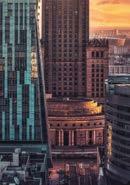
Read through our entire guide, done it all and still looking for more? Of course not, but the surrounding region still offers many sites worth exploring, from national parks to spa towns.
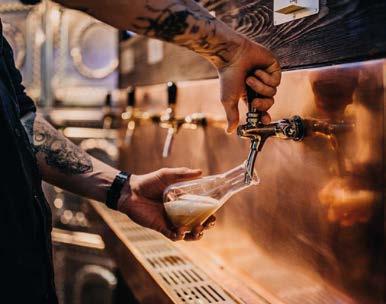
LUTY | February in Poland
The second month of the Polish Calendar year, Luty (February) is typically the coldest time of the year, but by no means lacking in tradition and quirks! WATCH OUR VIDEO for more!
MARIA SKŁODOWSKA-CURIE A Radiant Career
Better known as Marie Curie, the world’s most famous female scientist was also a Polish, hailing from Warsaw. WATCH OUR VIDEO for more!
Editor: Pierre Duyker; Editor in chief: Garrett Van Reed
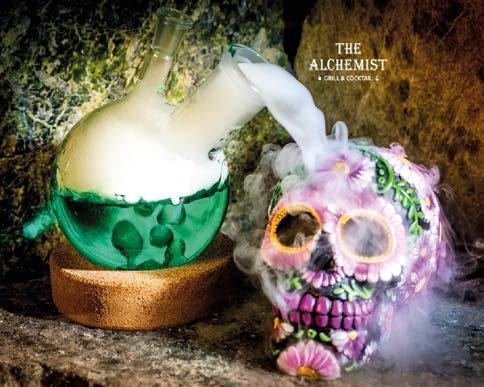
Sales Consultant: Jarek Śliwiński (+48) 606 749 643
Events & Marketing: Monika Boguszewska-Stopka (+48) 728 879 494

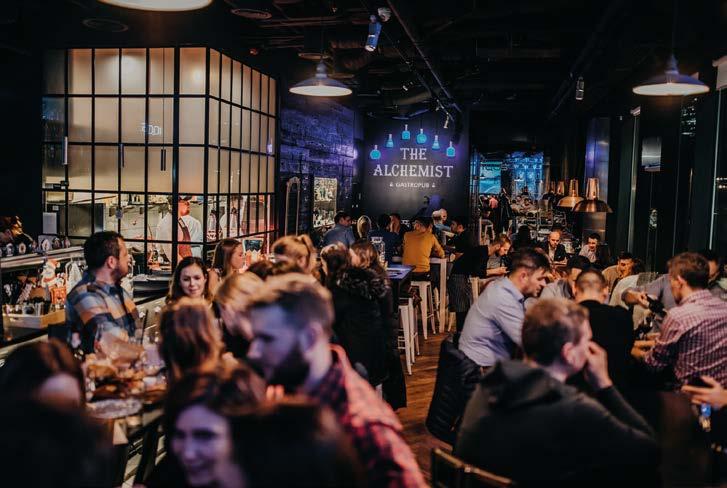
Research: Magdalena Kumala, Anna Janus
Layout & Maps: Tomáš Haman
Copyright Notice
All content copyright IYP City Guides Sp. z o.o Sp.k. and its partners, unless otherwise stated. No part of this publication may be reproduced without written consent from the publisher. The brand name In Your Pocket is used under licence from UAB In Your Pocket (Bernardinu 9-4, Vilnius, LT, tel. (+370-5) 212 29 76).
8 Introducing Warsaw

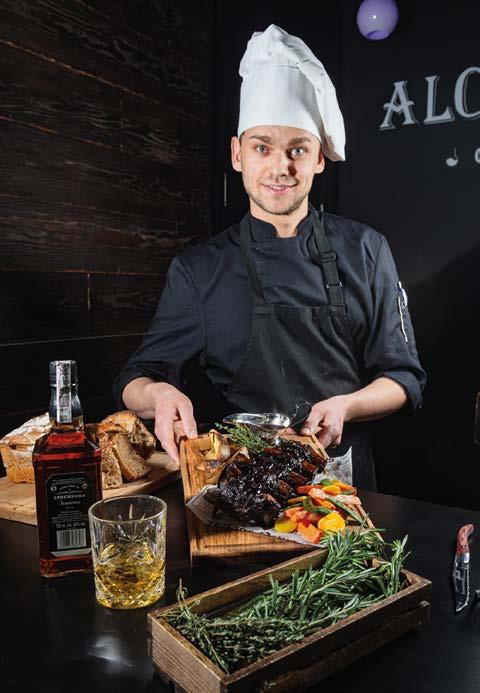




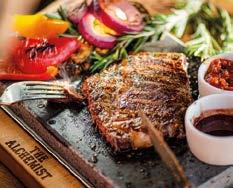
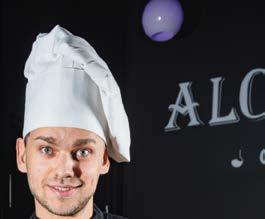
Iin this famous city centre spot INTERNATIONAL CUISINE ALCHEMY COCKTAILS DELICIOUS STEAKS BEER WALL a local Party like
n an immodest way, we can boast of an excellent menu, which includes a lot of proposals inspired by dishes from around the world. We rely on the experience of our Chef, Rafał Kowalczyk, who is the winner of the prestigious Gault & Millau 2020 award. We focus not only on the taste, but also the aesthetics of serving, so both your eyesight and your taste buds will be in seventh heaven! WARSAW ul. Grzybowska 5a Tel. 22 375 92 22 grzybowska@thealchemist.pl Plac Piłsudskiego 3 Tel. 22 628 00 23 info@thealchemist.pl feer p k com
The Many Faces of Warsaw
Warsaw has existed for over 1000 years, and the millions of residents that have called the city home have all contributed to the character and history of the city as we know it today. Here are a few names and faces that you will see on numerous streets and monuments of Warsaw.
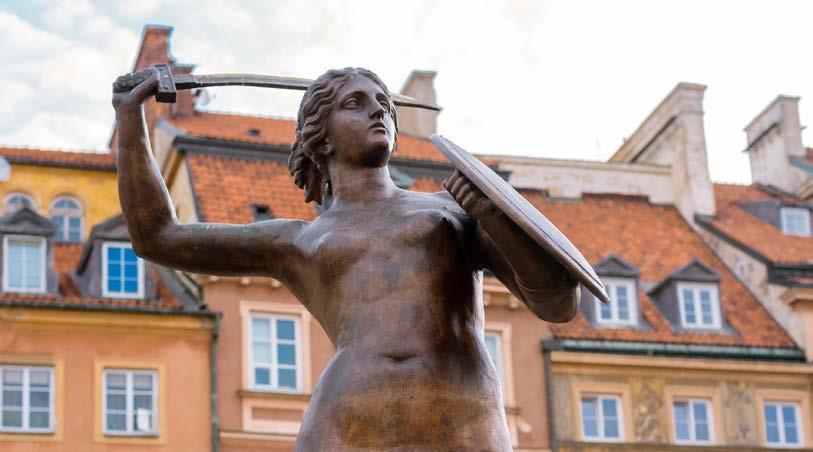
SYRENKA

The origins of the name Warsaw (Warszawa in Polish) are steeped in mystery. Locals are particularly fond of a legend that tells of a mermaid, or Syrenka, called Sawa, who travelled down the Vistula river from the Baltic Sea and seduced a fisherman in the local area by the name of Warsz - in other words, Warsz + Sawa = a romantic name for the village that was located here! Other versions of the Syrenka legend go further and say she used her voice to warn the townsfolk of oncoming raids. In reality, historians have concluded that local hostilities was certainly the reason that this little Vistula-side fishing village became fortified in the 12/13th century. By the time Warsaw gained city rights in 1323, Syrenka had already made her way onto the coat of arms. Her symbolic role as the protector of the city is only too fitting, considering the number of times that Warsaw has had to stand its ground over the centuries. Thus, Syrenka is portrayed bearing a shield and sword! Where to find: There are Syrenka statues In the old town market square (p.36) and on the Vistula Boulevards (p.46).
JAN III SOBIESKI
Warsaw became Poland’s administrative capital in 1569 (before that, it was Kraków) and would subsequently be a major target for invading powers. During one such defensive battle of Warsaw in 1656, a future Polish king would distinguish himself while heroically leading a regiment of Tatar cavalry against the invading forces of the Swedish Empire. When millitary hero Jan III Sobieski ascended to the Polish throne in 1674, Poland (now in a political union with Lithuania) was virtually penniless after 50 years of continuous war. Thus, he set about stabilising the country’s borders through treaties and other strategic millitary campaigns. His greatest moment would come in 1683, when the Ottoman Turks, having marched through most of the Balkans, began to converge on the outskirts of Vienna. Jan III Sobieski led a joint Polish/German/Austrian army and scored a magnificent victory in a day-long battle on 12 September 1683, decisively halting the Ottoman conquest. As Christian Europe had been saved from destruction, Sobieski would earn the title “Defender of the Faith” from Pope Innocent XI. Back in Warsaw,

10
The symbolic Warsaw mermaid, or Syrenka, who can be found all over the capital.
Sobieski made numerous contributions to the city’s development, most notably the construction of Wilanów Palace, which would be his residence until his death in 1696. Warsaw would serve as the defacto capital of Poland until the final partitioning of Poland in 1795. Where to find: His residence at Wilanów Palace (p.55) is a popular tourist attraction. His likeliness can be seen as a horse-bound statue in Łazienki Park (p.50, I-11).
TADEUSZ KOŚCIUSZKO

In the 18th century, political instability and corruption within the Polish-Lithuanian Commonwealth was taken advantage of by neighbouring Prussia, Austria and Russia. With its territories being gradually taken over (or ‘partitioned’) by these foreign powers, patriots such as Tadeusz Kościuszko were strongly in favour of constitutional reforms to maintain Polish sovereignty. Educated at Warsaw’s Corps of Cadets in the Kazimierz Palace (Krakowskie Przedmieście 26/28, G-6) and devoted to the ideas of the enlightenment, Kościuszko had made a name for himself fighting in the Continental Army during the American War of Independence, and saw a similar fight that had to be waged in his homeland. When the landmark constitution of May 3rd 1791 was signed in Warsaw’s Royal Castle (p.34), Tsarist Russian forces mobilised in response. Kościuszko commanded a Polish division and was successful in holding back a numerically and technologically superior enemy. However, the odds were stacked against the Poles, and more territory would be partitioned in 1793. Kościuszko still had not given up on Polish sovereignty, and he used his national and military status to reform the Polish forces and engage the occupying forces. The ‘Kościuszko Uprising’ of 1794 culminated in the Battle of Praga in Warsaw’s east (p.56), where its inhabitants were infamously massacred by the Russians. Following the surrender of Polish forces, the remaining territory of Poland-Lithuania was divided up a third and final time, completely erasing the country from the world map. Kościuszko was ultimately spared by the Russians, and would return to the newly-formed United States of America before living out the rest of his days in Switzerland. He died in 1817. Where to find: An impressive monument of Kościuszko stands on Pl. Żelaznej Bramy (E-6) between Saxon Garden and Hala Mirowska (both on p.24).
FRYDERYK CHOPIN

In the 19th century, the Polish people living under foreign occupation would make numerous attempts to regain independence. Most notably in Warsaw, the ‘November Uprising’ of 1830 was brutally crushed, and saw many Poles flee their homeland in a period known as the ‘Great Emigration’. One such individual who pursued a life abroad was Fryderyk Chopin, born in 1810 in Żelazowa Wola (50km from Warsaw) to a French father and a Polish mother. Years before the November Uprising, his family were teaching residents of the Warsaw Lyceum (now the Saxon Palace). Introduced to the piano by his mother, Chopin later continued his studies at the Warsaw Conservatory (now the Chopin University of Music) and, as a bonified child prodigy, he famously performed for Tsar Alexander I during his visit to the city in 1825. Chopin enjoyed his early adult life in the city’s young artistic and intellectual community and began traveling and performing abroad. But the events of 1830, he would never again return to Warsaw. Instead, he moved to Paris, where a well-established Polish community welcomed him with open arms, and he continued to flourish creatively. Now regarded as one of history’s most famous pianists and responsible for some of the most important classical works of the Romantic period, he is also regarded as one of the most famous Poles that ever lived. Upon his death in 1849, Chopin’s heart was removed upon his death and later interned in a pillar of Warsaw’s Holy Cross Church. His legacy lives on in numerous public recitals that take place around Warsaw throughout the year (p.44). Where to find: The Chopin Museum is currently closed, but his heart can be seen in the Holy Cross Church (p.43), and his iconic monument is in Łazienki Park (p.51).
MARIA SKŁODOWSKA-CURIE
When Maria Skłodowska was born in Warsaw in 1867, the city had been under Russian occupation for more than half a century. Use of the Polish language was forbidden, and women were not allowed to study at university. But Maria was the daughter of two teachers and fierce Polish patriots, and she was encouraged to receive an education in secret. Developing an interest in the sciences, her lack of academic prospects in
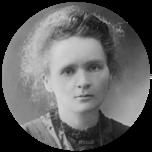
11 The Many Faces of Warsaw
The Many Faces of Warsaw
Warsaw forced her to emigrate to Paris. After earning two degrees and marrying French physicist and crystalographer Pierre Curie in 1895, Maria began pioneering research into the field of radioactivity. She discovered two new elements - Polonium and Radium - the first of which was named in honour of her homeland. Her work resulted in her becoming the first woman to win a Nobel Prize in 1903, and a second one in 1911 made her the only person ever to win a Nobel Prize twice! While the sudden death of her husband in 1906 was devastating, she celebrated the emergence of a newly independent Poland at the end of WWI, and visited numerous times with her two daughters. Most notably, in 1925, Maria was present at the foundationlaying of the Radium Institute in Warsaw (later renamed the Maria Skłodowska-Curie Institute of Oncology). Unaware of the hazards of radioactive research, the world’s most famous female scientist, often referred to as ‘Marie Curie’, passed away from aplastic anemia in 1934. Where to find: The house she was born is now a museum (p.63). Nearby, a monument is located at the end of ul. Kościelna (F-3). A park with an outdoor exhibit in her honour can be found across from the Institute of Oncology on ul. Marii Skłodowskiej-Curie (C-11).
JÓZEF PIŁSUDSKI

Another child of Polish patriots, Józef Piłsudski was born in 1867 in Zułów (now modern-day Lithuania), which was part of the Russian Empire at the time. Anti-Tsarist activities would have him imprisoned numerous times, and joined the Polish Socialist Party (PPS) in 1892 with an ulterior motive of achieving Polish independence. Piłsudski coordinated armed resistance against the Russian authorities in Warsaw and other occupied cities between 1904 and 1914. During WWI, he formed the Polish Legions within the Austro-Hungarian army to wage further war on Russia. The Bolshevik revolution would take Russia out of the conflict in 1917, and many elements of the Polish Legions would soon become the framework of a national Polish army, of which Piłsudski would command. After 123 of occupation, Poland finally reappeared on the world map in 1918, with Warsaw now as the official capital. Independence would not come so easily, however, as Russia would march westward again in the hope of spreading the Communist revolution further into Europe. In August 1920, the outnumbered Polish army made its stand in and around Warsaw, well aware of what would happen if the capital fell to the Russians. However, good luck
and determination combined with the brilliant strategy of Piłsudski and his staff saw the Battle of Warsaw repel the enemy in what is now known as Cud Nad Wisłą ‘Miracle on the Vistula’. While Piłsudski also served as Chief of State until 1922, his retirement from politics was short-lived. He staged a military coup in 1926 in order to stabilise a fledging Polish government. In the century following his death in 1935, Piłsudski remains a controversial character in Polish history, though modern Poland would’ve looked much different without him! Where to find: Stern monuments of Piłsudski can be found on the square named in his honour (Plac Piłsudskiego, p.24) and in Łazienki Park (p.50).
IRENA SENDLER
When Poland was invaded by Nazi Germany in 1939, no one could have forseen just how extensive the Second World War would affect both Poland and its capital. Among other harrowing statistics, 85-90% of the city was completely destroyed, and some 700,000 of the Warsaw’s residents would be killed. Amongst the many tales of wartime bravery is that of Irena Sendler, Warsaw resident and catholic social worker who worked in the Warsaw Ghetto. When the Nazis began liquidating the area in 1942, sending its inhabitants to the death camps, Sendler became a key part of the Ghetto’s escape network, specifically helping to ferry Jewish children to safety. Transporting them in coffins, suitcases, sacks, and via Warsaw’s sewer system, Irena Sendler is credited with saving the lives of some 2,500 Jewish children. These actions were not without risk, and, In October 1943, she was betrayed and arrested. Though subject to horrific torture – her legs were broken so badly she never walked properly again – she refused to divulge any names. She was sentenced to death, though a bribe from her accomplices allowed her to escape, after which she immediately returned to her work. After the war, Sendler set about reuniting the children she saved with their parents, even though most had perished in the Nazi death camps. In 1965, she was one of the first to be honoured by Yad Vashem, the Holocaust Martyrs’ and Heroes’ Remembrance Authority in Jerusalem (Due to post-war politics, she couldn’t collect the award until 1983. In 2003, she was awarded Poland’s highest honour, the Order of the White Eagle, and was nominated for the Nobel Peace Prize in 2007. Irena Sendler passed away at age 98 in 2008. Where to find: She is buried in Powążki Cemetery (B-3) and the walkway in front of the POLIN Museum (p.67) is named in her honour.

12


13
Browary Warszawskie What’s on in 2023?
Browary Warszawskie (Warsaw Breweries) is the capital’s latest urban renewal achievement - a 4.5-hectare area in the heart of Wola that has been transformed from a forgotten industrial plot into a vibrant microcosm of culture, gastronomy and nightlife.

Formerly the site of the 19th-century Haberbusch & Schiele Brewery, one of the largest complexes of beer production that has ever existed in Poland, Browary Warszawskie fell into decline during WWII and was eventually shut down in 2004. Its potential was never fully forgotten, however, and following some big-wig investments in the 2010s, today’s revamped Browary complex presents a beautiful mix of bold modern architecture with historic brick buildings, industrialchic interiors with green commons, and commercial spaces with residential comforts. This includes the capital’s first ‘woonerf’ and five public squares. From a visitor’s perspective, it’s more than an urban planning triumph, but a bona fide destination for drinks, dining, relaxation and entertainment. Special events, happenings, and activities for all ages take place here throughout the year, making this unique spot in the Wola district a popular meeting place, day and night. So what exactly is on offer at Browary Warszawskie?
Food, Drink and Fun!
When it comes to dining, Browary offers a densely packed and diverse community of gastro points where you’re sure to find your tastes represented, not to mention a chance to try the latest projects from the capital’s most creative culinary influencers, and have a jolly ol’ time in the process! At the apex is Food Hall Browary (p.86) - a casual indoor food market with 12 contemporary food concepts from around the world plus the Central Bar for drinks, the ideal spot for an evening out with friends without the diplomacy of choosing a restaurant. Next door - at the very heart of the complex’s historical legacy and modern revival - Browar Warszawski (The Warsaw Brewery) (p.78) offers a super batch of 18 varieties of craft beer brewed in plain view, plus a full card of food, from grilled steaks to fresh seafood - again, perfect for big rowdy groups. Such folks may actually be on the
14
The energetic interior of Food Hall Browary (p.86) in Browary Warszawskie!
look out for somewhere to catch the game on the big screen, in which case their destination should be the ‘fan zone’ NINE’s Restaurant & Sports Bar (p.93). Named after the player number of Polish footballer and co-owner, Robert Lewandowski, the restaurant section of this establishment has an international menu developed around the Polish captain’s proclivity for a healthy lifestyle, which may be a key word for more serious diners. Executive Lounge (p.92) perfectly balances class with a sophisticated menu of cocktails, and tapas, whilst making itself an incredibly attractive option for private events. Additionally, Baila Show & Dining (p.91) delivers an exclusive ‘dinner and a show’ in the form of delicious Latin American dishes with eye-catching entertainment! A hop, skip and jump through the rest of the Browary lineup reveals more of the diverse smorgasbord and quality of what’s on offer here. Also enjoy excellent food and service in Gastronomja (modern Polish and European) Mykonos (Greek), Olivos (Mediterranean), Sobremesa Tapas Bar (Spanish), Munja (Balkan) and Bombaj Masala Wola (Indian). In addition to proper meals, there are several gourmet delicatessens, bakeries, cafes and sweet shops, namely: Crazy Butcher, Piccola Italia deli, Le Paradox wine bar/shop, Good Lood ice cream (the best in PL), Dobro & Dobro coffeeshop, Vita Cafe, Deseo Patisserie & Chocolaterie, and the excellent Bakery Browary Warszawskie with its artisanal bread and amazing pastries (that’s a ‘proper meal’ to us). Word on the street is that there might be more culinary delights joining the Browary family in 2023, so let’s stay tuned for that! Perhaps the coolest thing about Browary’s bounty of gastronomy points is not just their relative proximity to each other, but the way they often work as a cooperative. Since the complex first opened, gastro tenants here have regularly participated in special projects and promotions ranging from themed menus and culinary competitions to food festivals and other collective events that bring them together in the neighbourhood’s shared spaces!
Seasonal Fun at Browary!
The one-off gastro events and informal dining space that is shared is just the tip of the iceberg, as Browary is continuing to keep the fire stoked with attractions and activities for kids, teens, parents and seniors, all seven days of the week. Even though Christmas has passed and the lack of the temperate outdoors may seem limiting, that doesn’t mean there’s any less going on. After all, the Catholic nation of Poland is currently observing Carnival, which means earthly indulgences can be found all over. We recommend knocking back a cocktail or two with friends at Executive Lounge, Central Bar (in Food Hall Browary), Sobremesa Tapas Bar, Browar Warszawski, and Baila Show & Dining, which really turns up the heat on Warsaw’s nightlife. February 14th is, of course, Valentine’s Day, the most important date night of the year! Expect numerous heart-shaped specials on at the schmickest restaurants on-site, and be aware that Cupid will be on the security detail, armed with his bow and arrow and making sure that everyone’s loving it! A couple of days later on the 16th is the last hurrah of Carnival - Tłusty Czwartek (Fat Thursday) - when Poles queue up for hours for pączki (jam doughnuts). While they quickly go out of stock at most bakeries, you can rest assured that Browary’s aforementioned bakery is ordering an extra large shipment of the very best pączki for you to indulge. Around this time, the talented chefs and staff of Browary will be handing down the next order of business ie. premiering their restaurants’ new spring menus for 2023! You can expect something up their sleeve for all the ladies on Women’s Day (March 8th) as well as the first day of spring. Remember, with the seasonal change comes Dzień Wagarowicza (Truant’s Day) when Warsaw’s supposedly-studious university population will descend on Browary Warsawskie to raid the brewery supplies and have a well-deserved party! It’s going to be an exciting couple of months, so stay tuned!
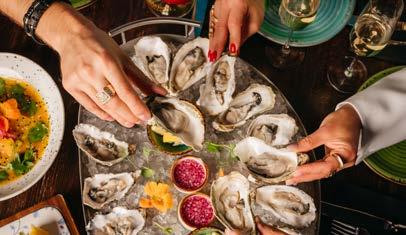
How to get to Browary Warszawskie?
Browary Warszawskie is located in Warsaw’s Wola district, between Grzybowska, Wronia and Krochmalna streets. Their official address is ul. Grzybowska 60. Parking is available and the area is easily accessible by tram, bus and metro. Find out more on www.browarywarszawskie.com.pl.
15
On the Town | Browary Warszawskie
Baila’s gastronomic fiesta! (p.91)
Traditional Polish Dishes
Polish food is famous for being simple, rich and very filling. Below we list the most well-known dishes you simply must try while in town, all of which you should be able to order from any Polish restaurant worth its salt. Smacznego!
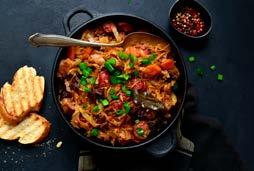
Barszcz
A nourishing beetroot soup, barszcz may be served with a croquette (‘barszcz z krokietem’), with miniature pierogi floating in it (‘barszcz z uszkami’), or simply as broth in a mug expressly for drinking. A recommended alternative to other beverages, we’d be surprised if you can find a bad cup of barszcz anywhere in Poland, so make sure you return home with barzszcz stains on at least one of your shirts.
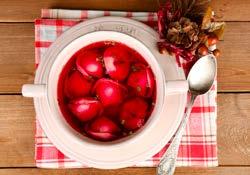
Bigos
Though there’s no standard recipe for this hearty stew, ingredients usually include fresh and pickled cabbage, sausage, onion, mushrooms, garlic, peppercorns, bay leaves, caraway and whatever else is on hand. In fact, metaphorically bigos translates to ‘big mess,’ ‘mish-mash’ or ‘confusion’ in Polish. A Polish restaurant or prospective bride can be fairly measured on the strength of their bigos, so put it to the test.
Gołąbki
Translating to ‘little pigeons,’ this favourite dish is like a ‘cabbage enchilada'. Consisting of boiled cabbage leaves filled with rice, onion and typically beef, gołąbki are rolled up and baked or steamed, then served with tomato or mushroom sauce. Polish legend claims that King Kazimierz IV fed his army gołąbki before the Battle of Grunwald, and their unlikely victory attributed to the fortifying meal ever since.

Golonka
This is ‘pork knuckle’ or ‘ham hock,’ as in the part of a pig’s leg between the knee and ankle. Boiled, braised or roasted, this is the closest the Poles come to barbecue, and is a delicacy. The meat should slip right off the bone, be served with horseradish, and washed down with beer. Generally sold by weight, you might end up with more than you bargained for, but it’s certainly an Instagram opportunity. Go caveman.
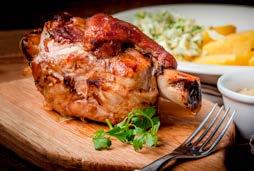
16
Kotlet Schabowy
Typically served with mashed potatoes and pickled cabbage, this is probably the most popular meal in Poland. Essentially a breaded and fried pork chop, ‘kotlet schabowy’ is quite similar to Viennese schnitzel, and a solid bet for a cheap, filling, risk-free meal. If you’re awoken on a weekend by the sound of profuse banging - that’s the sound of the meat being tenderised with a spiky mallet, so best mind your manners.
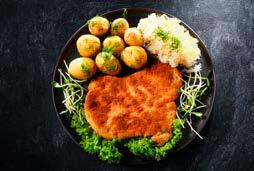
Pierogi

Poland’s most famous food, you can't leave PL until you’ve had them. These doughy, stuffed dumplings are typically steamed or pan-fried. Traditional fillings include potato, sweet cheese, minced meat, mushrooms and cabbage or seasonal fruits. If you nose around, you’ll find plenty of maverick fillings like chocolate, lentils or even chicken livers; the possibilities are limitless and served literally everywhere.
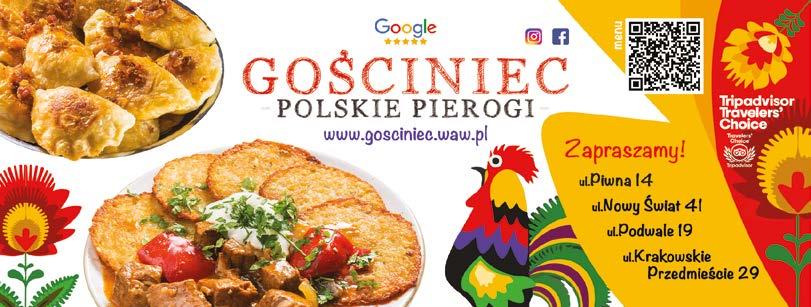
Placki Ziemniaczane
These greasy, fried potato pancakes are very similar to hashbrowns or Jewish latkes (if that means anything to you), and may be served in a variety of ways. Keep it simple with just sour cream (‘placki solo’), or turn it into a hefty meal by ordering them smothered in mushroom sauce or - our favourite - goulash (‘placki po węgiersku’). Highly caloric, they’re also a tried and true hangover cure.

Żurek
It doesn’t get any more Polish than żurek – a sour soup made from a thick stock of fermented rye flour. Typically chock full of potatoes, sausage and hard-boiled eggs, żurek is most often thickened with cream, and seasoned with marjoram, garlic, salt and pepper. The result is a tasty grayish gruel that any Polish peasant would be proud to polish off. If you’re lucky, you’ll even get it served in a bread bowl.
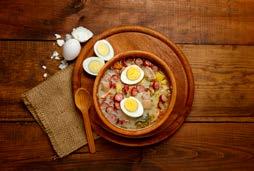
17
Transport
Travelling around Warsaw by bus, metro and tram is fast, efficient and affordable; driving a car through the centre, on the other hand, can be confusing and frustrating. As such, for visitors the city centre is best navigated by bike, scooter, public transport or taxi/ride share - all of which are explained here. For detailed info about Warsaw’s airports and train stations, visit our website.
Public Transport
Warsaw has an extensive bus and tram system, as well as a good metro system with the M1 line running north-south and M2 running east-west. Over 1,500 buses operate in and around the city, and run 05:00-23:00. After that night buses run on most routes twice every hour. All night buses display the letter N. ‘Fast buses’ (marked with red digits) skip the smaller stops.
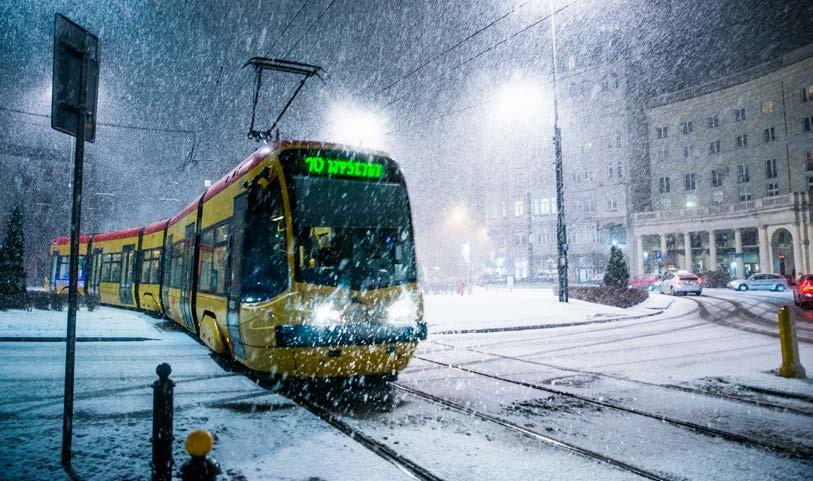
Standardised tickets are valid for use on the metro, buses and trams, and can be bought from machines with instructions in English at all metro stations, and some bus and tram stops. Tickets can also be purchased from machines on the actual buses and trams, where you can pay by card, or using exact change only.
A standard single fare costs 4.40zł, or 3.40zł for a 20min ticket. If you’re travelling to the further reaches of Warsaw you’ll need a 7zł ticket that covers both zones 1 and 2 (note that the airport
is still in Zone 1). Tickets valid for 24 hours, 3 days and a special ‘weekend’ ticket might also be worth considering. Those over 70 ride for free, as do children up until the end of September of the year they turn 7, but you must have photo ID (those who ride free still need a ticket/’wejściówka’ to get through the gates of the metro - find wall dispensers next to the gates and hang on to the ticket for multiple rides). Everyone else pays full fare, unless you have an ISIC card which entitles you to a reduced fare (‘ulgowy’ ticket).
Once you’re through the electronic gates of the metro, you’re ready to ride. For buses and trams, however, there’s one extra step - validating your ticket immediately once you’re on board in the small ‘kasownik’ boxes on trams and buses. Plain clothes ticket inspectors stalk the lines, dishing out hefty fines for those without valid tickets. They often don’t look very official and you are within your rights to request identification.Qwww.ztm.waw.pl
18
When the temperature drops, Warsaw’s trams will always carry you onward! Photo by icephotography / AdobeStock.
Car & Bike Share
Skutery Centrum Motor Scooter Rental
Due to Warsaw’s spread-out nature, getting around is definitely challenge we all have to confront, and renting a scooter (the motorbike kind, think Vespa) is certainly a more fun, stylish and convenient option than the bus, tram or searching for car parking. Skutery Centrum are located just minutes from the train station and offer a large selection of sporty and stylish rides, all of which can accommodate two people and come with two helmets. You don’t need a special license or instruction and you can rent a scooter for as few as 3hrs, by the week, or even buy one for keeps. In the off-season it’s best to book in advance and secure a pickup time as they might be out of the office (call the listed number).QG-8, ul. Żurawia 32/34, MCentrum, tel. (+48) 690 99 77 60, www.skutery-centrum.pl. Open 07:30-19:30.
Traficar Car Share
Want your own car, but just for a short while?
Download the Traficar app, find an empty vehicle, scan the QR code, and you’re in. You can leave the car in any legal parking space within their service zone, and you don’t have to pay for gas! Everything is done through their easy-to-use app. In terms of cost versus a taxi, it comes out about the same, but as an alternative to car rental, Traficar is a wonder. You can rent a vehicle for 24 hours for only 89zł and even drop it off in another city where Traficar operates. As such, this is a great option for day and weekend trips, big shopping trips, or simply picking up friends at the airport. Note that you need to have a valid driver’s license that is recognised in PL.Qwww.traficar.pl. Prices are calculated as 3.99zł to start a journey, plus 1.79zł/km; 0.15zł/min when parked (0.01/min 23:00-07:00).
Useful Transport Tools
Jakdojade
Warsaw’s public transit network is relatively easy to use, but the key to unlocking it is the warszawa. jakdojade.pl site and web app. Let the app access your location and it’ll determine the most efficient way to get to your destination - whether it be bus, tram, metro or train, which isn’t always obvioususing live data. A huge help for navigating your way around, you can also buy and validate tickets in the app.
E-podroznik.pl
This site can also help you get from point A to point B within Warsaw, but is really invaluable when it comes to planning the journey to your next destination, whether within Poland or abroad, by bus or train. Use e-podroznik.pl to easily search bus and train connections and timetables, compare prices and even buy tickets in one of seven languages. There’s also a free mobile app (Android only).
Ride Share & Taxis
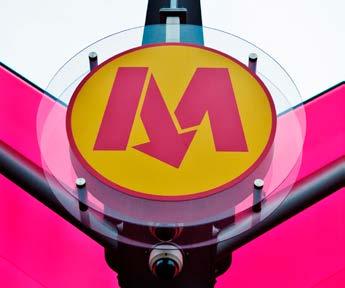
You’ll be happy to know that some of the ride share apps already on your phone will work in Warsaw, including Uber, Bolt and Free Now In fact, ride share services and taxi services are almost indistinguishable in the capital, with drivers typically operating on multiple platforms at the same time. Note, however, that ride share providers don’t have the same permissions as licensed cabbies and may not be able to take you as close to your destination, or get you there as directly. If you want to make sure you’re getting an actual taxi, try iTaxi (itaxi.pl), or call the Glob Cab Taxi at +48 1-9668 or +48 666 00 9668i.
Scooter Rental
Although agitating to some, electric motorised scooters are everywhere across Warsaw, and provide a cheap, easy, efficient and environmentally-friendly way to get around. To get started, you need an e-scooter app on your phone (create an account and add your personal data and payment details). The firms with the most current coverage in the capital are Lime, Bolt, Blinkee and CityBee. Spare yourself the wrath of locals by using your scooter responsibly; don’t ride through congested areas and when you’ve finished your ride, park it out of the way without blocking the sidewalk.
19 Transport
Keep an eye out for the Metro!
Warsaw Sightseeing
When it comes to Sightseeing, visitors should be sure to experience the dynamic synergy of Warsaw as a modern metropolis that still nurtures its cultural spirit and traditions. To this end, our guide details the capital’s most important districts, walking you through not only the antiquated Old Town (p.32), regal Royal Route (p.40) and the imperial beauty of Łazienki (p.50) and Wilanów (p.54), but also around the soaring, frenetic City Centre (p.22), happening Powiśle (p.46) and scruffy Praga (p.56). If your time is limited, however, here’s a cheat sheet of the city’s most unmissable sights.
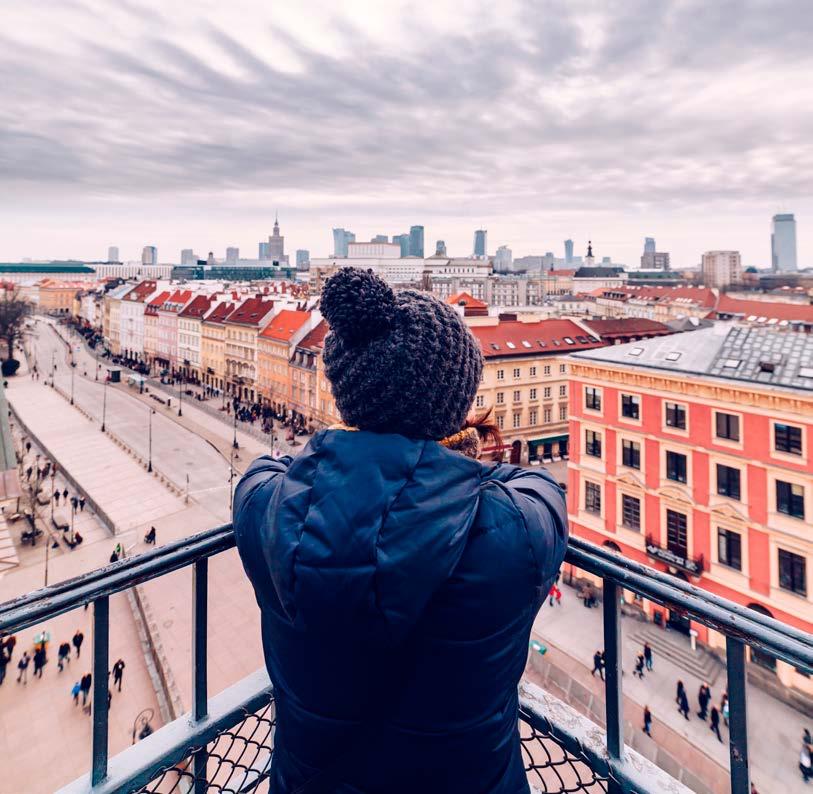
20
Think it looks gloomy now? You should have seen it in ‘44...
9 Essential Sights
1 Plac Zamkowy
More of a triangle than a square, and home to the Royal Castle, this popular plac is where modern Warsaw meets the Old Town.QSee p.33
2 Old Town Square
A window into the ‘once-upon-a-time’ of Warsaw’s golden days, the Old Town is also symbolic of Warsaw’s rise from the ruins of WWII.QSee p.36.
3 Vistula Boulevards
Warsaw’s left-bank boulevards are a favourite haunt of the locals - go and see why - walk, ride, or just chill on the riverside steps. Wow.QSee p.46.
4 Łazienki Park
Full of incredible art and architecture this massive park and palace complex offers spectacular opportunities for sightseeing or simply relaxing.QSee p.50
9 Skyfall Warsaw
When visitors to Warsaw seek out the best views in the city, they instinctively head to the Palace of Culture & Science, a common point on the tourist map. However, there is another option that far exceeds the scope of what the Palace has to offer....
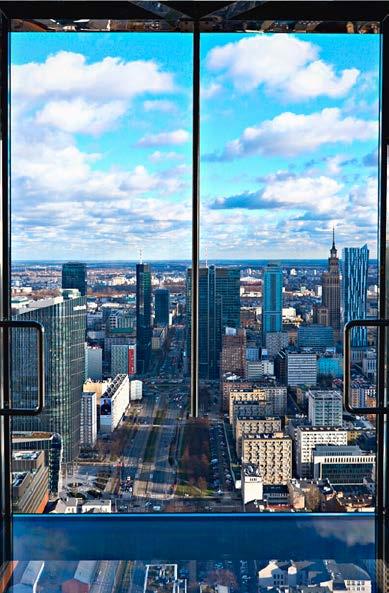
Located in the burgeoning Wola district to the west of the City Centre and Old Town skyline, Warsaw UNIT (p.30) is the Polish capital’s 5th tallest building, clocking in at an impressive 202 meters. It is here on the 46th floor that Skyfall Warsaw keeps a watchfull eye over the Polish capital. At 200 metres above sea-level, this is one of the highest observation decks in Poland, and, unlike the afore-mentioned Palace, its eastwardlooking panorama gives you all of Warsaw’s major landmarks in one breathtaking gaze. Even more phenomenal is the glazed, four-person observation deck, providing visitors with the heart-racing experience of floating above the clouds. Head along to the Skyfall Warsaw website and start planning your visit today!
QC-8, rondo Daszyńskiego 1, MRondo Daszyńskiego, tel. (+48) 798 08 33 21, www.skyfallwarsaw.com Skybar (the bar inside Skyfall) is only open for events.
5 Wilanów Palace
The ‘Polish Versailles’ is just one of the many fitting monikers applied to this splendid late 17thcentury royal palace 10km to the south.QSee p.54
6 POLIN Museum
1000 years of Jewish history in Poland is chronicled in this excellent museum where the Jewish Ghetto stood during WWII.QSee p.67.
7 Palace of Culture & Science
Stalin’s ‘gift from the Soviet people’ has been controversial ever since its construction. Head up for fabulous 237 metre-high views!QSee p. 26.
8 Warsaw Rising Museum
Chronicling the heroism and tragedy of the 1944 Warsaw Uprising, this modern museum packed with multimedia displays is one of the best in PL.QSee p.69
21 Sightseeing | Essential Warsaw
TH
Warsaw ‘City Centre’
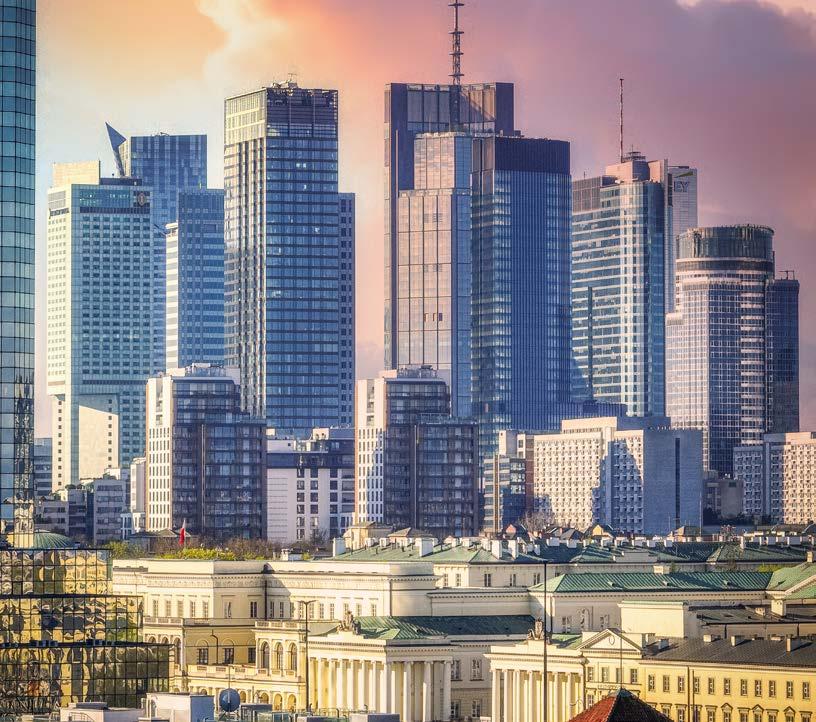
Known locally as ‘Śródmieście,’ Warsaw’s City Centre isn’t exactly a district (it comprises several, actually), but more of a catch-all term for the downtown area. Definitions vary, but generally, you know it when you’re in it - wide streets, monumental buildings, billboards, busy crosswalks and little to stand in the way of progress. It’s the modern, fast-paced, forwardlooking part of the city radiating out from the Palace of Culture & Science, and it’s here that you’ll find the majority of the city’s hotels, restaurants and bars, but also government buildings, skyscrapers and places of commerce - the dynamic heart of the contemporary capital.
In terms of tourism, it’s not exactly inviting, so why start here? Well, you’re already in it, aren’t you? Chances are you’re staying in the City Centre, so let’s get familiar with what’s around before running off to the Old Town (p.32), shall we? Despite not being particularly cosy or nostalgic, there are still many points of interest and nowhere more conveys the modern character of the Polish capital.
22
Follow us as we help you find the hay in this needlestack, Photo by @alexsnapscolours.
23 Sightseeing | Warsaw City Centre 11 10 9 8 7 6 5 4 11 10 9 8 7 6 5 4 B C D E F G B C D E F G Warszawa Centralna Warszawa Śródmieście Warszawa Śródmieście Warszawa Główna Warszawa Ochota Ratusz Arsenał M2 Politechnika Nowy Świat-Uniwersytet Rondo Daszyńskiego Rondo ONZ Świętokrzyska M1 M1 Centrum LESZNO NIEMCEWICZA TOWAROWA WAWELSKA GRÓJECKA
TOWAROWA K R Z Y C K I E G O PROSTA GEN . AND E RSA AL . JANA PAWŁA II AL.JEROZOLIMSKIE MARSZAŁKOWSKA AL . ARMII LUDOWEJ MARSZAŁKOWSKA W A R Y Ń S K I E G O AL. JANA PAWŁAII
AL. "SOLIDARNOŚCI" CHAŁUBIŃSKIEGO AL. NIEPODLEGŁOŚCI WAWELSKA AL. JANA PAWŁA II RASZYŃSKA Żytnia Dzielna Pawia Wolność Kacza E s perant o Niska P r z y o k o p o w a Chłodna Słupecka Miła K al i s k a Bellotti e go Gliniana Grzybowska Spiska Akademicka Łucka W r oni a Mianowskieg o Niemcewicza Pawia Nowolipie TarczyńskaDaleka Anielewicza Asnyka Miła Ogrodowa Smocza Platynowa Reja Krochmalna Miedziana Pawia Srebrna Dzielna Biał a Elektoralna Waliców Twarda Nowolipki Nowolipki Karmelick a Pereca Filtrowa Chmielna Nowolipie Pawia Dantyszka Złota Ciepła Twarda Żelazna Żelazna Żelazna Zamenhofa Łęczycka Śliska Lind l e ya Sienna Pl Mirowski C i e pł a Pańska Al.Drzewieckiego Oczki Orla Twarda K r z y w i c k i e g o Pańska Langiewicza Ptasia Nowowiejska Śliska Przec h o d n i a Sienna Graniczn a Corazziego Świętokrzyska Świętokrzyska Pl.Grzy bows k i Próżna Bagno Pl.Krasińskich Hoża Hoża Bielańska Emi l i i Plater Emi l i i Plater Świętojerska Zielna Wilcza Wilcza Schillera Canaletta Królewska Długa Noakowskiego Rysia Bulw.Karskiego Kredytowa Wierzbowa Podwale Fredry Moniuszki Sienkiewicza Senatorska Złota Nowogrodzka Piękna Żurawia Piwna Moliera Jasna Widok Chmielna Poznańsk a Boduena Foch a Lwowska Mazowi eck a Śniadeckich Nowogrodzka Kozi a Zgoda Traugutta Wspólna Park i n gowa Polna S z pitalna G r o dzka Czack i e go Górskiego Chmielna Karowa Bracka Warecka Mariensztat KrakowskiePrzedmieści e Polna Nowy Ś wiat Furmańska Krucza Marszałk owsk a Barokowa B u gaj R ycerska Miodowa Smocza Anielewicza Senatorska ŚwBarbary Piękna Nowowiejska Koszykowa Mochnackiego G l o g e r a Grzybowska Koszykowa Nowogrodzka Wspólna Filtrowa Krochmalna Pl.Bankowy Nalewki Bednarska Barska Kolejowa Nowy Zjazd Kotlarska UniwersyteckaSupińskiego Wronia Wronia G ó r n i c k i e g o A l . W i e l k o p o l s k i Ciepła P l . S t a r y n k i e w i c z a R u d a w s k a S o l a r i e g o Zimna Trybunalska Mariańsk a R e f e r e n d a r ks a S ę d z i o w s k a Lekarska Daniłowiczowska L e k a r s k a Niecała Kapucyńska Szkolna Pl.Teatralny Kapitulna R e ktor s k a Bursch e go Świętojańska Nowowiejska Trębacka P o d o s kich Ossolińskich Dowcip Hoovera Grabowsk i e go Jaworzyńska Skorupki Puchatk a Tuwima Oleandrów Sowi a Wierzbickiego Złote Tarasy Palace of Culture & Science Pl. Konstytucji Pl. Powstańców Warszawy Plac Defilad Pl. Zbawiciela RKS Skra Plac Europejski Warsaw Water Filters Warsaw University of Technology ROYAL ROUTE Most Mokotów Field Saxon Garden Ogród Krasińskich Maria Skłodowska-Curie Park Fabryka Norblina Hilton The Westin Ibis Centrum MDM Leonardo Royal Hotel Radisson Blu Sobieski Hotel Atlas Tower Dom Mody KLIF VITKAC A Footbridge of Memory Ghetto Wall Fragment Pawiak Prison Warsaw University Marriott Mercure Grand InterContinental Harenda Gromada Mercure Centrum Zlota 44 Bristol Sofitel Mazowiecki Hala Koszyki Bellotto Presidential Palace Holiday Inn Wola Museum Railway Museum Museum of John Paul II Warsaw City Hall Nożyk Synagogue St. Carlo Borromeo Church POLIN 'Kniefall' Monument Ghetto Heroes Monument Monte Cassino Monument The Armoury Jewish Historical Institute St. Augustines Church Tadeusz Kościuszko Tomb of the Unknown Soldier Cross-monument Piłsudski Ethnographic Copernicus Janusz Korczak Aviator Monument National Opera Warsaw Chamber Opera National Philharmonic Photoplasticon Nike Poniatowski Holy Cross Zachęta Hala Gwardii Hala Mirowska All Saints' Church The Music Theatre ROMA Teatr Kwadrat Capitol Theatre Raffles Europejski Smoleńsk Air Disaster Monument Hampton by Hilton Ibis Styles Warsaw Rising Museum Warsaw Spire Warsaw UNIT Warsaw Hub Teatro PURO Radisson Collection Hotel NYX Varso NOBU Crowne Plaza Holiday Inn Express Browary Warszawskie Museum of Life under Communism Verte © OpenStreetMap contributors. Available under the Open Database License. WARSAW CENTRE 1 cm = 190 m Scale 1:19 000 0 200 400 m 13 2 5 12 8 9 10 1 4 3 6 11 7
AL.JEROZOLIMSKIE
AL."SOLIDARNOŚCI"
Places to Explore
1 Plac Piłsudskiego
Used over the centuries for military parades and national celebrations, this is Warsaw’s largest square Named after legendary inter-war Polish leader, Józef Piłsudski (p.12), you’ll find a statue of the Marshal guarding his naming rights with a stern gaze nearby. That’s because the space has undergone quite a few rebrandings thanks to the changing political landscape, including a stint as ‘Adolf Hitler Platz’ under Nazi occupation. During the era of Partitions, the huge orthodox St. Nevsky Cathedral was built here; considered a symbol of Russian oppression, it was razed after Poland regained its independence. It was here too that in 1979, the newly appointed Polish Pope John Paul II gave an open-air holy mass to 500,000 people, instilling hope in the struggle against the repressive communist system. In 2018, two new monuments were added - both relating to the tragic and highly politicised Smoleńsk Air Disaster in which a plane carrying 96 members of a Polish government delegation crashed in the Russian forest in 2010; everyone on board perished, including President Lech Kaczyński, whose monument here gazes upon that of the other victims.
At the western end of the square you’ll find the Tomb of the Unknown Soldier under the broken colonnades of Saxon Palace - the grand structure this square stood in front of until its destruction during WWII. Here the ashes of unidentified soldiers who died for the Polish cause are interred and an eternal flame is guarded by stone-faced soldiers. If you enjoy a bit of military theatre, you can watch the official changing of the guard every hour, on the hour, 365 days a year.QF-6, Plac Piłsudskiego, MNowy ŚwiatUniwersytet.
2 Saxon Garden
Plac Piłsudskiego’s Tomb of the Unknown Soldier almost serves as an entrance gate into Saski Park, aka Saxon Garden. This historic 15.5ha park is the oldest in the city, and became one of the first public parks in the world when it opened to all in 1727. At that time it was a Baroque garden with the grandiose Saxon Palace playing a role very similar to the Palace of Versailles in Paris’ famous park. Despite its demise during WWI, Saxon Garden still offers several historical points of interest, in addition to lots of benches, plenty of shade and a much-needed escape from the urban din of the capital. The centrepiece of the gardens is a large fountain created in 1855 by renowned Warsaw architect Henryk Marconi. The alleyways running out from it are lined with blooming flowers, ancient trees and neoclassical sculptures. In the northwestern part of the park, you’ll find the Romanesque Water Tower from 1825 - also designed by Marconi, and modelled on the famous Temple of Vesta in Tivoli. Other curiosities include a sundial from 1863, a memorial honouring Varsovians killed during WWII, and a statue of Stefan Starzyński - the city’s mayor at the outbreak of WWII, who later to became a victim of Dachau concentration camp. It’s also worth noting the beautiful Renaissance palace on the southern side of the park, which holds Zachęta - Warsaw’s premier space for contemporary art (p.64).QF-6, Between ul. Marszałkowska and Plac Piłsudskiego, MŚwiętokrzyska.

3 Hala Mirowska & Hala Gwardii
Major Warsaw landmarks, these two massive brick market halls were constructed between 1899 and 1901 on the instruction of Russian mayor Nikolai Bibikov. Together they functioned as Warsaw’s largest market up until the outbreak of the Warsaw Uprising. Though ravaged by fire, the buildings survivedcheck out the bullet scars still visible on the corner of Pl. Mirowski and Jana Pawła II. A bus depot in the post-war years, Hala Mirowska resumed its original purpose in the 1950s and a visit today feels a bit like a trip back to those days, thanks to the outmoded shops full of cheap goods and lines of country folk selling jars of mushrooms out of their vans. The outdoor produce market is absolutely worth it, however, and full of fresh greens coming in from the countryside. Meanwhile, Hala Gwardii (open Fri-Sun only), has been turned into a trendy food hall (p.87), though it’s a bit grittier than the capital’s similar enterprises. The dichotomy is unique as this place strains to modernise, but stays true to its roots.QD-6, Pl. Mirowski 1, MRondo ONZ. Open 07:00-18:00; Sat 07:00-15:00; closed Sun.
24 Warsaw City Centre | Sightseeing
Tomb of the Unknown Soldier Photo by Tetiana Ivanova
4 Browary Warszawskie



Once one of Central Europe’s most famous brewing complexes, this 4.5ha area has been revitalised into a trendy urban culture and gastronomy district, densely packed with dozens of restaurants, cafes, bakeries, delicatessens and shops. Mixing bold new architecture with restored historical buildings, postindustrial design with public green spaces, the heart of this ‘city within the city’ is Food Hall Browary contemporary gastro concepts in the former brewery cellars (p.86). The historic Browar Warszawski (Warsaw Brewery, p.78) itself has also been revived and is once again producing craft beers (19 different types!) for local hopheads. Other highlights include a sports bar part owned by Robert Lewandowski (Nine’s) and dinner entertainment at & Dining. Check online for events, especially for seasonal specialties (p.14) - there’s always something brewing at Browary!QC-7, ul. Grzybowska 60, MRondo Daszyńskiego, www.browarywarszawskie. com.pl
5 Plac Europejski & Warsaw Spire
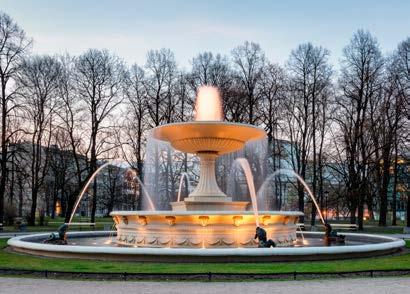
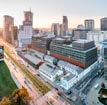
One Warsaw’s newest public social spaces, European Square was created by Wirtz International Landscape Architecture as part of the development of the impressive Warsaw Spire - Poland’s 3rd-tallest skyscraper at 220m. Both the square and the office building have won awards from industry authorities and local residents for their design. Located just a short distance from the ‘Rondo Daszyńskiego’ metro station, the small square has a lot of features: trees, benches, fountains, reflecting pools, two large murals, an amphitheatre, a unique Art Walk gallery where changing exhibits are displayed, and an iconic 3D Instagram-baiting installation that says ‘Kocham Warszawę’ (I Love Warsaw). What’s more,
more info & tickets at ww.smartkidsplanet.pl





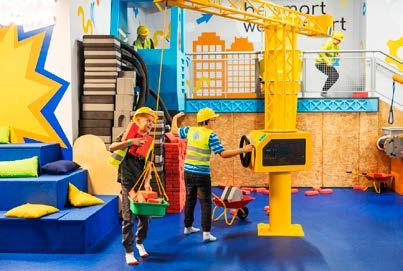
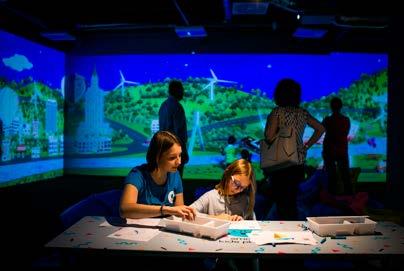
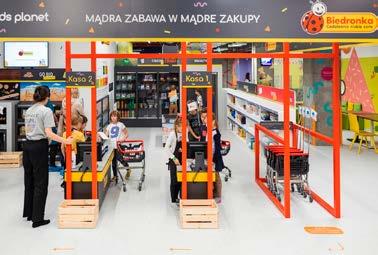
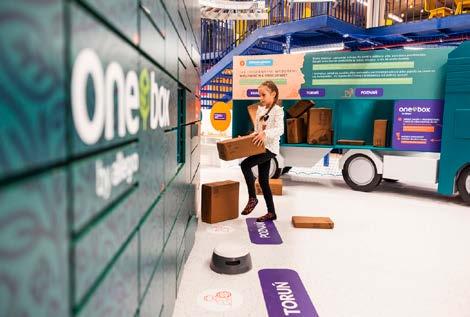
25 Sightseeing | Warsaw City Centre
Smart Partners Partners Media Partners: e d u t a i n m e n t z o n e s Get ready for a fun-packed family day out! F i n d u s a t W a r s a w N o r b l i n F a c t o r y smartkidsplanet pl SmartKidsPlanet
Brand new attraction for children in Warsaw!
"This
place will take children on a journey to a small planet of great explorers A world of limitless imagination, cosmic adventures and sporting excitement " Anna Lewandowska - IG @annalewandowska
Marconi Fountain in Saxon Garden. Photo by tichr
there’s something happening year-round, including concerts, film screenings, frequent live sports transmissions and an ice rink in winter. Of course there are cafes, bars and food options as well, making this a very unique and worthwhile place to hang out in Warsaw’s business district.QC-7, Plac Europejski, MRondo Daszyńskiego.
6 Fabryka Norblina
The latest of several highly successful urban renewal projects in Warsaw, arguably the most diverse and exciting, and, without a doubt, the most rewarded! This former industrial site covering an area of 2ha near Rondo Daszyńskiego was once one of the largest enterprises in the Kingdom of Poland, with a long, complex history that dates back to the 1840s. The Norblin, Buch Brothers and T. Werner Factory (to give its full name) produced a wide range of metal, tin and silver-plated goods - sugar bowls, teapots, cutlery, vases, dishes and more - ranging from the utilitarian to true works of art. Until recently a neglected pearl of post-industrial architecture, massive investment has turned the area into a lively modern urban centre of culture, entertainment, gastronomy and commerce. Over 24,000m2 of total commercial space open to the public, visitors
will find an impressive museum covering the site’s industrial history - including exhibits of unique plated goods and historical machinery, the Apple Museum Poland (p.62) with the largest collection of Apple computer products in the world, the BioBazar eco (organic) food market and bistro, the KinoGram boutique cinema, ArtBox Experience, a fitness centre, shops, cafes and more - including a bevy of events. To top it all off, a trendy indoor Food Town (p.86) lives at the heart of the space, with 23 gastronomy concepts from around the globe, and 5 bars to add to the service! Additionally, Hala Gimlet, is an everyday live music space, featuring bands, DJs and jazz sessions. Young families should also take note of Smart Kids Planet (p.73), an educational play center for young children to partake in the fun. This truly is the astounding cutting edge of Warsaw’s urban culture, so check it out.QC/D-8, ul. Żelazna 51/53, MRondo Daszyńskiego, www.fabrykanorblina. pl.
7
Plac Grzybowski
This delightful square connects the city’s past to its present and unites the worlds of commerce, religion, entertainment and art. The main attraction is the 19th century Renaissance All Saints’ Church. From 1941 it was inside the Warsaw Ghetto and Parish Priest Fr. Monsignor Marceli Godlewski helped to house Jews in the rectory and assisted several to escape. Rebuilt after the war, the entire square has been recently renovated and today features dozens of benches, neatly landscaped grassy areas and even a pond with a waterfall. Very well lit, it’s a wonderful place to relax or enjoy the many bars and cafes that surround it, day or night. Joining the square is ul. Próżna, the only full street that survived the Jewish Ghetto. It remained derelict, however, in recent years, one side was restored to its pre-war splendour, while the second side awaits revival. It is here in the former heart of the Jewish Warsaw (p.66) that the Singer Jewish Culture Festival takes place each year in late August/early September. The Nożyk Synagogue - the city’s only synagogue to survive the war and still in use today - can also be found close by at ul. Twarda 6.QE-7, MŚwiętokrzyska.
8
Palace of Culture & Science
Originally commissioned by Stalin as a ‘gift from the Soviet people’, this 237-metre-high structure was Warsaw’s tallest building until 2021, and takes its inspiration from the capitalist world - namely the Empire State Building. Working around the clock, it took over 5,000 workers - ferried in from the Soviet states and housed in a purpose-built village - just three years to finish the Palace in 1955. With 3,288
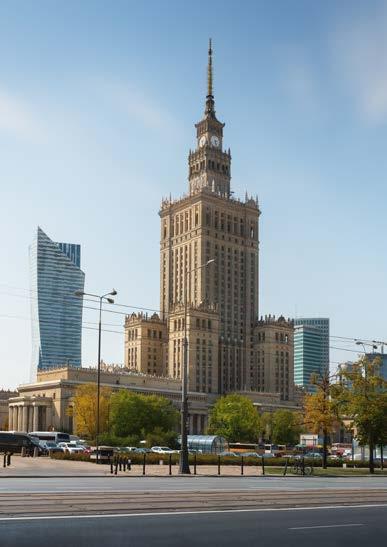
26 Warsaw City Centre | Sightseeing
TE6
The iconic Palace of Culture & Science is controversial amongst locals, due to its association with Poland’s communist era.
rooms inside, the Palace’s purpose was to serve as not just Communist Party headquarters but also as ‘The People’s Castle.’ Now an iconic part of Warsaw’s landscape, the Palace is celebrated by some, while for others it merely represents Russian hegemony At present the building hosts several theatres, a cinema, bars, restaurants and cafes, and a tourist info office, as well as the Museum of Technology and the Museum of Evolution. Head straight to the outdoor viewing terrace on the 30th floor (via elevator) for thrilling panoramic views; tickets available online.
QE-8, Pl. Defilad 1, MCentrum, tel. (+48) 22 656 76 00, www.pkin.pl. Open 10:00-18:00. Viewing terrace open 10:00-20:00; terrace admission 25/20zł. U


9 Pasaż Wiecha
Like the trough behind a cresting wave, this ‘passage’ runs parallel to ul. Marszakowska in the shadow of the Wars Sawa Junior departments stores, otherwise know as the ‘Eastern Wall.’ One of the most monstrous projects completed in communist Warsaw, this massive wall of buildings is among the oldest department store/retail complexes in Poland, a role it still plays today. Designed by architect Zbigniew Karpiński and completed in 1969, the buildings were hailed a work of genius, but soon fell into neglect, their reputation changing to that of an enormous eyesore covered in advertising in the early postcommunist era. In more recent times, the buildings have been modernised with shining glass frontages, granite walkways and proper lighting. Although once entirely dodgy, Pasaż Wiecha - the long space behind the ‘Eastern Wall’ - is today lined with shops and restaurant gardens on both sides, making it an interesting area to explore. It also boasts benches, hammocks, beach chairs and other elements of urban design, and increasingly plays host to events like food fairs. Ironically, the centrepiece of the city’s big 1960s

27 Sightseeing | Warsaw City Centre
Plac Grzybowski.
Photo by stompi_stompi
redevelopment plan is now a focal point in the ‘Nowe Centrum Warszawy’ plan, which will see this immediate area redeveloped once again in the near future, becoming more green and user-friendly for residents. It’s all part of a bigger plan to create a lively pedestrian corridor through the city centre running from here, down ul. Chmielna, through the new Plac Pięciu Rogów, to ul. Nowy Świat. Start a wander east down ul. Chmielna from here to see how far the city has progressed and succeeded so far.QF-7/8, Pasaż Stefana Wiecheckiego Wiecha, MCentrum.
10 Plac Pięciu Rogów & ul. Chmielna
Warsaw’s newest public square opened in July 2022 at the intersection of Bracka, Krucza, Zgody, Szpitalna and Chmielna Streets (hence the name ‘Five Corner Square’ in English) Although the new design still features a lot of concrete, 22 tall maple trees have been added to the space, as well of numerous benches with almost 40 sitting places. Most significantly, the entire area has been opened up and given over to pedestrians, which is a huge improvement over the urban tangle that previously prevailed here. The redevelopment of this area have reduced traffic and parking spaces, widened sidewalks, added greenery, and have transformed ul. Chmielna into a high street for pedestrians connecting ul. Nowy Świat and the Royal Route (p.40) to the Palace of Science and Culture (p.26). A great area for exploration, on and around the square you’ll plenty of cool cafes, restaurants, bars and intriguing places for relaxing and refuelling.QG-7/8, Intersection of ul. Bracka, Krucza, Zgody, Szpitalna and Chmielna, MCentrum, www.plac5rogow.pl.
11 Plac Zbawiciela
Like Plac Konstytucji, after the war this star-shaped roundabout became dominated by PRL-era buildings from the 1950s, but still harbours a couple gems. The first is the conspicuous neo-Renaissance style
Church of the Holiest Saviour, from which the square takes its name (‘Saviour Square’ in English). The fact that is still standing is a marvel, considering it was dynamited by the Nazis during WWII and then tagged for demolition by the communists. The other pre-war building here is the handsome Jasieńczyk-Jabłoński tenement (Mokotowska 12). Erected in 1910, it was the tallest residential building in Warsaw (38 m) at the time. The square was famous for Julita Wójcik’s “Rainbow” art installation which soared over Plac Zbawiciela between 2012 and 2015. Unfortunately, it was removed due to numerous attempts to burn it down. Despite that, Saviour Square today is quite the progressive meeting place for students, artists and activists who favour the hip bars here like Plan B (Al. Wyzwolenia 18) and Charlotte (Al. Wyzwolenia 18/2U). QG-10, Plac Zbawiciela, MPolitechnika.

12 Warsaw University of Technology
The historic main building of what’s known locally as Politechnika Warszawska is an absolute wonder of neo-baroque architecture designed by Stefan Szyller at the turn of the 18/19th centuries. This stout, sturdy two-story building with its unique rounded corners has survived numerous wars and political upheavals. The university as an institution was officially established in 1826 during the Russian occupation of Polish territory. Many of its students were involved in various uprisings throughout the 19th century, which resulted in the Russians banning the Polish as the language in instruction. This was just one of many reasons that young intellectuals of the time moved abroad to pursue an education. Ironically it was Germany who allowed the ban to be lifted after pushed the Russians out of Warsaw in 1915. Surviving the devastation of WWII, and the challenges of communism, today it’s one of the largest technology universities in Central Europe, with over 36,000 students per year. If you’re wondering where they are, no doubt many of them are hanging out in Hala Koszyki! QF-10, Plac Politechniki 1, MPolitechnika. Open 07:00-18:00.
13 Hala Koszyki
One of Warsaw’s absolutely awesome indoor food halls, only a five minute walk from here. More on p.87. Its magnificent facade features an array of cool architectural embellishments: sculptures, bas-reliefs, frescoes and sgraffito, to name a few. If you think the exterior is impressive, move inside and admire the pentagonal cloister courtyard with its four stories of arcades, phenomenal staircase and beautiful stainedglass roof - one of the most-photogenic places in Warsaw! QF-10, ul. Koszykowa 63, MPolitechnika, www.koszyki.com. Open 08:00-01:00.
28 Warsaw City Centre | Sightseeing
C M Y CM MY CY CMY K
Plac Zbawiciela
NORBLIN FACTORY, WHERE WARSAW PLAYS 7 DAYS A WEEK. DON’T MISS IT.
29 Sightseeing | Warsaw City Centre
S k y s c r a p e r s
& Viewpoints
Warsaw has plainly stated its ambition to have more skyscrapers than any other city in Europe. The city currently has 25 buildings over 100m high, with another 10 approved for construction, and enough pending approval to potentially bring the total up to 65 in the coming years. Beloved by locals and symbolic of the city’s aspiration to be the most modern capital in Europe, here are some of the most notable towers in town.
Varso: Nearly complete, this is the tallest building in the EU at 310m (though the last 80m is a spire).QE-8.
Palace of Culture & Science: Buy a ticket, then head up to the 30th floor of Warsaw’s oldest and second tallest skyscraper (237m) for amazing panoramic views from an actual open-air terrace. More on p.26 QE-9.
Warsaw UNIT: Warsaw’s 5th tallest tower (202m) was completed in 2021. Opening soon on the 46th floor will be a Skybar and the wild new adrenaline attraction Skyfall Warsaw - a vertigo-inducing glass box that dangles outside the building and suddenly tilts 15 degrees forward!QC-8.
Złota 44: Designed by Daniel Libeskind, this luxury residential tower is one of Wawa’s most beautiful and distinctive skyscrapers, as well as its 7th tallest (192m). QE-8.
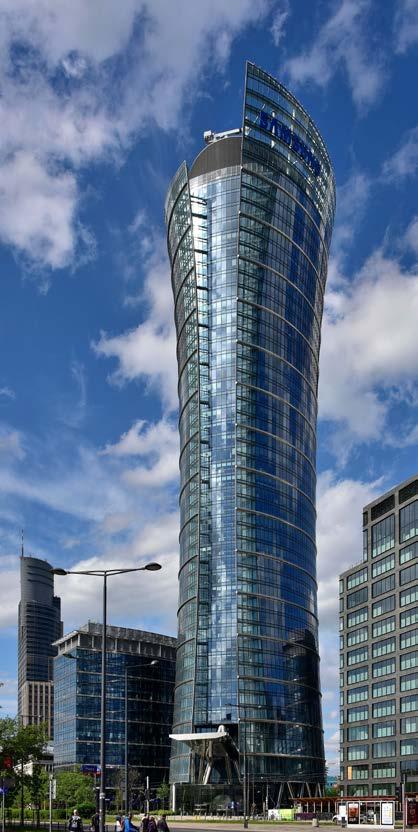
InterContinental Hotel: At 165m, Warsaw’s InterContinental Hotel is one of the tallest 5-star hotels in the world, and features the highest swimming pool in Europe at 150m. Open to non-guests, go have a swim in the clouds.QE-8.
Centrum LIM/The Marriott: The Marriott’s Panorama Sky Bar on the 40th floor of this veteran skyscraper (completed 1989) offers a liquid view to the city. Although the drinks are among Wawa’s most expensive, this is one of the city’s most accessible views.QE-9.
The HUB Warsaw: Completed in 2020, this complex consists of two 130m buildings and an 86m building. For great views head to 21st floor Crowne Plaza Roof Bar QC-8.
Atlas Tower: 119m tall and completed way back in 1999, the locals think this one looks like a porta-loo, but the 27th floor features one of the best luxury roof clubs in the world, Level 27 (see p.93). The building is also home to the Invisible Exhibition (p.63).QE-9.
30 Warsaw City Centre | Sightseeing
Warsaw Spire - PL’s 3rd-tallest skyscraper (p.25). Photo by Adrian Grycuk.

C h a n g e y o u r p e r s p e c t i v e . w w w . s k y f a l l w a r s a w . c o m J o y , h a p p i n e s s , a d r e n a l i n e , e x c i t e m e n t … W h a t w i l l y o u f e e l o n t h e 4 6 t h f l o o r ? R o n d o D a s z y ń s k i e g o 1 7 9 8 - 6 8 3 - 3 2 1 c o n t a c t @ s k y f a l l w a r s a w c o m
The Old Town
A labyrinth of winding cobblestone streets, ornate tenement facades and picturesque plazas, it’s easy to understand why the Old Town is Warsaw’s top tourist area. A window into the ‘once-upon-a-time’ when Warsaw was a pearl of European architecture, the Old Town was actually entirely rebuilt after WWII. Today it stands as a stunning testament of Varsovians’ great pride in their city, and its rise from the ruins. If you have only one day in Warsaw, you should spend part of it here.
In the devastating aftermath of the Warsaw Uprising (p. 68 ), 85% of the city’s left bank lay in ruin, half of its population had perished, and the Old Town was a smouldering wasteland. To their credit the Capital Reconstruction Bureau immediately started rebuilding the historic centre using pre-war sketches, paintings and photographs. The first phase of reconstruction was completed in 1953, but works continued in the following decades, finally concluding with the opening of the Royal Castle in 1984. Although what you see today is not strictly ‘original’ per say, its inclusion on the UNESCO World Heritage List speaks volumes of its authenticity and the effort required to recreate it.
WALKING TOUR
IYP’s Old Town Walking Tour leads you in and around the oldest part of the city, showing you its most important and interesting points, beginning and ending near Plac Zamkowy (Castle Square) - the traditional entrance to the district. The prescribed route covers only about 1.5km. If you’re only interested in the exercise, it could take less than 30mins, but we reckon for most, an exploration of Warsaw’s Old Town will take several hours ‘if done correctly’ - that is, with a couple of short culture, food and coffee/beer breaks. Make sure you’ve got a full charge on your smartphone or camera, some comfy shoes and off you go.

32
Plac Zamkowy in Warsaw Old Town. Photo by bbsferrari.
1 Plac Zamkowy
Most visits to the Old Town begin on Plac Zamkowy (Castle Square), the busy plaza where Warsaw’s medieval centre (to the north), meets the thoroughfare of its Royal Route (to the south), in the shadow of the Royal Castle More of a triangle than a square, there isn’t a more popular meeting place in the city, and not a minute of the day when the steps of King Sigismund’s Column aren’t besieged by dating couples, schoolkids and skateboarders. A lot happens here, whether it’s a steady flow of locals and tourists out for a stroll, political demonstrations or street performers plying their trade. As for the famous column, it honours the man who in 1596 moved the Polish capital from Kraków to Warsaw - King Sigismund III Vasa 22 metres tall, it was erected in 1664 by his son, Władysław IV. Local legend asserts that Sigismund rattles his sabre whenever Warsaw is in trouble, an occurrence first reported during the 1794 Kościuszko Uprising and again during WWII. With the Warsaw Uprising in full swing the column took a direct hit from a tank shell and came crashing down. Amazingly Sigismund survived, losing only his sword, and was returned to his new perch in 1949. The remains of the original column can be seen nearby beside the Royal Castle. Also note that there is a tourist information office located here at number 1/13 (open everyday 10:0016:00).QF-4, Plac Zamkowy, MRatusz Arsenał.
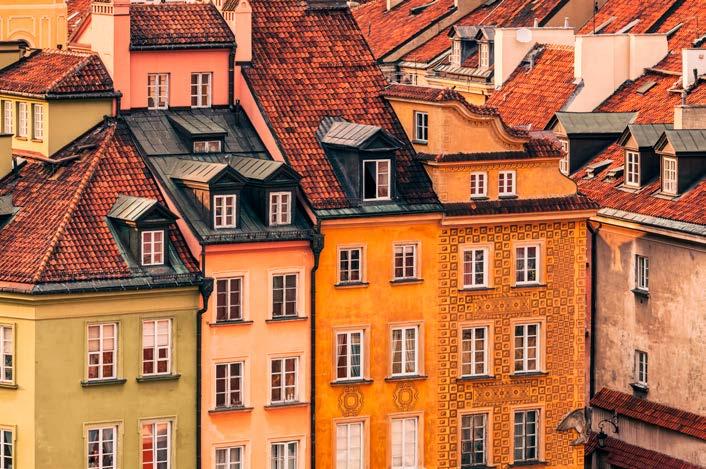
33 Sightseeing | Old Town Walking Tour MARIENSZTAT OLD TOWN NEW TOWN WYB .GDAŃSKIE AL. "SOLIDARNOŚCI" Ciasna Freta Kilińskiego Długa Freta Miodowa Nowy Przejazd Mostowa Kapitulna WąskiDunaj Senatorska Rycerska Nowomiejska Brzozowa Bugaj Boleść Świętojańska Kozi a Celna Wodna Nowy Zjazd Podwale Podwale Piwna Krak . Przedmieści e Daniłowiczowska Stara BulwarKarskiego Sch i llera Piekarska Jezuicka Kapucyńska Bednarska Grodzka Dziekania KrzyweKoł o Plac Zamkowy Barbican P&O Stara Prochoffnia Bellotto Castle Inn Dom Literatury St. Anne's St. Hyacinth King Sigismund's Column Nike Asia and Pacific Museum of Caricature Royal Castle Maria Skłodowska Curie Museum Pharmacy Archdiocese Museum Museum of Dollhouses, Games & Toys Church of the Holy Spirit World of Illusion Syrenka Museum of Literature Heritage Centre Jesuit Church St. Martin's Verte 2 3 11 8 4 7 9 10 6 1 5
Some of the colourfully-reconstructed buildings on Plac Zamkowy in Warsaw Old Town. Photo by Marcus Lindstrom / Canva Pro
2 Royal Castle
Once again the pride of Warsaw, this palace was reconstructed from a pile of rubble at incredible cost between 1971 and 1984. Much of the furniture was donated by communist-era cohorts such as the GDR and USSR, and much of the money came via generous donations from exiled Poles. Dating back to the 14th century, the castle has been the residence of Polish kings, presidents and the seat of Parliament. Some of the halls are purported to be haunted by a ‘white lady,’ whose ghostly appearance portends disaster.
Those who plonk down for admission will have plenty to see, beginning with the Kings’ apartments and chambers, heavily adorned with paintings of famous Polish moments and maps from the days when the kingdom stretched from the Baltic to the Black Sea. The apartments of Prince Józef Poniatowski (aka the ‘Tin-Roofed Palace’) are also open to the public, though a separate ticket is required (20/15zł, open Wed, Sat, Sun only), and a chapel boasts an urn containing the heart of Polish hero and freedom fighter Tadeusz Kościuszko. The Houses of Parliament can also be seen, as can the opulent Great Assembly Hall. The free basement exhibition ‘From Destruction to Reconstruction’ details the castle’s resurrection after WWII rendered the place a pile of rubble, while the east-wing also contains the Gallery of Masterpieces, which has works by Rembrandt (separate ticket required, 30/20zł). Lastly, if you aren’t in the mood to explore the interiors, you must at least check out the gloriously free French Baroque Royal Gardens behind the castle (open daily until 18:00). Visiting time: 2hrs.
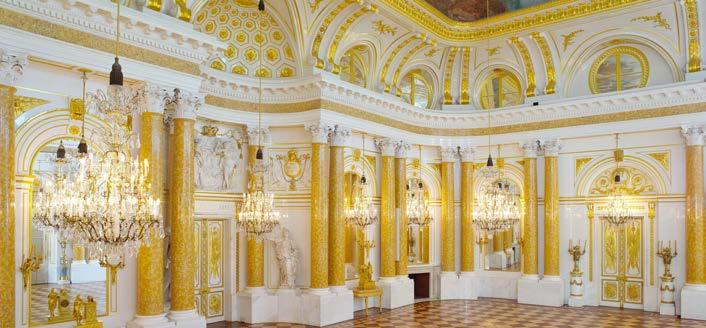
QG-4, Pl. Zamkowy 4, tel. (+48) 22 355 51 70, www. zamek-krolewski.pl. Open 10:00-17:00; closed Mon. TinRoofed Palace is open Tue-Sun, 10:00-17:00. Admission 50/40zł; kids and students with valid ID, 1zł; Wed free. U
3 Jan Kiliński Monument
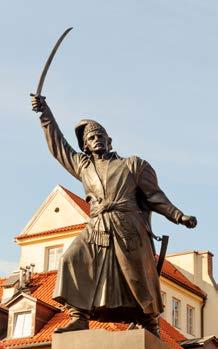
This huge monument honours Jan Kiliński, a Warsaw cobbler who became the unlikely hero of the 1794 Kościuszko Uprising. Despite being wounded twice, Kiliński and his troop of peasants captured the Russian Ambassador’s Warsaw residence - an action that ultimately led to his imprisonment in St. Petersburg. Said to embody the Polish virtues of bravery and patriotism, his statue was erected in 1936 and originally located on Plac Krasińskich. In reprisal for an attack on the Copernicus Monument, Nazi troops hid Kiliński inside the vaults of the National Museum. Within days, boy scouts had daubed the museum with the graffiti ‘People of Warsaw! I am here, Jan Kiliński.’ After the war the cobbler was returned to his rightful place, before being relocated here in 1959.
Kiliński’s comrade and superior Tadeusz Kościuszko (p.11) himself once lived nearby at Szeroki Dunaj 5; this wide street was formerly home to Warsaw’s fish market, while the narrow street running at a 90-degree angle, Wąski Dunaj, was the town’s Jewish Quarter during the Middle Ages.QF-4, ul. Podwale.
34 Old Town Walking Tour | Sightseeing
The ‘Grand Apartment’ of the Royal Castle.
4 Old Town Defensive Ramparts
The first sections of Warsaw’s defensive walls date back to the late 13th century, and by the end of the 14th century they stretched 1,200 meters, enclosing an area of about 8.5ha, and included 8 towers and 4 city gates. The most famous of these now non-existent structures was the Krak ów Gate on Plac Zamkowy, and the Marshall’s Tower - the highest point in the defensive structures - near the corner of ul. Krzywe Koło and ul. Brzozowa. Already in the 15th century these defenses were deemed insufficient and a second, lower line of brick walls was built along today’s ul. Podwale at a distance of just 9-14m from the previous walls; a moat was dug in-between and the Barbican was built in 1548 as the final piece of the defenses. As Varsovians were already settling in numbers beyond the city walls, these fortifications quickly became obsolete and from the 17th century they were being demolished or incorporated into tenement buildings. Ironically it was the total destruction of the Old Town that allowed these walls to be rebuilt after WWII and today the space between the two historical brick ramparts forms a pedestrian promenade parallel to ul. Podwale known as ‘Międzymurzę.’ Along this pleasant route you’ll find many historical plaques and monuments, but you won’t see much of the Old Town centre, as the view is obscured by the high inner wall.QF-4, Międzymurzę Jana Zachwatowicza.
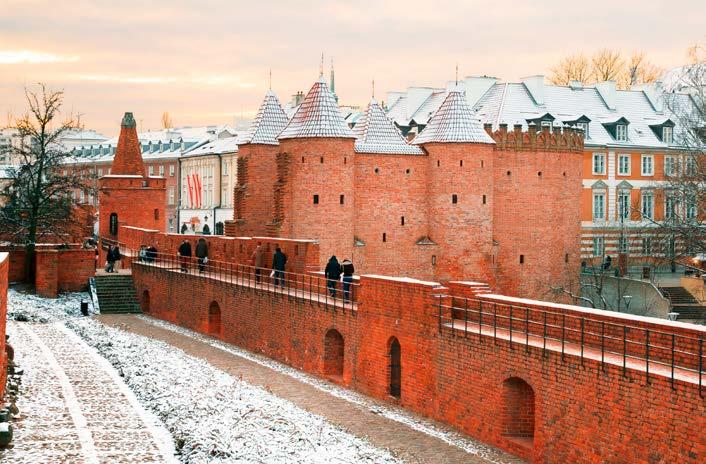
5 The Little Insurgent Monument
The communist authorities continually thwarted efforts to commemorate the Warsaw Uprising of 1944, though by the early 1980s cracks in their resolve were beginning to show. In 1983, this most poignant of all Uprising monuments was unveiled by the walls of the Barbican. Designed by Jerzy Jarnuszkiewicz and funded by collections undertaken by scouts, the bronze installation shows the figure of a boy soldier clutching a Sten gun and weighed down by an adult-sized helmet. Commemorating the children who served as messengers and frontline troops, the figure is inspired by the story of 13-year-old corporal Antek, himself killed in action close to the scene on August 8, 1944.QF-4, ul. Podwale.
Crossroads!
Continue along the Old Town defensive walls to the Barbican, and on to the Old Town Square?
Or, duck out of the medieval walls and down ul. Kilińskiego, hanging a left on ul. Długa for a short <20min/1.5km walk to the POLIN Museum (D-4, p.67) via the imposing Warsaw Uprising Monument and lovely Krasiński Palace and Gardens (E-4)?
35 Sightseeing | Old Town Walking Tour
Warsaw Barbican (p. 36) with a fresh dusting of snow.
Photo by vesta48 / Canva Pro
6 Warsaw Barbican
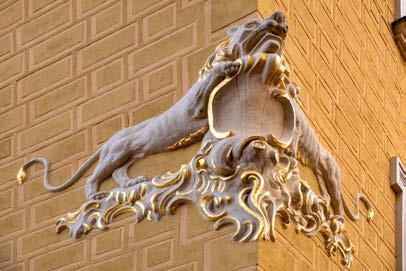
Crowning the medieval defensive walls which once protected the northern entrance to the city, this fearsome rotund structure dates from 1548, and was built by architect Giovanni Battista Venetian on the site of an earlier city gate. Despite its intended use, the Barbican was only ever used in one fighting action when in 1656, during the Swedish deluge, Polish troops attacked to retake the city. In the 18th century, the Barbican was partially demolished and incorporated into new apartment buildings. As part of the Old Town’s reconstruction after WWII, the Barbican were restored. Today it serves as a bridge between the Old and New Town, and is also the hangout of choice for teenage drinkers, buskers and ‘artists’ selling their wares. For the record, this is the second biggest barbican in Poland - the biggest is that which is located in Kraków! Unfortunately, the exhibition is closed until May 2023. QF-3/4.
7 Old Town Square
Measuring 90 by 73 metres, the Old Town Square is Warsaw’s defining highlight, lined with richly decorated burgher houses whose design dates back to the 17th century. During the 15th century, the centre of the square was home to Warsaw’s Town Hall, though this was pulled down in 1817 and never replaced. The district was damaged during the 1939 invasion of Poland by Nazi Germany, though the occupiers would do far worse in 1944. In Hitler’s ‘Order for Warsaw’, a brutal counteraction in response to the Warsaw Uprising (p.68), the old town area
was systematically bombed by approximately 1,600 tonnes of explosives. Following the end of hostilities, 85-90% of Warsaw had been completely destroyed, including the market square, where only a few facades remained. Plans for the future of the district varied from full restoration to clearing the rubble and rebuilding the city in concrete! Fortunately, the earlier option was pursued, specifically choosing the Warsaw of 1770 as its basis (This year was chosen because it was just before Poland was subject to gradual foreign occupation). In addition to salvaged materials that lay around Warsaw, other wartorn cities were purged of their rubble to get enough bricks for the reconstruction! Thus, many of the buildings you see in the old town market square may have once been in the walls of a tenement house in Wrocław or Elbląg!

36 Old Town Walking Tour | Sightseeing
The statue of ‘Syrenka’, Warsaw’s iconic warrior mermaid, in the Old Town Market Square. Photo by Ziutograf / Canva Pro.
The ‘House Under the Lion’ ornament in the Old Town Square
Today, the square’s most famous feature is Warsaw’s best-loved monument and the city’s defining symbol - Syrenka (p.10). Designed by Varsovian sculptor Konstanty Hegel, this iconic monumentn of Warsaw’s warrior mermaid dates back to 1855, and is actually an exact copy of the original, which can be seen in the Museum of Warsaw. Lined with souvenir shops, restaurants and cafes, at number 27 you’ll find Warsaw’s oldest and most prestigious restaurant, U Fukiera. (p.85) The facades hide a treasure trove of decorative elements - keep an eye out for our favourite, the ‘House Under the Lion’ at the southwest corner leading onto ul. Świetojańska.QF-4, Rynek Starego Miasta.
8 Museum of Warsaw, Main Branch
Found inside 11 conjoined historical tenements on the Old Town Square, this revamped museum’s permanent exhibit, ‘The Things of Warsaw,’ presents the city’s cultural history via 7,000 objects displayed over 21 thematic rooms. Included are portraits, postcards, souvenirs, packaging and other items with representations of the Polish capital or symbols like the Warsaw Mermaid - all of which contribute to a better understanding of the events that have shaped the Warsaw we know today. The history of the buildings themselves, which still retain many original elements, is also presented, and there’s also a bookstore, cafe and fabulous viewpoint overlooking the Old Town Square. Visiting time: 2-3hrs.QF-4, Rynek Starego Miasta 28-42, www.muzeumwarszawy.pl. Open 09:00-17:00; Thu 09:00-19:00, Sat, Sun 11:00-18:00; closed Mon. Admission 20/15zł; Thu free. U6
9
Old Town Museums
When it was rebuilt in the postwar years, Warsaw implemented a vision of its resurrected Old Town as a place of culture. Today it harbours a remarkable number of museums, so instead of just staggering around, gawking at the architecture - go inside and learn something. The two largest, most significant and most worth-visiting museums (in our opinion) are the Royal Castle (p.34) - where you’ll get a feel for the city’s lost grandeur, and the Museum of Warsaw, where you’ll learn its history. Depending on your interests, however, you may be interested in one of these smaller, more niche museums nearby.
Gnojna Góra
Demonstrating how any foreign word sounds exotic when you don’t know the language, Gnojna Góra may sound like a charming place for a stroll in Warsaw’s Old Town. While it does have picturesque view of the Vistula River and the Praga district beyond, Gnojna Góra actually translates as ‘Dung Hill’ (or Shit Hill, depending on how polite you wish to be). For centuries, this was the dumping ground for all of the Old Town’s waste - chamber pots, food scraps, everyday rubbish, you-name-it. Continuing to grow over time into its distinctive shape, at one stage this enormous urban compost pile was actually renowned for its healing properties - people with obscene amounts of money would come here to be buried up to their necks in rubbish in a supposed cure for syphilis. Today, its a top piece of trivia and an enduring monument made of literal crap in the midst of Warsaw’s UNESCO-listed Old Town!QG-4, ul. Brzozowa.
Archdiocese Museum: Displaying both the sacred and profane, this surprising and underrated art museum has several creepy Beksiński paintings. More on p.62 Qul. Dziekania 1.
Museum of Dollhouses: Over 150 highly detailed historical dollhouses, plus various other minature settings, and antiquated toys. A good option for children!Qul. Podwale 15.
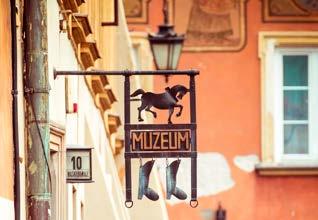
Old Town Heritage Interpretation
Centre: Go into these cellars for a deep dive on how Warsaw's Old Town went from ruin to the UNESCO List. Qul. Brzozowa 11/13.
Pharmacy Museum: Travel back in time to a charmingly antiquated interwar ‘apteka.’ Nominated for ‘European Museum of the Year 2022.’ .Qul. Piwna 31/33.
World of Illusion: More attraction than museum, but a nice reward for the kids, the exhibits will fool your eyes and you’ll go home with lots of fun photos. More on p.71.QRynek Starego Miasta 21.
37 Sightseeing | Old Town Walking Tour
Eat & Drink
Warsaw’s Old Town is full of restaurants and bars, but as this is literally the most touristy part of the city, the quality varies. When it’s time to take a break, here are a few places that are worth the money and worth seeking out.
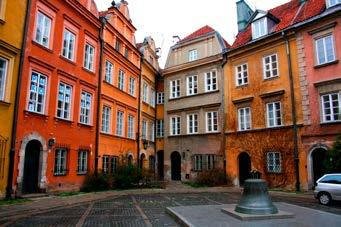

To Lubię: Just steps north of the Barbican, this small cafe is the perfect place to stop for a coffee or something sweet, and they serve breakfast all day. More on p.77 Qul. Freta 8.
Ciao Napoli: Authentic Neapolitan pizza (the best in town?), fresh seafood and happy hour specials make this affordable franchise deservedly popular. More on p.78. QWąski Dunaj 4/6/8.
U Barssa: This classy restaurant brings a refreshing refinement to the Market Square with traditional Polish cuisine. Try their signature ‘Duck a la Barssa’ More on p.80 QRynek Starego Miasta 12/14.
U Fukiera: Adhering to tradition with extravagant flair, this famous restaurant on the Old Town Square offers an exceptional dining experience. More on p.85 QRynek Starego Miasta 27.
Bar & Books: Open after 17:00, drop in this sophisticated, dimly-lit cocktail and whisky bar for an evening drink, and maybe catch some live music on weekends.Qul. Wąski Dunaj 20.
From here head back towards the centre via ul. Dawna, whose trademark blue archway is one of the most picturesque sights in the city, then swerve onto ul. Kanonia
10 Ul. Kanonia
Once the site of the oldest cemetery in Warsaw, Kanonia Street takes the shape of a small square, at the centre of which is a cracked Cathedral bell dating back to 1646. Cast by artisan Daniel Tym (who also made the statue of King Sigismund III atop the famed column), the bell never actually rang at St. John’s Cathedral next to it, but it has developed its own legend: touch the top of the bell while walking its circumference and your wish will come true Across from the bell is one of the world’s most narrow houses at number 20/22. Only 2m across, it was designed to evade property taxes, which in the 18th century (when it was built) were calculated
38 Old Town Walking Tour | Sightseeing
The blue archway on ul. Dawna is a favourite of both locals and tourists!
Ul. Kanonia Wishing Bell Juan Antonio F. Segal, CC BY 2.0
based on the width of the facade facing the main street. Also note the covered walkway nearby, which links the Cathedral to the Royal Castle and was built after a failed assassination attempt on Sigismund III. The attacker, who succeeded in striking the King twice with a pickaxe before being overpowered, was subsequently dealt with using the most medieval means imaginable: stretched by four horses, he was quartered with an axe; his body was then burned, and the ashes fired from a musket so as to disperse them in the air. This was all done in public, of course, at the city’s execution place, a few blocks away at the end of ul. Piekaska.QG-4.
11 St. John the Baptist Cathedral

Originally built in the 14th century, St John’s is steeped in history. The last king of Poland, Stanisław August Poniatowski, was crowned and buried here, and in 1791 he also declared the May 3rd Constitution inside the building. The crypt holds the bodies of Henryk Sienkiewicz (writer), Gabriel Narutowicz (Poland’s 1st president) and various Mazovian knights. As with most major landmarks, it was left in a heap of ruins during the Warsaw Uprising, before being rebuilt in pseudo-gothic style. On the external wall by the main entrance are fragments of a Borgward IV - a remote-controlled demolition vehicle used by the German army. It’s possible to visit the crypts Mon-Sat 10:00-17:00 and Sun 15:00-17:00 at a cost of 5/3zł (closed during mass).QF/G-4, ul. Świętojańska 8, www.katedra.mkw. pl. Open 06:00-20:00; Sun 07:00-22:00.
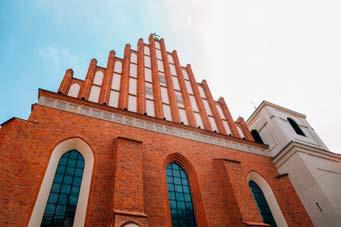
Choose Your Adventure!
Circling back to Plac Zamkowy you can either carry on down the Royal Route (turn the page), or circle round the back of the Royal Castle for a walk through the free gardens and down along the riverbank towards Powiśle (p.46).
39 Sightseeing | Old Town Walking Tour
St John the Baptist Cathedral
The Royal Route
Warsaw’s famed ‘Royal Route’ links the city’s three Royal residences, starting from the Royal Castle (p.34) on Plac Zamkowy, via Łazienki Park’s Palace on the Island (p.52), en route to Wilanów Palace (p.55) in the district of the same name. Officially covering 11km in length, this main artery through the city takes in a great many of Warsaw’s historical buildings, parks and monuments along the way, making a trip down at least part of the ‘path of the kings’ - be it on foot, by bike, or motorised scooter - a fine opportunity to see the heart and soul of the capital.
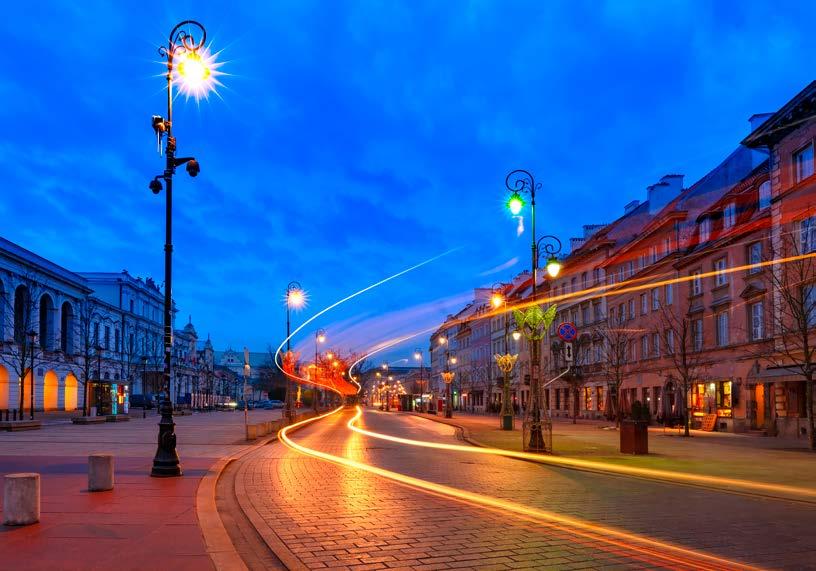
WALKING TOUR
In lieu of the full 11km traverse, this walking tour picks up at the end of the Old Town Walking Tour (p.32) on Plac Zamkowy and guides you gently down Warsaw’s two main high streets - ul. Krakowskie Przedmieście and ul. Nowy Świat - to the ironic/iconic Palm Tree fittingly at the intersection of Al. Jerozolimskie (Jerusalem Street). An easy 2km/20mins on foot, along the way or very nearby you’ll find many wonderful restaurants, cafes, bars and shops, so use the rest of our guide to plan your pit stops. In the ‘Choose Your Adventure’ box at the end of the tour (p.44), you’ll find info on how to continue on the Royal Route to Łazienki and Wilanów (while resting your feet) should you choose to, or advice on how to veer off towards other interests.
1 St. Anne’s Church & Tower
St. Anne’s survived the war with a few token scratches and a bombed-out roof, but what the Nazis failed to destroy was very nearly demolished in 1949 when the careless construction of the nearby Trasa W-Z tunnel led to landslides and huge cracks in the floor of the church, which threatened to collapse; it took 400 people two weeks to stabilise the foundations. Intriguingly, this wasn’t the first time St. Anne’s had survived war to find disaster around the corner. Escaping destruction during the Swedish Deluge (1655-1660), the church was the victim of arson only two years later. The classicist façade dates from 1788 and the interior holds even more classicist and rococo details. The real reason to visit, however, is the splendid viewing tower, the views from which are worth the 147-step climb (open 10:00-18:00; Sat,
40
Blue hour on Krakowskie Przedmieście on the Royal Route. Photo by Kavalenkava / AdobeStock.
Sun 11:00-18:00; 10/7zł). One other point of interest concerns a simple wooden cross in the Loreto Chapel. To learn how these two planks of wood nearly ripped the country apart in the summer of 2010, see our online piece on the Presidential Cross: iyp.me/71061 QG-4, ul. Krakowskie Przedmieście 68, MRatusz Arsenał, www.swanna.waw.pl. Open 07:0018:30; Sat 15:00-18:30; Sun 10:00-21:00.
2 Adam Mickiewicz Monument

Patriot and poet Adam Mickiewicz (1798-1855) is Poland’s greatest literary hero. Known as the ‘Father of Polish Romanticism,’ his epic poems and dramas served as inspiration for insurrections against the imperial powers that had partitioned Poland out of existence in the late 18th century.
Born to an upper class Polish family in what is today Belarus, Mickiewicz attended university in Vilnius, where he began publishing his poems and became involved in political activities against imperial Russia, which now occupied the former territory of the Polish-Lithuanian Commonwealth. These activities saw him exiled to Russia in 1824, but Mickiewicz was able to leverage connections he made in the salons of Moscow and St. Petersburg to escape to the west in 1830, eventually settling in Paris. A champion of freedom, he died during a cholera outbreak in Turkey, while recruiting a Polish legion to fight the Russians in the Crimea in 1855. His body today lies with those of the Polish kings in Kraków’s Wawel Cathedral. To learn more, visit the Adam Mickiewicz Museum of Literature on the Old Town Square (F-4).
This monument was first unveiled in 1898 on the 100th anniversary of Mickiewicz’s birth. Sculpted by Cyprian Godebski, the monument was destroyed by the Nazis, however, after WWII, Polish soldiers recovered Mickiewicz’s head and other demolished parts in Hamburg. Sculptor Jan Szczepkowski was able to produce a copy of the original sculpture, which was unveiled, along with its restored surroundings, in 1950.
QG-5, ul. Krakowskie Przedmieście
21-23, MNowy ŚwiatUniwersytet.
41 Sightseeing | The Royal Route
Photo by Back Yard Productions / Canva Pro Warszawa Powiśle AL. "SOLIDARNOŚCI" AL. JEROZOLIMSKIE
Nowy Świat-Uniwersytet Miodowa NowyPrzejazd Wierzbowa
Podwale Fredry
Senatorska M o l i e r a Foch a Królewska Mazowie c ka
K o z i a Trębacka Traugutta
Ossolińskich Dowcip
K o z i a Pl .Piłsudskiego
S k w e r H o o v e r a Pasaż N i ży ńs k ieg o
Nowy Zjazd Grodzka Czackiego Górskiego
Bednarska Świętokrzyska Chmielna
Karowa Brack a
Ba c z y ńs k ie g o
Puchatka Tuwima
Warecka Nowy Świa t N o w y Św ia t
Oboźna Ordynacka
K a r a s i a G a łc z y ń s k ie g o Foksal
Bartoszewicza
Kopernika S e w e r y n ó w Kopernika
D y n as y Szczygla
Tamka Okólnik Szczygla Smolna
K r a k o w s k i e P r z e d m i e ś c i e Pl. Powstańców Warszawy
Nuns of the Visitation Zamoyski Palace
Park Kazimierzowski VITKAC
Warsaw University
Presidential Palace Chopin Museum
Tomb of the Unknown Soldier Papal Cross Piłsudski Copernicus
National Opera
Nike Poniatowski Charles de Gaulle
Holy Cross
Zachęta
St. Anne's
King Sigismund's Column Royal Castle Adam Mickiewicz Kordegarda
Museum of Caricature Hotel Bristol Raffles Europejski Teatro Hotel Hotel Indigo
MOTEL ONE Warsaw-Chopin
Sofitel Warsaw Victoria
Bellotto
Verte
1 cm = 100 m Scale 1:10 000 0 150 m 4 6
3 5
2
1 8
7
3 Presidential Palace
Guarded by lions and stern-looking soldiers, of all the landmarks that line Krakowskie Przedmieście, none is more important than the Presidential Palace. Construction began in 1643 at the behest of Stanisław Koniecpolski, though was only completed after his death. It then passed into the hands of various aristocratic families, becoming famed for its banquets in the 18th century - the most extravagant of which marked the coronation of Stanisław II August Poniatowski in 1789; over 2 million PLN was spent entertaining the 4,000 guests.
Poniatowski proved to be one of the nation’s most controversial monarchs - and also its last. Among his successes was the Constitution of May 3, 1791 Signed on these very grounds, it was the 2nd such document in the world, after the US Constitution. The large monument in front of the Palace is of the king’s nephew, Józef Poniatowski A Polish general, he defended Warsaw during the Kościuszko Uprising and eventually died in the service of Napoleon.
After 1818 the Palace became the seat of the Viceroy of the Polish Kingdom, entertaining many a visiting Tsar before burning down in 1852. Rebuilt and frequently remodelled, at the beginning of the 20th century an entire wing was demolished to make way for the Hotel Bristol. When Poland regained its independence in 1918 the Palace was commandeered to serve as home for the Prime Minister, and somehow it survived WWII. More momentous events came in 1955 when the Warsaw Pact - the Soviet Union’s answer to NATO - was ratified within its walls. Since 1994 it has served as the official home of the Polish president (currently Andrzej Duda), which is why you’ll find streams of limos heading in and out, and square-jawed soldiers pointing their weapons at anyone who strays too close.QG-5, ul. Krakowskie Przedmieście 46/48, MNowy Świat-Uniwersytet.
Crossroads!
Carry on down the Royal Route? Or perhaps hang a right after the Hotel Europejski down ul. Tokarzewskiego-Karaszewicza towards Plac Piłsudskiego (p.24)? Choose the latter to see Warsaw’s largest square and escape the urban hub-bub via the lovely Saxon Garden, a stroll through which leads you into the City Centre (p.24) and on a path to Hala Gwardii and Hala Mirowska (p.24) - two massive indoor markets 1520mins on foot from where you’re standing.
4 Bristol & Europejski Hotels
Two of the biggest, most famous landmarks on prestigious ul. Krakowskie Przedmieście are former palaces turned luxury hotels today. The first is Hotel Bristol (Qul. Krakowskie Przedmieście 42/44). First built in 1900, a brass plaque outside boasts of its many famous guests: Picasso, Nixon and Dietrich, to name but a few. The restored interior by worldrenowned designer Anita Rosato blends secessionist and art deco glamour with modern luxury. Across the street is the revamped Raffles Hotel Europejski (Qul. Krakowskie Przedmieście 13). The first hotel to re-open after WWII, it entered Varsovian folklore in 1967 when a group of young upstarts calling themselves ‘The Rolling Stones’ stayed here, under the watchful eye of the authorities. By all accounts, they kept themselves busy tipping back vodkas in the hotel bar!QG-5
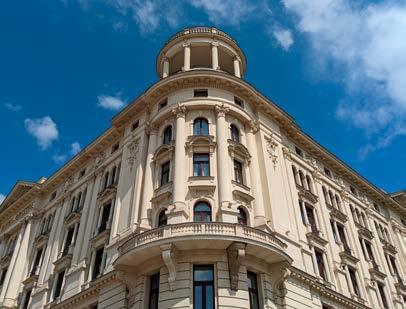
5 The University of Warsaw
Warsaw Uni’s main campus lies behind the grand gateway at ul. Krakowskie Przedmieście 26/28. Dating from the 17th century the main building, known as ‘Villa Regia,’ was remodelled and renovated several times before the university was established here in 1816. The uni had a tough time under Russian rule; closed in retaliation for the 1830-31 Uprising the university continued to operate underground, though by 1859 the Tsar calmed down enough to rubber stamp the creation of a School of Medicine. Today, with some 48,000 students on the roll call, the university stands out as the largest and arguably best in Poland. Notable alumni include former Israeli premier Yitzhak Shamir, writers Witold Gombrowicz and Ryszard Kapuściński, and late Polish president Lech Kaczyński QG-6, Krakowskie Przedmieście 26/28, MNowy Świat-Uniwersytet, www.en.uw.edu.pl
42
| Sightseeing
The Royal Route
The fancy corner of the Bristol Hotel.
Photo by Bogdan Krupin / Canva Pro.
6 Holy Cross Church
No Chopinologist can leave Warsaw without first visiting the final resting place of his heart. Added to the church in 1882 his heart was sealed in an urn and then placed behind a tablet bearing his likeness specially carved by Leonardo Marconi. As for the church itself, it originally dates from the 15th century when a small wooden chapel stood on the site. Destroyed during the Swedish Deluge of the 1650s, the church was finally rebuilt in 1696, with numerous additions and decorative touches to follow over the years. Throughout history the church has played its role in Warsaw’s glories and calamities. It was here that the last Polish King forged the Order of the Knights of St Stanislaus, and it was directly outside in 1861 that Russian troops brutally suppressed a patriotic protest. It was this bloodbath that lit the touchpaper for the January Uprising of that year. Devastated during the Warsaw Uprising in 1944 the church was painstakingly rebuilt at the end of the war and is today a feast for the heart, eyes and soul. The organ (built in Salzburg in 1925) is the largest in Warsaw, and other points of note include an urn with the remains of Nobel Prize winning author Władysław Reymont, and tablets honouring various Polish icons including poet Juliusz Słowacki and WWII hero Władysław Sikorski QG-6, ul. Krakowskie Przedmieście
3, MNowy Świat-Uniwersytet, tel. (+48) 22 826 89 10, www.swkrzyz.pl. Open 10:00-11:00, 13:00-16:00; Sun 14:00-16:00.
7 Nicolaus Copernicus Monument
The founder of modern astronomy. A sheltered academic, Copernicus made his observations alone, a century before the invention of the telescope. His book De Revolutionibus (1543) posited that the earth rotated on its axis once a day, travelled around the sun once a year, and that man’s place in the cosmos was peripheral. Though obvious today, this was an utterly radical idea at the time. Although those who propagated his ideas were burned at the stake and the Catholic church placed De Revolutionibus on its list of banned books (as late as 1835), there was no turning back progress. The modern cosmological view - that our galaxy is one of billions in a vast universe - is this man’s legacy. The statue itself was unveiled in 1830 and has seen its share of adventure. During WWII the Nazis placed a new plaque here insinuating that the great man was in factgasp! - a German. A boy scout named Alek Dawidowski ducked the guards and removed the plaque. Boiling with fury, the Nazis removed the monument, then dynamited a few others for good measure. The statue was recovered after the war, and Dawidowski entered Polish folklore for his bravery.QG-6, ul. Krakowskie
Przedmieście, MNowy Świat-Uniwersytet.
DELICIOUS JAPANESE & ASIAN SPECIALTIES
SUSHI, RAMEN, LUNCHES, KIDS MENU FIND IT ALL AT TOKYO SUSHI
ul. Nowy Świat 50, tel. 22-657-15-89
C.H. Blue City, tel. 22-311-71-30
C.H Galeria Mokotów, tel. 22-161-35-41
Delivery available everywhere in Warsaw
Order online at www.tokyosushi.com.pl
ul. Nowy Świat
After crossing Świętokrzyska, Krakowskie Przedmieście becomes Nowy Świat (G-7)Home to numerous bars and eateries, in addition to those below, you’ll find many more on the trendy side streets of ul. Chmielna and ul. Foksal
Blikle Café: Famously patronised by Charles de Gaulle, this classy, august venue offers breakfast, lunch, ice cream and outstanding desserts that are part of Warsaw folklore..Qul. Nowy Świat 33.
Tehran: Experience the specialties (mutton, lamb) and exotic flavours (mint, rose, saffron) of Iran in this colourful eatery that exudes good energy. More on p.80 Qul. Gałczyńskiego 9.
Tokyo Sushi: A great pit stop with great value across their huge menu of sushi rolls, salads, ramen and hot dishes. More on p.80Qul. Nowy Świat 50.
Gościniec Polskie Pierogi: Some say “the best dumplings in Warsaw” are here. Traditional Polish cuisine with an interior setting to match! More on p.79 Qul. Nowy Świat 41
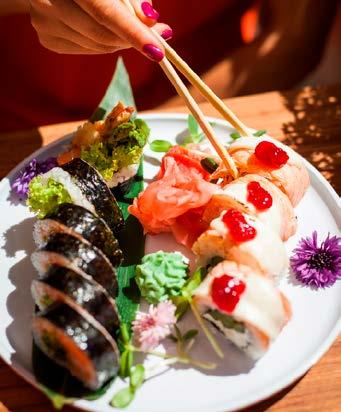
43 Sightseeing | The Royal Route
Choose Your Adventure!
From the Palm Tree, Warsaw’s ‘Royal Route’ continues another 10km, past the Ujazdowski and Łazienki Parks, before it ultimately ends at Wilanów Palace - the 17th century private residence of King Jan III Sobieski. While a walking tour of the remaining 10km isn’t realistic or especially rewarding, Łazienki (p.50) and Wilanów (p.54) are both required for getting a broader sense of Warsaw’s former glory as the grand capital of a vast and wealthy commonwealth stretching from the Baltic to the Black Sea. You can easily continue your tour to either from the Foksal 01 bus stop on ul. Nowy Świat. To get to Łazienki Park, simply hop on bus numbers 116 or 180 and get off three stops later at ‘Łazienki Królewskie.’ For Wilanów, take the same numbers, or catch the direct E-2 bus; get off at ‘Wilanów.’ Use warsaw.jakdojade.pl for live public transit connections.
If your’re not worn out, heading 300m down charming ul. Ordynacka (G-7) leads you direct to the Chopin Museum (currently closed), where you’ll connect with our Powiśle district tour (p.46).
Alternatively, head west down pedestrianised ul. Chmielna - through the new Plac Pięciu Rogów (p.28) and past many a bar and restaurant - to reach the Palace of Culture (p.26) in about 10mins.

Of course you can always backtrack to the Metro to make a shortcut to the River Boulevards (p.46) or onward to Praga (p.56). Decisions!
Chopin Recitals
Poland’s greatest composer, Fryderyk Chopin (1810-1849) was born 50km west of Warsaw, moving to the capital with his family as a baby. A prodigy from the start, he came to fame here before being exiled at age 20 due to the November Uprising of 1830. Walking down Warsaw’s Royal Route, Chopin-related sites are in abundance, moast notably the Holy Cross Church (p.43). Also, keep an eye out for several ‘Chopin Benches’ which explain the history of relevant sites and play a burst of the composer’s music at the touch of a button.
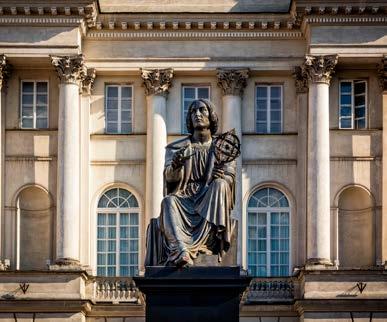
Live Chopin recitals are a popular tourist activity in Warsaw, and there are two points along the Royal Route where you can attend one. The first is on Plac Zamkowy (F-4, ul. Krakowskie Przedmieśćie 87/89) at Chopin Point, where recitals take place every day at 19:00 from December 17th until the end of the month, and elsewhere in Winter from Fri-Sun @ 19:00, 90/65zł). The second is Chopin Salon on ul. Smolna 14/7 (H-7, every day at 19:30, 60/40zł). On Sundays, head to the Chopin monument in Łazienki Park (p.51) to hear free outdoor recitals at 12:00 and 16:00.
8 The Palm Tree
Wondering what a giant palm tree is doing in the middle of this roundabout? Modern art, my friends! In this case, a project called Greetings from Jerusalem by Polish artist Joanna Rajkowska, who, during a trip to Israel, was struck by the brainwave of sticking a palm tree in the Polish capital to give it some sunny cheer (in the most ironic way possible). The palm tree is actually a steel column specially designed to bend in the wind, covered with natural bark and leaves made from polyethylene. Quite popular, the permanent installation reminds us of all the beautiful and exotic places we could be instead.QG-8,
44 The Royal Route | Sightseeing
Rondo de Gaulle’a, MNowy Świat-Uniwersytet.
Copernicus monument at the Polish Academy of Sciences
Warsaw’s famed Palm Tree!

Powiśle: Warsaw’s Riverside District
ticket
turned
Once a mundane area of apartment blocks and industrial decay, over the past two decades Powiśle has transformed into one of Warsaw’s most intriguing and eclectic areas to explore.
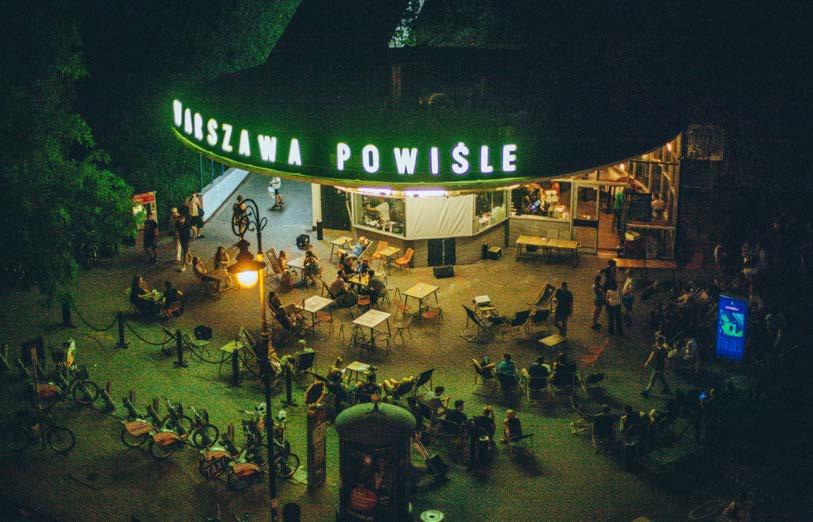
Considering its plum location along the riverside, it’s hard to believe that this large neighbourhood was essentially a cultural dead zone until skyrocketing rent costs in the City Centre forced Warsaw’s students, artists, activists and small business owners to reconsider its potential. Warsaw University was the first to pitch a tent in the area, creating a real draw since 2002 with their lovely Library Rooftop Gardens (open from April until end of October), and the adjacent opening of the prestigious Copernicus Science Centre in 2009 invited further cultural investments (like the Museum of Modern Art), while also creating strong impetus for the city to connect the area via Metro (2015) and finally clean up and modernise the left bank river boulevards into a popular place for public recreation (completed in 2017). The massive redevelopment of the former Elektrownia Powiśle power plant into a space for events, dining and shopping (opened in 2020) typifies the high-powered investment taking place here today, but despite increasing gentrification, Powiśle still maintains an authentic local vibe thanks to its balance of both trendsetting gastro spots and boho dives (like the iconic Warszawa Powiśle bar). Roll yourself downhill towards the river from Warsaw’s Old Town or City Centre to discover what’s good in this hood!
What to See
1 Vistula River Boulevards
In case you were wondering, Powiśle means ‘Along the Vistula’ in Polish, and boulevards flanking the Świętokrzyski Bridge and leading north to the Old Town are an important part of the district’s happenings. A huge amount of development has taken place in the last decade, and it’s now a popular thoroughfare for walking, running, cycling and skating, as well as bars, cafes and restaurants parks and leisure spaces. The area just north of the bridge has also become a cultural corridor and tourist lure thanks to top attractions: the Copernicus Science Centre, Museum on the Vistula, as well as the Multimedia Fountain Park further north (F-3). It’s fair to say that Warsaw’s river boulevards are now among the best in Europe and as endemic to the identity and character of the capital as those in London or Paris, so brave the chill and get out there! One thing that makes Warsaw’s riverside especially unique is that while the boulevards of the left bank consist of concrete retaining walls, the entire breadth of the opposite shore has been left completely undeveloped, making for a stark, fascinatingly-unusual contrast.QI-6, Generała George’a Smitha Pattona, MCentrum Nauki Kopernik.
46
A former
office
iconic bar - Warszawa Powiśle!. | Photo: Emilia Niedzwiedzka, unsplash
2 Powiśle Mermaid Statue
Feisty, beautiful and busty, Warsaw’s ‘Syrenka’, the iconic freshwater warrior mermaid, has been representing Warsaw since time immemorial (p.10). The legend has been debated and disputed scores of times - one says that she rescued Prince Kazimierz when he got lost on a hunting trip in the marshlands nearby. The other claims that Syrenka journeyed down the Vistula, was imprisoned by a devious merchant, and then subsequently freed by the people of the Warsaw township.
The monument here is arguably the second most famous statue of the city’s symbol (the other one is in the Old Town Square - p.36), though this one actually overlooks the body of water that the mythical icon is alleged to have dwelled in. This 2.75m tall bronze work was created by sculptor Ludwika Nitschowa and unveiled in June 1939, a few months before the outbreak of WWII. Her model was 23-year-old poet and ethnography student, Krystyna Krahelska, but allegedly Ludwika changed the features of her face slightly to protect Krystyna’s modesty. After Warsaw’s devastation during both the Nazi invasion and Soviet ‘liberation’, it’s remarkable that the Powiśle Mermaid stood the whole time in this spot and sustained only minor damage!QI-6, Bulwar Bohdana GrzymałySiedleckiego (near Most Świętokrzyski), MCentrum Nauki Kopernik.
3 Elektrownia Powiśle
Once one of the largest electrical power plants in Europe, Elektrownia Powiśle powered the Polish capital from 1904 to 2001 before it was closed and left to crumble. Purchased by a developer in 2016, it was only a matter of time before the historic industrial site was transformed into a multifunctional, mixed-use urban centre. Covering a massive 50,000m2, much of the site has been
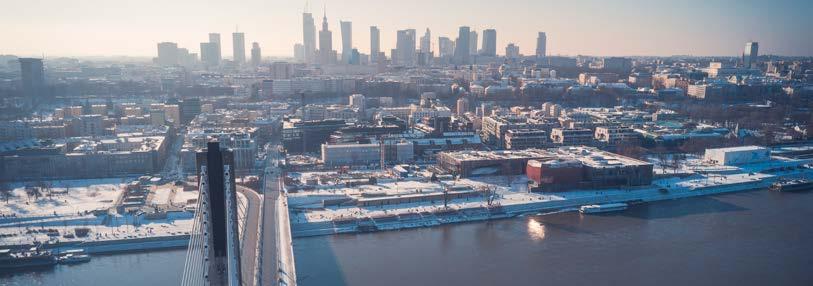
47 Sightseeing | Powiśle
Warszawa Powiśle Centrum Nauki Kopernik M2 WYB . KOŚ C I USZKOWSK I E POWIŚLE MARIENSZTAT Grodzka Karowa Furmańsk a Ordynacka Foksal Bartoszewicza Bednarska B r o w a r n a D y n as y Gęsta Karowa O k ó l n i k Wiślana Lipowa Radna Cicha W yb . Kościuszk owsk i e Smolna P ani eńsk a Dobra Ols Zajęcza Jaracza Al 3 Maja Solec Bulw.Pattona T o piel B u g a j Leszczyńska Oboźna D o b r a Kruczkowski e go Dob ra Solec Smulikowski e go Tamka Tamka Drewniana WYB .KOŚCIUSZKOWSKIE Ś wi ęt o jańsk a Źródłowa S o w i a S e w e r y n ó w Szczygla Elektryczna Św. Salezego Wisła Chopin Point Chopin Mural Rynek Mariensztacki AL. JEROZOLIMSKIE MostŚląsko-Dąbrowski MostŚwiętokrzyski Park Kazimierzowski Karol Beyer Park Ateneum Warsaw University Warsaw University Library & Gardens National Museum Polish Army Museum Chopin Museum Zamoyski Palace Copernicus Science Centre Royal Castle Elektrownia Powiśle 1 cm = 150 m Scale 1:15 000 0 100 200 m 5 2 4 3 1
Aerial view of the Vistula Boulevards on Powiśle’s waterfront. Photo by Łukasz Szczepański / AdobeStock.
Eat & Drink
When it’s time for a rest or a feed, there are many worthy venues on and around ul. Solec - one of the main streets in the area, as well as numerous food trucks and barges moored up along the river. Also, Elektrownia Powiśle has an entire food hall inside, so your options are manifold. Here are a few other notable venues in the neighbourhood:
The Cool Cat: Exuding cool and all over the latest trends, this Asian-influenced bistro does everything from brunch, bao and ramen, to cocktails and natural wines. See p.77 QI-7, ul. Solec 38.
Nadwiślański Świt: A cult restobar in the former lobby of a 1960s hotel near the river, serving modern European dishes, lunch specials, craft beer, cocktails and retro vibes.QI-6, Wybrzeże Kościuszkowskie 31/33.
Warszawa Powiśle: This cult dive bar for hungover hipsters in a former train ticket office epitomises the local vibe, while offering allday breakfast, veggie eats and more.QI-7, ul.
Kruczkowskiego 3B.
LAS: Refined with a lush edge, this ‘forest’ uses local, seasonal ingredients to create contemporary incarnations of Polish classics, plus yummy cocktails.QI-7, ul. Solec 44
SAM Powiśle: A bakery and bistro that rises early to produce its own bread for their aromatic menu of stacked bagles, sandwiches, French toast and more. Put simply, an excellent breakfast option in Powiśle!QH-6, ul. Lipowa 7A
converted into offices, apartments and a hotel, but a remaining 15,000m2 in the former boiler and engine buildings comprises commercial space for retail, gastronomy and wellness. In keeping with current revitalisation trends, the postindustrial plot deftly mixes original architecture and design details with modern trends and convenience, including glass exterior elevators, 30m chimneys and original switchboards.
Reopened in 2020, today Elektrownia offers four levels of shopping with over 70 boutiques, 10 sitdown restaurants across the complex, plus a huge food hall with an additional 13 international food concepts and 3 bars. Additionally, there is a 1500m2 Beauty Hall offering over 300 cosmetic treatments from 10 salons. Events are frequently hosted in the courtyards between the buildings, including a regular farmer’s market, yoga lessons and film screenings, and there’s also a multimedia fountain. Whatever your proclivity, there are plenty of reasons to check out one of Warsaw’s most exciting and successful urban renewal projects QH/I-6, ul. Dobra 42, MCentrum Nauki Kopernik, tel. (+48) 22 128 56 00, www.elektrowniapowisle.com. Food Hall open 12:0022:00, Fri 12:00-02:00, Sat 11:00-02:00, Sun 11:00-01:00.
TU6K
4 Copernicus Science Centre
A rare example of EU funding being used in a genuinely visionary way, the CSC is the very best science centre in Europe , and one of Warsaw’s top tourist attractions. Not only will you learn an awful lot, but you’ll have a blast doing so. The fun starts as soon as you encounter the museum’s very own ‘Robothespian’ - an
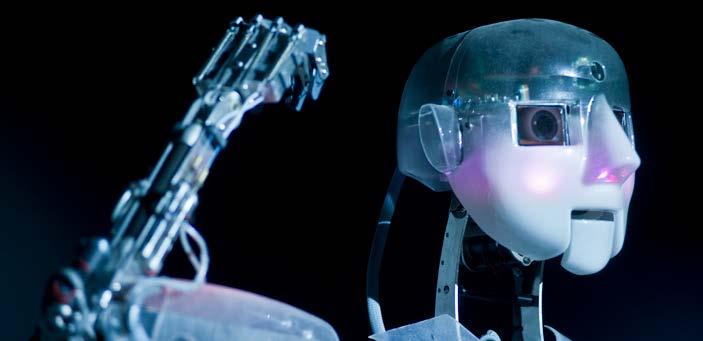
48 Powiśle | Sightseeing
The star of the robot theatre at Copernicus Science Centre. Photo by Centrum Nauki Kopernik.
interactive humanoid robot - at the front doors, before exploring several hundred hands-on exhibits across two floors that will have you actively pressing buttons, answering quizzes, and even exerting yourself physically. In addition to temporary exhibits and the all-ages ‘Experiment Zone,’ there are zones specially designed for the youngest visitors up to teens and adults. Check out the free rooftop garden (open until the end of October), and don’t miss the Planetarium (separate opening hours and ticket). Visiting time: 3-4hrs. QI-6, ul. Wybrzeże Kościuszkowskie 20, MCentrum Nauki Kopernik, tel. (+48) 22 596 41 00, www.kopernik.org.pl. Open 09:00-18:00; Fri 09:0020:00; Sat, Sun 09:00-19:00. Closed 1st Mon of every month. Planetarium open Mon 09:00-15:30; Tue-Thu 09:00-19:00; Fri10:00-21:00; Sat 10:00-20:30; Sun 10:0019:30. Admission 37/25zł; Sat, Sun 39/26zł; planetarium 27/19zł. U
5 Museum on the Vistula
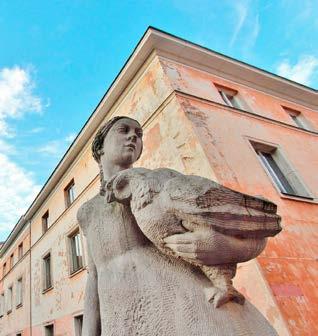
The Museum on the Vistula is a branch of the Warsaw Museum of Modern Art, and the current site of all the institution’s exhibitions while their new headquarters is being built on Plac Defilad (scheduled to open in 2023). Located on top of the Wisła’s riverside terraces, the eye-catching large white box of a building is actually a pavilion that was designed by Austrian architect Adolf Krischanitz and housed the Kunsthalle in Berlin from 2008-10. In 2017 it arrived in Warsaw with the caveat that the exterior be covered in artwork. Sławomir Pawszak won the contest for decorating the facade, and his colourful scribblings have adorned it since it opened. Inside you’ll find provocative exhibitions by international artists that challenge our notions on the nature of art, as well as the Paloma cafe/ bistro and a bookstore. Check out MoMA’s website for current/future exhibitions.QH-5, ul. Wybrzeże Kościuszkowskie 22, MCentrum Nauki Kopernik, tel. (+48) 22 596 40 10, www.artmuseum.pl. Open 12:0019:00; Fri 12-20; Sat 11:00-20:00; Sun 11:00-18:00; closed Mon. Admission 15/5zł, kids under 7 free.
Choose Your Adventure!
From Powiśle it’s exceedingly easy to get to Praga (p.56) or the City Centre (p.22) via the handy riverside ‘Centrum Nauki Kopernik’ M2 Metro station. Alternatively, walk north along the river to return to the Old Town (p.32) or check out New Town’s Multimedia Fountain (F-3), which is a popular attraction for young families; both are about 2km/20mins on foot.
Mariensztat
Cut off from the rest of the Old Town by the intersecting Trasa W-Z, the Mariensztat area - the northern-most part of Powiśle, has its origins in the 18th century when nobleman Eustachy Potocki married Maria Kątska and received the land as part of Maria’s dowry. The area was built in 1762 and named after his wife, with the latter part of the name ‘stadt’ (changed to ‘sztat’ after World War II) being added to appease the Saxon king of Poland at the time, King Augustus III Completely destroyed during the Warsaw Uprising, it was rebuilt after the war using a totally different street plan; the architectural design aimed to evoke a look mixed between 18th century buildings in the Praga district while also incorporating a socialist realist element. Unveiled in 1949, it was the first housing complex to be completed in post-war Warsaw. Lying between ul. Bednarska and ul. Dobra, the picturesque neighbourhood is full of small parks and winding streets and provides a leafy retreat from the crowds just a short distance away from the heart of the Old Town.
In previous centuries, Mariensztat was notorious for its bordellos and bare-knuckle boxing matches, and its main square (Rynek Mariensztacki) was once the home of a bustling market - a role today commemorated by a statue of a woman with a chicken and basket of goods, found on ul. Sowa 4. Today, though it looks a little sleepy, Mariensztat ranks as one of Warsaw’s most engaging districts. The main square contains a fountain, and in the corner, a colourful mosiac with a clock.QG-4/5, ul. Mariensztat, MRatusz Arsenał.
49 Sightseeing | Powiśle
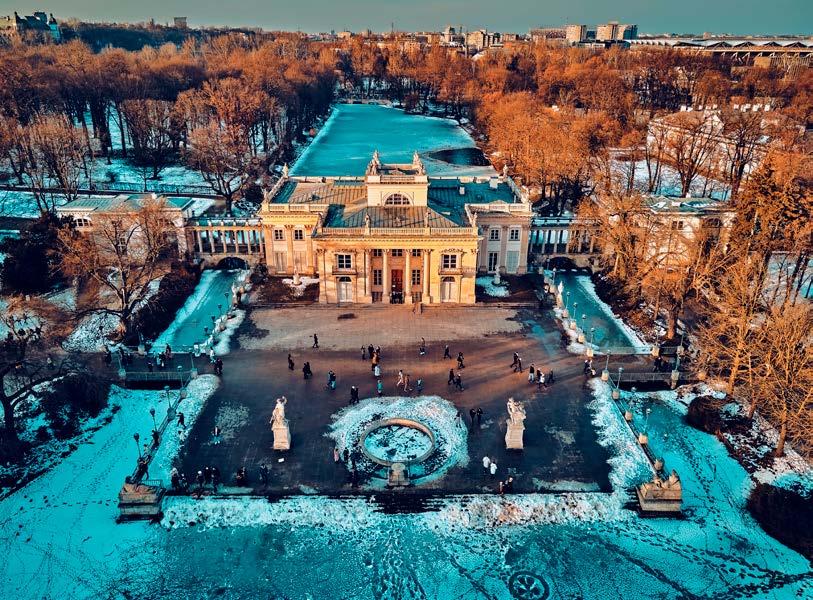
50 G H I J K G H I J K 13 12 11 10 13 12 11 10 Łazienki Królewskie Plac Na Rozdrożu Spacerowa Agrykola Politechnika W A R Y Ń S K I E G O WARYŃ SKIEGO GOWORKA PUŁAWSKA SPACEROWA AL. SZUCHA GAGARINA CZE R N I A K O W S K A MOKOTÓW LATAWIEC Rakowiecka Narbutta Wiśniowa Polna Batorego Olszewska Rejtana Zoli Litewska Koszykowa Marszałk owsk a Al. Wyzwolenia Klonowa Willowa Chocimsk a Bagatela Flory S ł oneczna Agrykola A l . U j a z dowsk i e Sulkiewicza Lądowa J a z d ó w Kręta P a r k o w a Podchorążych M yś l i wieck a S ęt pi ń s k a Szwoleżerów S i e l e c k a Kawalerii 29 Listopada Badowska Iwicka Su l igowskieg o Hołówki Zar Belwedersk a S t arościńsk a Oleandrów Nato l i ńska Czerwijowskiego Skolimowska hC o cimsk a S ł u ż e wska Kujawska W yb i e g AlSzpitalaUjazdowskiego Drag on ó w Nowosielecka Podchorążych Pl. Zbawiciela Legia Warszawa Stadium White Pavilion Sobieski Kubicki Stables Old Guardhouse Temple of Sibyl Egyptian Temple The Old Orangery Chinese Garden Water Tower Belvedere Palace The New Orangery Officer Cadets School ROYAL ROUTE ROYAL ROUTE KACZYŃSKIEGO Park Agrykola Łazienki Królewskie Park Belwederski Botanical Garden Hermitage Regent Warsaw Hotel Klonn Belwederski Reytan Belweder Residence Chopin Sienkiewicz Piłsudski Plac Unii City Shopping Former Gestapo HQ Palace on the Island Ujazdowski Castle Centre for Contemporary Art Myślewicki Palace Museum of Hunting and Horsemanship New Palm House Hippodrome Theatre on the Island Syrena 1 cm = 160 m Scale 1:16 000 0 150 300 m Aerial view of Łazienki’s centrepiece - the Palace on the Island (p.52) - frozen in winter.
Łazienki Park
This glorious 17th century park, spread over 74 hectares, is one of Warsaw’s unparalleled highlights, adored year-round by locals and visitors alike. Although it seems as if half of Warsaw spends its summer Sundays here, the park is so vast that it never feels crowded and offers an enchanting opportunity to escape the capital’s modern-day gloom and get lost in its nostalgic past. Don’t mistake Łazienki for a simple city park; it is also a museum complex full of wonderful art and architecture. Don’t miss it.
The full/proper name of today’s park is ‘Łazienki Królewskie,’ which means ‘Royal Baths’ and is derived from the park’s centrepiece and bestknown attraction, the Palace on the Island. The palace was originally built in the 17th century as a private bathhouse for Stanisław Herakliusz Lubomirski, owner of the nearby Ujazdowski Castle and much of the surrounding land (and much of Poland, come to mention it). The bathhouse was bought by the last king of Poland, Stanisław August Poniatowski, in 1772 and converted into a private residence (thus taking the name Palace on the Island). It was at this time that the grounds were formally laid out as a private garden. Perfect for romantic strolls, family picnics or cultural outings, today the park is packed with gorgeous sculptures and monuments, palatial architecture and priceless art, lovely landscapes of bridges and ponds, plus cafes, restaurants and more. With so much to see and explore, don’t be surprised to find yourself spending most of a day here
Tickets & Info
While the park is free to wander, explore and enjoy, Łazienki’s indoor exhibits require a paid ticket. To ensure that your pockets don’t fill with litter, there is now one ticket which provides entry to all of the park’s paid sites, currently: the Palace on the Island, the Old Orangery, the Officer Cadets School and Myślewicki Palace. The details of that ticket are below and all the corresponding sites have the same opening hours; tickets can be purchased at the park’s two information offices at the Old Orangery or the Officer Cadets School Note that the Museum of Hunting & Horsemanship has its own hours and requires a separate ticket.
QH-12, MPolitechnika, tel. (+48) 22 50 60 024, www.lazienki-krolewskie.pl. Park open 06:0022:00. Indoor attractions open 10:00-16:00; ThuSat 10:00-18:00; closed Mon. Combined ticket for attractions, 40/20zł; kids under 7 free; students under 26, 1zł; Fri free.
What to See Belvedere Palace
The Belvedere Palace was the residence of Polish presidents from 1918 to 1995 and then once again during the presidency of Bronisław Komorowski from 2010-2015 (Presidents Aleksander Kwaśniewski, Lech Kaczyński and current president Andrzej Duda opted to live in the Presidential Palace on ul. Krakowskie Przedmieście - p.42). Built in 1694 and thoroughly remodelled in 1818, the building is essentially offlimits to visitors, but an eyeful to behold. A wonder of Neo-Classical design, complete with tympanium and oversized Corinthian columns, the best views and photo ops are fetched from outside the park on Al. Ujazdowskie.QH-12, ul. Belwederska 56.
Chopin Monument
Don’t miss this famous art nouveau sculpture of Warsaw’s favourite son, Fryderyk Chopin. Depicting the composer right here in Łazienki beneath a willow tree, the acclaimed work by Wacław Szymankowski was erected in 1926. As part of the Nazi campaign against Polish culture it was dynamited by the Germans on May 31, 1940; as the story goes, the following day an unknown patriot placed a placard on the wreckage declaring: ‘I don’t know who destroyed me, but I know why; so I don’t play the funeral march for your leader.’ An original plaster-cast allowed the statue to be revived and this reconstruction was unveiled in 1958.QH-11.

51 Sightseeing | Łazienki Park
Zaruskiego
Mikkego Zwierzyniecka
Łazienki’s iconic Chopin monument.
Photo by Marcin Chodorowski.
Getting There
Any number of buses stop in front of the park’s three main entrances on ‘Al. Ujazdowskie’, including numbers 116 and 180 from the Old Town/Nowy Świat; get off at the ‘Łazienki Królewskie’ bus stop.
If you prefer tram, numbers 4 and 35 go to Pl. Zbawiciela, only a 700m walk south down Marszałkowska and east along Aleja Armii Ludowej. Accurate times and routes can be checked online at warsaw.jakdojade.pl.
Old Orangery
A good place to start a visit to Łazienki, the Old Orangery is one of two ticket offices and tourist info points in the park. Originally erected in 178588 to house exotic trees through the once-harsh Polish winter, the sunny structure also harbours King Stanisław August’s Royal Theatre - one of the few surviving 18th century court theatres in Europe. Constructed out of wood and covered in marblised polychromes, above the balcony boxes keen observers will notice the painted illusion of yet another level, complete with an 18th-century court audience. The theatre is still used today to host chamber concerts. The other important aspect of the Old Orangery is the Royal Sculpture Gallery. From the very beginning of his reign, Stanisław August collected hundreds of marble and plaster copies of the most famous sculptures from antiquity. 120
of the most important of these casts are uniquely displayed inside the Orangery, against a painted backdrop by court artist Johann Christian Kamsetzer designed to give the visitor the feeling of a stroll through an alley of statues in an Italian garden. Visiting time: 30mins.QI-11.

Palace on the Island
The Palace on the Island is Łazienki’s raison d’etre. Originally built as a Baroque bathhouse in 1683, the iconic structure was converted into a Neoclassical residential palace in the late 1700s by King Stanisław August. Architecturally spectacular, the palace is lies on an island in the middle of a long narrow lake, and is connected to both shores by colonnaded bridges on each side. The façades are unified by giant Corinthian pilasters that link its two floors and are crowned by a balustrade that bears mythological figures. Today almost all of the palace can be visited, including the King’s private rooms, which appear in their original context, and the extravagant Baroque reception hall A major patron of the arts, in 1793 King Stanisław August converted the palace into the first modern public museum, displaying the most important paintings from his collection of 2,289 works. Today 140 of these canvases are on display as the Royal Picture Gallery, and arranged as they would have been in the years 1793-1795. Visiting time: 45-60mins.QI-11.
Officer Cadets School
In the eastern section of Łazienki near the Palace on the Island stands a large, classical building constructed in a horseshoe plan. A smaller building which served as a kitchen for the Palace on the Island stood here in the 17th century. Seems it wasn’t large enough to serve King Stanisław August’s needs, so he expanded it into something called the ‘Great Annex’ in 1778, replete with apartments. Eventually it morphed into the Infantry Officer Cadets School in 1822, and it was from here that second lieutenant Piotr Wysocki led an uprising, aided by the young men of the school, which escalated into the nationwide November Uprising of 1830-31. Today the building houses a tourist info centre and ticket office for all of the park’s attractions, as well as some small temporary exhibits Visiting time: 20mins.QJ-11.
52 Łazienki Park | Sightseeing
Royal Sculpture Garden at the Old Orangery; photo by Waldemar Panów.
Myślewicki Palace
Built in the 1770s and 80s, this elegant semi-circular palace was originally conceived as King Stanisław August’s primary residence, though it gradually shifted to more diplomatic functions, hosting official state soirees and accommodating foreign ministers. Designed in Early Classicist style, the unique recessed entrance is decorated with mythological sculptures. After a thorough renovation, the building again appears very much as it would have in the late 18th century, and a walk through the interiors - replete with original murals, furniture and art - is worth the short amount of time it takes to see them. Visiting time: 30mins.QI-11.
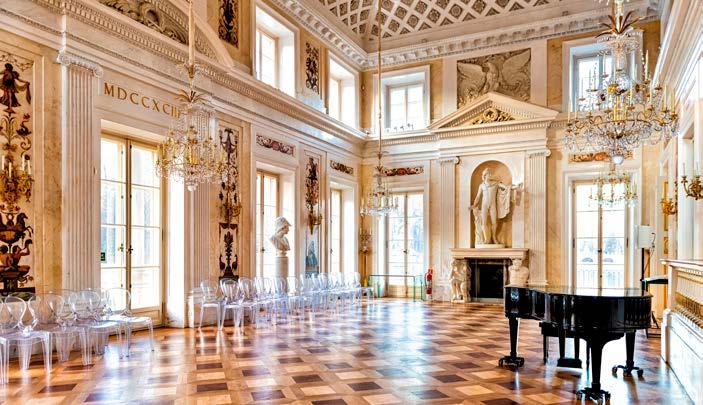
Museum of Hunting & Horsemanship
Very much as advertised, this museum will appeal to avid hunters and horse lovers, though the latter may have some trouble with all the mounted trophies. If so, you can skip the former Cantonists’ Barracks - built in 1826–1828 and full of hunting arms and taxidermied animals - and head straight to the Kubicki Stables , built 1825–1826 and home to an exhibit of horse-drawn carriages, saddles, harnesses and riding accessories; the Stables also host the Royal Weaving Workshop - featuring 19th-century Jacquard looms, ornamental fabrics, old fabric patterns and more. Visiting time: 1hr. Q J - 12, ul. Szwoleżerów 9. Open 10:00-16:00; Thu, Fri, Sat 10:00-18:00; closed Mon. Admission 16/8zł; kids under 7 free; students under 26, 1zł. Fri free.
Eat & Drink
Łazienki has several cafes and restaurants, though most of them are very pricey. Head 500m west out of the main gates to Plac Unii Lubelskiej (H-12) for more casual options.
Belvedere: Located in the park’s New Orangery, this is one of Warsaw’s most prestigious restaurants and worth the money, but not for families after a day in the park.QI-12.
Być Może: This hip cafe/bistro bakes its own bread, offers all-day breakfast and daily lunch specials, and is perfect whether you’re craving coffee or wine. (p.74)QH-12, ul. Bagatela 14.
DZiK (Dom Zabawy i Kultury): This old residence offers European cuisine and hosts a wide range of evening events, getting wild on weekends. (p.91)QI-13, ul. Belwederska 44 A.
Rest. Baczewskich: Suffused with interwar elegance, this upmarket restaurant offers exquisite Polish cuisine with a Galician touch. (p.84)QH-11, Al. Szucha 17.
Klonn: This stylish parkside resto is worth the walk for modern cuisine and excellent wine. (p.83) QH-11, ul. Jazdów 1B.
The Cool Cat TR: Inclusive, vegan-friendly and all around cool, this fusion bistro does everything from brunch, bao and ramen, to cocktails and natural wines. (p.77)QH-12, ul. Marszałkowska 8.
53 Sightseeing | Łazienki Park
Inside the opulent Palace on the Island.
Wilanów
The ‘Polish Versailles’ is just one of the many fitting monikers applied to this splendid late 17th-century 45ha palace and garden complex 10km south of the centre.
Essential visiting for anyone wishing to understand the former grandeur of the Polish capital, Wilanów is more than just a palace. As one of the few existing remnants of the era when Poland was a vast kingdom stretching from the Baltic to the Black Sea, today it also represents the European splendour and sophistication that was lost and few today associate with Warsaw. The palace, park and surrounding ensemble of buildings also represent the height of Polish Baroque and are collectively one of Poland’s greatest cultural treasures. If the weather’s good and you’ve got time to spare, it’s easy to spend most of a day relaxing and taking in the sites here.
Getting There
10km south of the centre, Wilanów is best reached by bus or taxi, though the latter costs 35-40zł and essentially takes the same amount of time: 25-35mins. All buses stop directly outside the palace gates at the ‘Wilanów’ stop. From Plac Zamkowy (F-4), Pl. Trzech Krzyży (H-8) or Łazienki Park (H-11) take buses 116 or 180. From Warszawa Centralna train station (E-8) take bus 519. For exact times and routes, check warsaw.jakdojade.pl
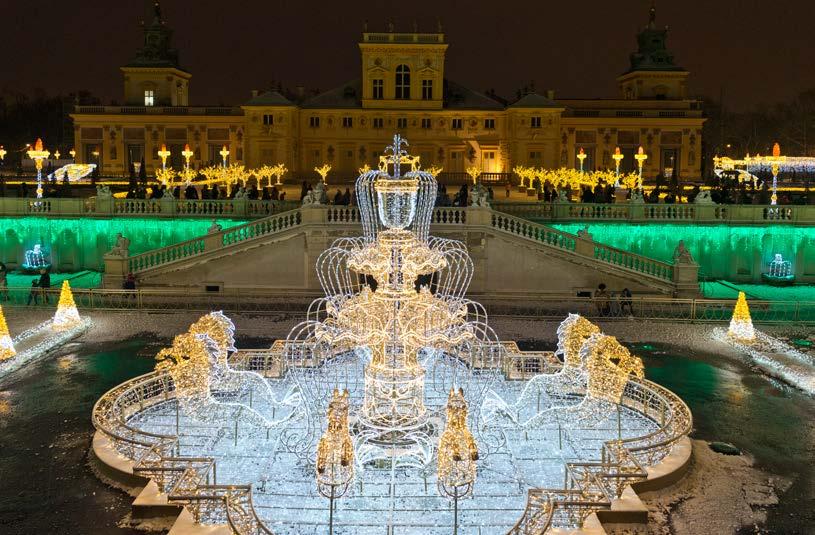
What to See Wilanów Park & Gardens
The 45 hectares that make up Wilanów Park grew over the centuries according to the particular fancies of its owners. Made up of a series of individual gardens, the park includes a two-level Baroque garden, a Neo-Renaissance rose garden, a classical English landscape park and the so-called EnglishChinese landscape park. The park’s was extensively renovationed during the 1950s, overseen by the architect and historian Professor Gerard Ciołek (19091966), made to recreate their appearance during the time of King Jan III Sobieski (p.10). The park near the Orangery, East, North and Rose gardens and their associated architecture were recently the subject of a major revitalisation program and during work on the Baroque garden a series of archaeological digs discovered several artefacts, including ceramics dating from the 12th century. Every evening, from October till the end of February, the grounds here turn into the very popular Royal Garden of Lights!QP-2, ul. St. Kostki Potockiego 10/16, tel. (+48) 22 544 27 00, www.wilanowpalac.pl. Open 09:00-16:00. From Feb 27 until March 12 open 09:00-17:00, from March 13 open 09:00-19:00. Admission 10/5zł, Thu free (0zł ticket is still required).
54
Wilanów’s ‘Royal Garden of Light’ when the Palace grounds magically light up every winter evening from October until late February!
Wilanów Palace Museum
The first museum at Wilanów was opened in 1805 by the palace’s owner at the time, Stanisław Kostka Potocki. The current museum, which takes up a substantial portion of the palace’s interior, comes in two parts. The first is the upstairs Polish Portrait Gallery - comprising room after room of portraits of the rich and the powerful from the 16-19th century. If portraits are your thing you will find this very interesting, though the lack of descriptions is frustrating. Next you’ll find yourself downstairs in the Wilanów Palace Residence, featuring residential rooms, suits of armour, Etruscan vases, magnificent frescoes and even a private chapel. Most impressive are the private apartments of King Jan III Sobieski and his wife, while the wings house the apartments of the subsequent owners of the palace. Visit the Wilanów Palace website for info about current temporary exhibits and to buy tickets. Visiting time: 2hrs.QP-2, ul. St. Kostki Potockiego 10/16, tel. (+48) 22 544 27 00, www.wilanow-palac.pl. Open 10:00-16:00. Last entrance 1hr before closing. Admission (includes park admission) 35/28zł, kids 7-16 1zł, kids under 7 free; Thu free. U
Potocki Mausoleum
An extraordinary piece of funerary art, befitting two of Poland’s most powerful, wealthy and influential families, this tomb in Wilanów Park was dedicated to Stanisław Kostka Potocki and his wife Aleksandra (nee Lubomirska) Potocka by their son Aleksander. Designed in 1834 by Henryk Marconi and built between 1834-1836 by Jakub Tatarkiewicz and Konstanty Hegl, this sandstone mausoleum consists of a Neo-Gothic canopy, with lions holding shields bearing the crests of the Potocki and Lubomirski families in each corner. On the sarcophagus itself are the figures of the deceased, and around the sides symbols of their virtues and interests are displayed.QO-2, Wilanów Park.
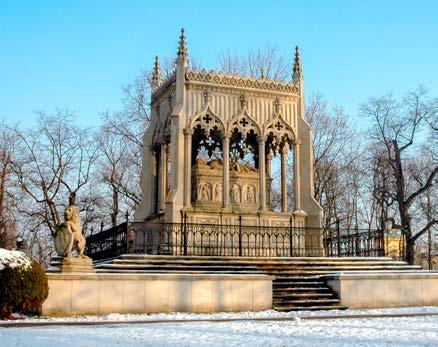
St. Anne’s Church
A church has stood on this site since the 14th century, when the wooden church of St. Leonard was built here, followed by a wooden Gothic version in the 16th century that stood throughout Sobieski’s day. In 1772 the new brick Church of St. Anne was founded by Prince August Adam Czartoryski based on a design by Jan Kotelnicki. Czartoryski’s granddaughter, Aleksandra Lubomirska Potocka, decorated the church with art in the period 1799-1831, the most precious of which is the Annunciation to the Virgin Mary in the main altar. From 1857-1870, Aleksandra’s son August and his wife extended the church based on a
Neo-Renaissance design by Henri Marconi, including adding the marvellous dome. The terracotta shrines in the surrounding gardens mark the fourteen Stations of the Cross, while the crypt houses the tombs of the Potocki family. The church suffered damage during both world wars and was even used as an internment camp by the Nazis, who looted and damaged it. The church bells dating from 1723 and 1777 survived thanks to the bravery of the local people who hid them. Today, they are housed in the newly built Third Millennium Tower.QO-2, ul. St. Kostki Potockiego 18, tel. (+48) 22 842 18 01, www.parafiawilanow.pl. Open 08:00-17:00; Fri, Sat 08:00-12:00; Sun 13:00-17:00.
55 Sightseeing | Wilanów
Potocki Mausoleum.
3 O P 3 2 2 1 O P 1 WIERTNICZA P R Z Y C Z ÓŁKOWA AL. WILANOWSKA Potocki e go Potocki e g o Kolegiacka Obornicka Janczarów Husarii Biedronki Klimczaka Pancernej Wilanów Lake Potocki Mausoleum Orangery Chinese
Entrance St. Anne's The
Poster Museum SD Gallery 1 cm = 160 m Scale 1:16 000 0 100 200 m
Photo by Fotokon / AdobeStock.
Gazebo
Wilanów Palace Museum
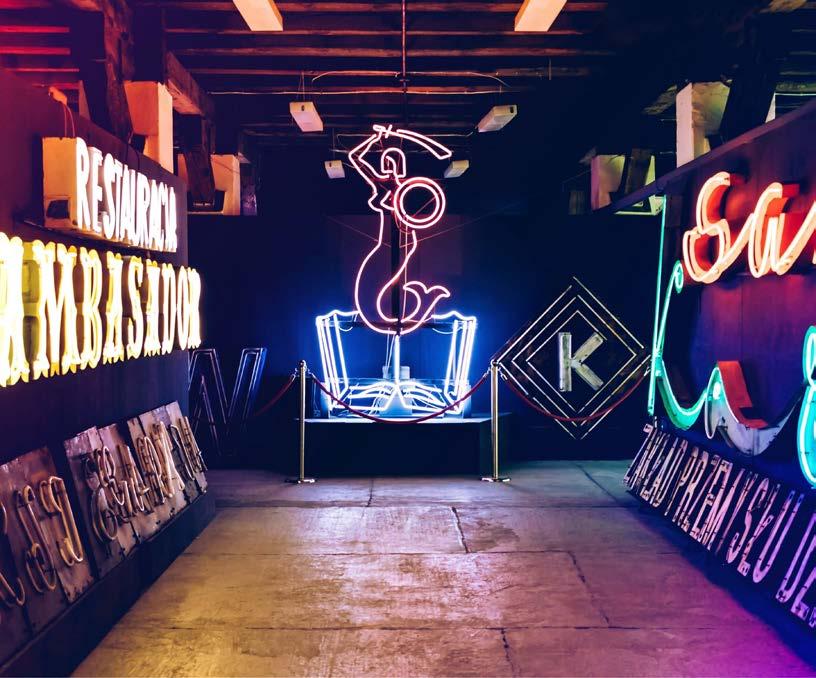
56
Alternative District Warszawa Wschodnia Warszawa Wileńska M2 Stadion Narodowy Centrum Nauki Kopernik Dworzec Wileński Szwedzka WYB.SZCZECIŃSKIE WYB. HELSKIE ZATYLNA JAGIELLOŃSKA TARGOWA STARZYŃSK I EGO "SOLIDARNOŚCI" SZWEDZKA WAŁ MIEDZESZYŃSKI WASZYNGTONA GROCHOWSKA SOLEC WYB. GDAŃSKIE POWIŚLE PRAGA STARA PRAGA OLD TOWN PRAGA-PÓŁNOC SASKA KĘPA PORT PRASKI Wyb Kościuszkowskie Bul gen Pattona Bul Flotylli Wiślanej Jakubowska Siwca Bul. Karskiego O l s z o w a Panieńska Lisieckiego Skoczylasa S z a n a j c y L inneus z a Da rw ina K ępna Sierakowskiego Łukasińskiego Jagiellońska O k r z e i Zą bkowska Sokol a Zamoyskiego B ia łostoc ka Brzeska Markowska B r e c h t a Sawinkowa W i l ńe s k a Inżynierska R a t u s z o w a Namysłowska 11Listopada Mała Środkowa S t a l o w a R ó w n a 11Listopad a Ko w i e ń s k a Zwy c ię zc ów Katowicka Styki CzeskaDąbrowiecka Lip s ka Zieleniecka Poselska Francuska Nobla Saska ąDbrówki Ang orska Niekłańska Waleczny c h Międzynarodowa G r a n i c z n a Habetina Lubelska K i j ows ka Żup n icza Kawę czy ńs ka S iedlecka Rad z ymińsk a Łochows ka Chodakowska Kamionkowska Terespolska M i ńska Augusta Biruty Stara W e ne d ó w Zaję c z a T a mk a Browarna L ipowaRadna L e s z c ńzy s ka Ok r ąg W i l a n o w s k a Solec Herberta Jaracza Lud na Bugaj Rybaki Dobra Bedna r s ka K a r o w a Ratuszowa Zamośc i e Tarchomińska Wisła Wisła CH Warszawa Wileńska Mos t Gdańs k i Ś lą s k oD ą b r o w s k i Most Pon iatowskieg o Most Świętokrzyski Al. Jerozo l imskie Park Skaryszewski ZOO Kamionkowskie Błonia Elekcyjne Park im. Janiny Porazińskiej Park Praski Jewish Cemetery Park Śmigłego -Rydza PragA!partments Hit Hetman Różycki Bazaar National Stadium Multimedia Fountain Park Copernicus Science Centre Elektrownia Powiśle BUW Library & Gardens Praga Hospital Saska Kępa Beach Poniatówka Beach Praga District Beach Museum of Printing 1 cm = 325 m Scale 1:32 500 0 200 400 m 2 5 4 1 3 Wilga ferry (May-Sept) Pliszka ferry (May-Sept) Słonka ferry(May-Sept) Neon Museum
Praga: Warsaw’s
| © Tomasz Filipek, unsplash
‘Gritty’ and ‘boho’ are just two of the terms tossed around to describe Praga, Warsaw’s east riverside district. Once disregarded due to its criminal underclass and imposing tower blocks, today an urban revival makes Praga worth visiting – especially for those looking to get off the tourist trail and see more of the city’s artsy side. The current standard-bearer for cool, folks here prefer their fun improvised and their bars dark. Filled with murals and hip hangouts, you can easily spend a day checking out the vibes of this alternative district across from the Old Town. Getting here is easy - take M2 Metro to M Dworzec Wileński
1 Praga Museum of Warsaw
Located in the oldest surviving residential buildings on Warsaw’s right bank, this modern museum boasts interactive exhibits that tell the story of Praga: its people, history, industry, bazaars and more. The cellars include the Residents’ Stories Archive and two pre-war Jewish prayer rooms with original wall paintings, and there’s even an observation terrace. Visiting time: 1.52hrs.QJ-3, ul. Targowa 50/52, MDworzec Wileński, tel. (+48) 22 518 34 30, www.muzeumpragi.pl. Open 09:0017:00; Thu 09:00-18:00; Sat, Sun 10:00-18:00; closed Mon. Admission 12/8zł, permanent exhibit only 10/7zł, temporary exhibits 5/3zł; Thu free for perm exhibit. U
2 ul. Ząbkowska
Nowhere is Praga’s revival better illustrated and its artistic vibe more felt than on Ząbkowska. Originally lined with timber frame houses, a fire in 1868 led to their replacement with tall tenements, all but one surviving WWII. Post-war neglect hit the street so hard that wholesale demolition was seriously considered, but somehow it endured and today many of the buildings have been restored and filled with lively galleries and bars. You’ll know you’ve arrived at Praga’s high street when you discover the explosion of murals and street art near ul. Targowa.QJ-3, ul. Ząbkowska, MDworzec Wileński.
3 Praga Koneser Center
Once the Koneser Vodka Factory (1897-2007), this large industrial site lay mostly derelict before getting a major revamp in recent years. Interesting from an architecture and urban renewal standpoint, the 5ha complex includes a tourist info point, the Polish Vodka Museum, the new-and-exciting Museum of Fantastic Art (p.64), several art galleries and dozens of restaurants, cafes and bars, plus shops and services amongst the apartments and offices (including Google headquarters). Host to frequent events and fairs, the premises are well worth exploring.QK-2, Plac Konesera 2, MDworzec Wileński, www.koneser.eu
Eat & Drink
Locals will tell you that the best part of Praga isn’t the sightseeing, but the nightlife. The area’s main attraction is a vodka museum after all. You’ll find plenty of restaurants, cafes and bars in and around Praga Koneser Center, along ul. Ząbkowska and ul. Okrzei. Here are a few of the most emblematic hangouts in the ‘hood.
W Oparach Absurdu: A shabby-chic boho hangout full of battered lampshades and oriental rugs, offering coffee, craft beer, cocktails and pierogi, plus frequent concerts and events.QJ-3, ul. Ząbkowska 6.
3/4 Koneser Bar: Skip the museum and head straight to this bar hidden on the 3rd floor of the Vodka Museum to try their delicious alcohol infusions and cocktails, and enjoy beautiful views. More on p.90.QK-2, Plac Konesera 1.
Bar Setki Powodów: There are 100 reasons why you should swing by, including its retro-neon chic, cocktails, a tantalising food menu and a kicking live music roster! More on p.89 QK-2/3, Pl. Konesera 1.
4 Polish Vodka Museum
Set inside a former vodka factory, this multimedia museum is visited with a live tour guide or audio guide. The experience takes you from the origins of vodka to modern production methods, showing you plenty of paraphernalia and treating you to a tasting of this strong spirit so deeply tied to Polish history. Entries are timed (PL and EN tours hourly) and it’s wise to look at all the tour options online and book in advance Visiting time: 1.5hrs.QK-2/3, Pl. Konesera 1, MDworzec Wileński, tel. (+48) 22 419 31 50, www.muzeumpolskiejwodki.pl. Open 12:00-20:00; Fri, Sat 12:00-21:00; closed Mon. Audio guides/standard tours 49zł. 6
5 Neon Museum
Yet another old industrial space turned cultural hub is Soho Factory, the biggest draw of which is no doubt the illuminating (non-pun intended) Neon Museum. The passionate curators of this private museum have collected hundreds of Communist-era neon signs, saving them from oblivion in the process. One of Warsaw’s most photogenic places. Visiting time: 30mins.QM-4, ul. Mińska 25, Soho Factory, Building 55, MStadion Narodowy, tel. (+48) 665 71 16 35, www.neonmuzeum.org. Open 12:00-18:00; Sun 11:0017:00. Admission 16/13zł, kids under 6 free. U6
57 Sightseeing | Praga
U
Art, History & Culture
Warsaw’s combination of these three is what makes it so exciting. Whether you’re an art lover, amateur historian, or tracing your roots, Warsaw’s heady brew of imperial grandeur, prewar glamour, 20th century tragedy, socialist austerity and present-day dynamism makes it unique in Europe and offers much to the visitor. Use this chapter of the guide to discover the capital’s art spaces and current exhibitions, find out about museums ranging from niche to national, and learn about sites related to some of the most important events in Warsaw’s modern history.
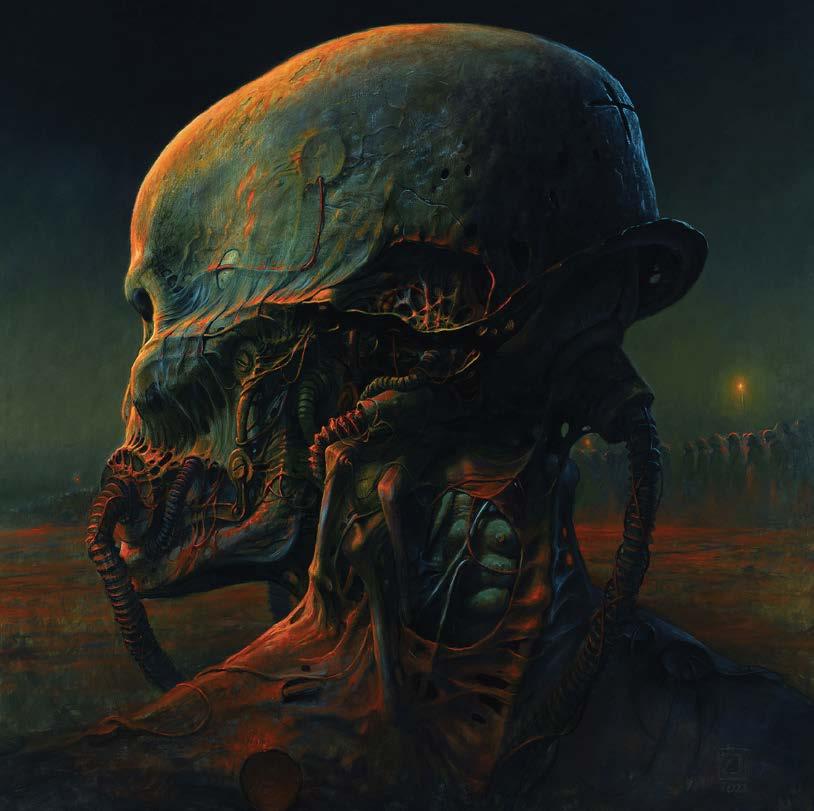
58
Dariusz Zawadzki, Przedswit - See more at Museum of Fantastic Art (p.64)
Warsaw’s Most Exciting Art Spaces
Warsaw is the centre of Poland’s contemporary art scene and home to countless pieces of priceless art. While Kraków’s collections skew more historical, Warsaw boasts a great variety of exhibits showcasing younger artists as well as the nation’s masters. When it comes to art tourism, temporary exhibits are often as or more important than permanent collections, so check the current exhibitions on p.60.
1 Zachęta National Gallery of Art
Unmissable. One of the leading art galleries in Poland, with a focus on the contemporary. Ask the locals what to do in Warsaw - they’ll send you here.
QSee p.64
2 Warsaw National Museum
Polish and European masters, Polish design, ancient African art and 5 decades of painting can all be found inside the exhibits of this stately museum.
QSee p.64.
3 Museum on the Vistula
Warsaw’s MoMA, right on the riverside in an eye-catching pavilion. Inside are provocative contemporary art exhibits by international artists.
QSee p.49.
Murals & Street Art
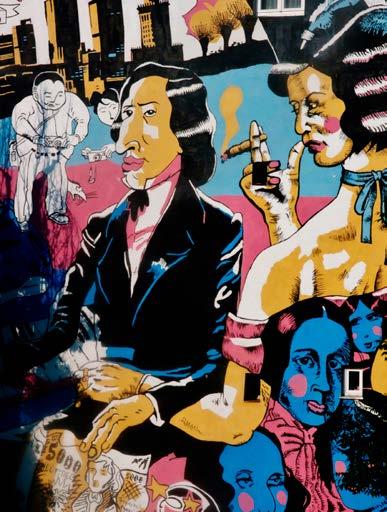
What about art in public spaces? Poland has a long, lauded tradition of graphic art, with Polish print advertising and poster design known internationally for their high artistic quality. With such a knack for graphics, it stands to reason that Poles would have a penchant for street art as well. And they do. In Warsaw both graffiti art and largescale murals are a common sight, with the city and private businesses even inviting international artists to do installations. You’ll find a particularly high volume of murals on buildings in Praga, Wola and around the City Centre, where the urban landscape is changing most rapidly. Although it’s a dynamic situation, as many murals are installed on buildings that later become designated for demolition, at WIYP we keep a close eye on murals and urban art, marking major works on all of our maps; just look for the spray can icon Not only that, but we’ve meticulously put it all online with exact GPS coordinates, so that your smartphone can do the work of leading you directly to Warsaw’s alternative artistic visions.
4 Ujazdowski Castle
Contemporary art in a rebuilt palace. One of PL’s most prestigious and provocative art centres, with an extensive program of exhibits, performances, film screenings and more.QSee p.64
5 Neon Museum
A small, but brilliantly illuminating and highly photogenic museum, displaying hundreds of historical neon signs from Warsaw’s past.QSee p.57.
6 Museum of Fantastic
Art
Celebrating Polish fantasy/surrealist art, with names like Beksiński, Duda-Gracz, Wałkuski, as well as the extremely-talented successive generation of creatives. Many works here have never been exhibited publicly until now! QSee p.64.
59 Art, History & Culture | Art Tourism
Temporary Exhibits
It’s not uncommon for some temporary exhibits to be major events, even overshadowing the permanent collections of local museums. Of the literal hundreds of art events across Warsaw, here are a few picks for the coming months. For more, as well as other events in the capital, head to our website.
09.12 - 26.03 » Jan Bortkiewicz | Weather
Report An exhibition of works by photo-artist Jan Bortkiewicz, whose body of work from the 1980s and into the present day has provided commentary on the absurdities and bizzare nature of Poland’s communist era.QI-10, Ujazdowski Castle Centre for Contemporary Art, ul. Jazdów 2, MPolitechnika, tel. (+48) 22 628 12 71, Admission 10/5zł., www.u-jazdowski.pl.
18.11
- 05.03 » Solstice | Nordic Painting
1880–1910 Over 100 works from Scandinavia’s greatest painters from between 1880 and 1910, when notable changes in subject and representation were happening in Nordic art. The exhibition concentrates on common themes found in this artistic region: nature and its impact on human life, national myths and legends, metaphysical landscapes, and the inner self.QH-8, Warsaw National Museum, Al. Jerozolimskie 3, MNowy Świat-Uniwersytet, tel. (+48) 22 621 10 31, Admission 40/25zł., www.mnw.art.pl. Open 10:00 - 18:00, Fri 10:00 - 21:00. Closed Mon.
27.01
- 09.04 » Stasys Eidrigevičius | !Reactions
Prominent Lithuanian whimsical surrealist artist Stasys Eidrigevičius’s insightful look into the human condition, and the impact of technology.QF-6, Zachęta National Gallery of Art, Pl. Małachowskiego 3, MNowy ŚwiatUniwersytet, tel. (+48) 22 556 96 00, Admission 20/10zł., www.zacheta.art.pl.
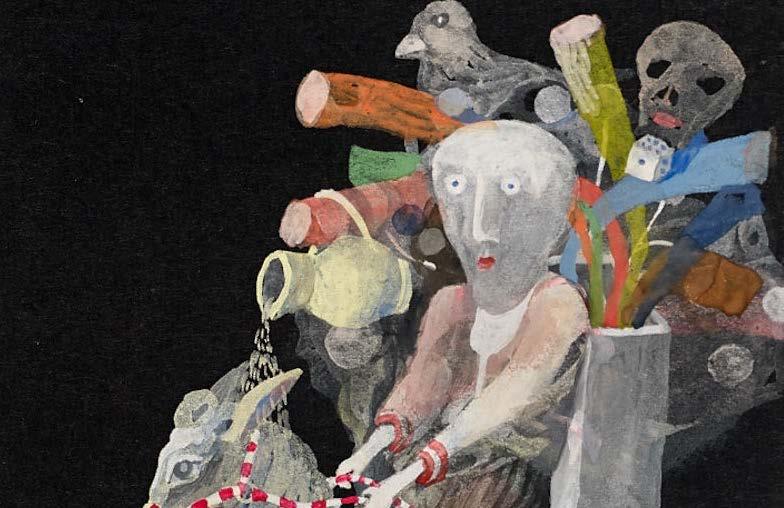
15.12 - 02.04 » Turning towards the light | Max Liebermann at the Royal Łazienki Museum
Some of the most iconic works from one of the leading figures of the German Impressionism.QI-11, Palace on the Island, ul. Agrykola 1, MPolitechnika, tel. (+48) 22 506 00 28, Admission 40/20zł., www.lazienki-krolewskie.pl
16.01 - 31.03 » Beksiński | Exhibition of Works
A concise exhibition of Poland’s famous surrealist/ fantasy artist, Zdzisław Beksiński, in numerous mediums - oil painting, drawings, inkography, photography, and more.QF-10, Warsaw Auction House, ul. Wilcza 69, MPolitechnika, tel. (+48) 609 44 45 55, Admission 30/20zł., www.warszawskidomaukcyjny.pl
60
The ‘!Reactions’ exhibition of Stasys Eidrigevičius at Zachęta National Gallery of Art.
DISCOVER POLIN MUSEUM
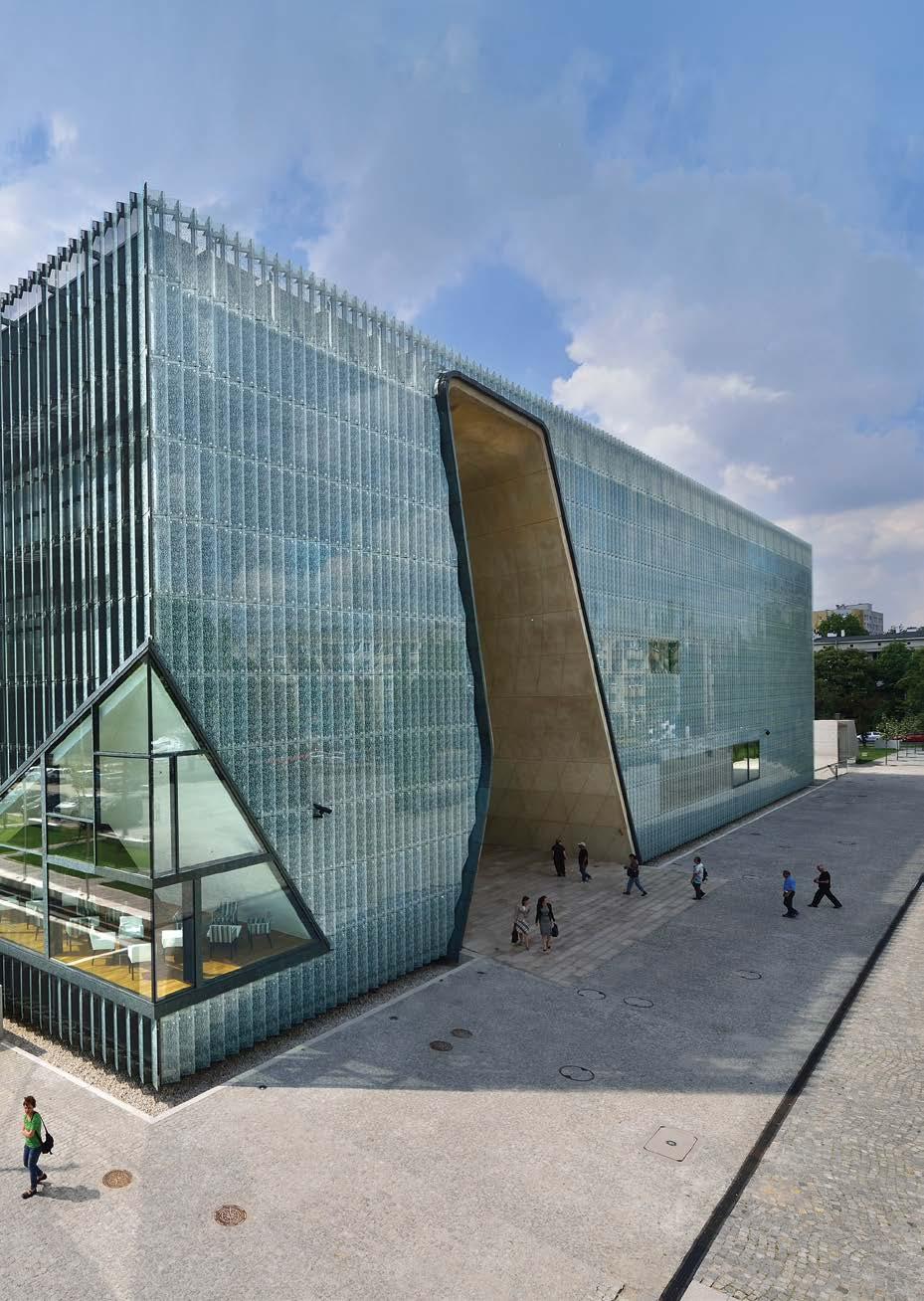
www.polin.pl
Museums

Warsaw boasts some superior museums, ranging from world-class attractions full of multimedia displays, to small institutions covering niche historical events. It’s more than we have space to cover here, but you’ll find them all listed and up-todate on our website. In this guide, some of the city’s most important museums are listed within the district tours of Sightseeing section, while the rest of the best are here. Descriptions focus on each museum’s permanent collection; for current temporary exhibits, see p.60
Apple Museum Poland
Put together from the collection of a passionate enthusiast, the museum in Fabryka Norblina (p.26) is home to around 1700 exhibits - the most complete (if not, the largest) collection of Apple computer products in the world. There are specially-prepared audio guides, in addition to flesh-and-bone guides on the floor who will gladly share their wealth of Apple knowledge with you and give a passionate run-down of the collection. Young families need not stress about their visit - for the museum’s younger visitors, there is a fantastic Game Room, with modern and vintage games readily available for the kids to play. Filled with inspiration and hands-on joy, the story of Apple has never been told in such an accessible and immersive way.QD-8, Żelazna 51/53 (Fabryka Norblina), MRondo ONZ, tel. (+48) 730 00 12 55, www.applemuzeumpolska. pl/. Open 12:00-20:00; Sat, Sun 10:00-20:00; closed Mon. Admission 45/30zł; Sat, Sun 55/40zł. PU6
Archdiocese Museum
This Old Town Museum showcases over 20,000 items dating from the Middle Ages up to today, and surprises with its wealth of secular art. Split into the Sacred and the Profane, the former includes liturgical objects, paintings and sculptures of Jesus, Mary and the saints, plus personal items of Stefan Wyszyńskiformer Primate of Poland. The latter includes lots of furniture, clocks, sculpture and paintings, including works by famous artists such as Malczewski, Hofman and even Beksiński. One highlight is entering the ‘Royal Corridor’ (aka the ‘Piekarski Corridor’) that formerly connected the Royal Castle with the Cathedral, and was built to ensure King Sigismund III Vasa’s safe passage between the two following an assassination attempt in 1620. Visiting time: 1hr. QG-4, ul. Dziekania 1, MRatusz Arsenał, tel. (+48) 22 621 34 14, www.maw.art.pl. Open 12:00-18:00; Sat, Sun 12:00-16:00; closed Mon. Admission 25/18zł. U
62
See Jan Matejko’s epic masterpiece ‘The Battle of Grunwald’ at Warsaw National Museum (p.64). Photo © City of Warsaw.
Invisible Exhibition




A unique experience where seeing impaired guides lead you into their sightless world. On the tour you’ll understand the challenges blind people face daily as you try to write with a Braille typewriter, use kitchen gadgets designed for the sightless, and solve simple puzzles while blindfold.ed Once you’re sufficiently awed by your inability to do even minor tasks, next is a series of pitch-black rooms that force you to rely on your other senses. You’ll feel the contours of a sculpture to discern what kind of art it is, listen for cars before crossing the street, and the guide will even serve you a drink in the completely dark bar (bring some cash). An eye-opening experience that will make you think about what you take for granted, to visit book online in advance. Tours in English can be arranged, but you must first email them via info@ niewidzialna.pl with ‘TOUR IN ENGLISH’ as the subject line. Visiting time: 1hr.QC-9, Al. Jerozolimskie 123A (Atlas Tower), MRondo Daszyńskiego, tel. (+48) 504 32 44 44, www.niewidzialna.pl. Open 10:00-20:00. Admission 35/31zł; Sat, Sun 39/34zł. N
Katyń Museum
Found in the Warsaw Citadel - a massive 19th century fortress - this museum documents the shocking events of 1940 when 22,000 Polish officers were executed by their Soviet captors in the middle of a Russian forest. The museum has a host of objects, documents and personal effects that have been recovered from the site near Smoleńsk, Russia. The artefacts from the victims and a scrolling list of their names need no explanation, while the multimedia presentation of the extenuating circumstances, the victims’ stories and the entire event’s historical relevancy are well thought-out and thoroughly moving. Visiting time: 2hrs.QE-1, ul. Jana Jeziorańskiego 4 (entrance from Nowomiejska gate), MDworzec Gdański, tel. (+48) 26 187 83 42, www.muzeumkatynskie. pl. Open 10:00-16:00; closed Mon, Tue. Admission free. Guided tours (EN, PL) 90-300zł. Audioguides (EN, PL, DE, FR, RU) 15zł. U
Maria Skłodowska-Curie Museum
Located in the renovated building she was born in, this charming museum pays homage to the life and work of the two-time Nobel Prize-winning physicist and chemist Maria Skłodowska-Curie (p.11). Comprising five rooms, visitors will learn about her family and early life, see a recreation of her Parisian laboratory, plus many personal effects, including her private letters and scientific instruments. Visiting time: 1hr.QF-3, ul. Freta 16, MRatusz Arsenał, tel. (+48) 22 831 80 92, www.mmsc.waw.pl. Open 12:00-18:00; closed Mon, Sun. Admission 11/6zł, Tue free. U
63 Art, History & Culture | Museums
NBP Money Centre
This FREE-entry super-modern and fantastically interactive journey through the history of world commerce - from ancient times to the present day - is great fun for both kids and adults. Along the way you’ll explore a walk-in safe, get to hold a real bar of gold (heavier than you think!) and learn how to spot fake banknotes. Closed from Jan 24 till Feb 12. Visiting time: 1.5-2hrs.QG-7, ul. Świętokrzyska
11/21, MNowy Świat-Uniwersytet, tel. (+48) 22 185 25 25, www.cpnbp.pl. Open 10:00-18:00; Thu 10:00-20:00; closed Mon. U
Ujazdowski Castle Centre for Contemporary Art
Completed in a Baroque style in 1730, burned down during WWII, replaced by a military theatre during communism, and eventually rebuilt to its original design in the 1970s, the dynamic history of Ujazdowski Castle is now matched by its current purpose - several large exhibition halls showcasing the very best contemporary art. Find a wild mix of leading Polish and international artists, plus a very good bookshop, a fantastic cinema (U-Jazdowski Kino) and a top-notch restaurant/café, plus it’s surrounded by a lovely park. Visiting time: 2hrs.QI-10, ul. Jazdów 2, MPolitechnika, tel. (+48) 22 628 12 71, www.u-jazdowski.pl/. Open 11:00-19:00; Thu 11:00-20:00; closed Mon. Admission 16/8zł to all exhibits; 2 exhibits 12/6zł; 1 exhibit 10/5zł; project room 5zł; students up to 26, 1zł; Thu free. U
Warsaw National Museum
Warsaw’s most comprehensive art museum, spanning from ancient times right through to the 19th century. Along the way you’ll see the some of the country’s most priceless works, including 15th century Dutch masters and Botticelli, plus Polish masters like Chełmoński, Matejko and Wyspiański. There’s also the Gallery of Polish Design and the Faras Gallerythe latter of which holds a rare exhibit of medieval Nubian art from the Nile River Valley, plus temporary exhibits. Visiting time: 3hrs.QH-8, Al. Jerozolimskie 3, MNowy Świat-Uniwersytet, tel. (+48) 22 621 10 31, www. mnw.art.pl. Open 10:00-18:00; Fri 10:00-20:00; closed Mon. Admission 20/10zł for permanent exhibits; kids and students up to 26, 1zł; Tue free. U
Zachęta National Gallery of Art
One of the leading galleries in Poland, with a focus on the contemporary. Located in a beautiful Renaissancestyle palace in the centre of Warsaw, and just across from the Saxon Garden, what makes Zachęta more of a gallery than a museum is that there is no core permenant exhibition on display, but rather top-notch temporary exhibits showcasing the best in Polish and international contemporary art. As a result you get leading-edge art in an old European environment. Visiting time 60-90mins.QF-6, Pl. Małachowskiego 3, MNowy Świat-Uniwersytet, tel. (+48) 22 556 96 00, www. zacheta.art.pl. Open 12:00-20:00; closed Mon. Admission 20/10zł, family ticket 25zł, students 2zł. Thu free. U6
Museum of Fantastic Art
The first gallery solely devoted to the internationally-renowned world of Polish fantasy/ surrealist art. Residing within the grounds of the Praga Koneser Center (p.57) in Warsaw’s Praga district, the Museum of Fantastic Art features the elder statesmen - Zdzisław Beksiński, Jerzy Duda-Gracz, and Wiesław Wałkuski - as well as the extremely-talented newer generation of artists who have drawn upon the legacy of their predecessors to push the boundaries even further and bring an impressive new quality to this unique artistic circle. Most of the works of art on display have never been presented to the public before, which is yet another reason why this exhibition is a must-visit for art lovers in Warsaw!
QK-3, ul. Ząbkowska 31, MDworzec Wileński, tel. (+48) 798 82 27 65, www.muzeumsztukifantastycznej.pl. Open 11:00-19:00. Admission 40/30zł.
PUL
© Zdzislaw Beksiński | CN
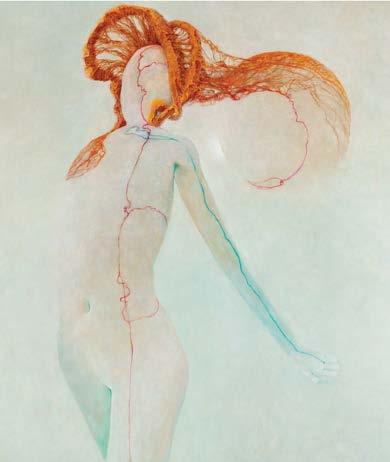
64 Museums | Art, History & Culture
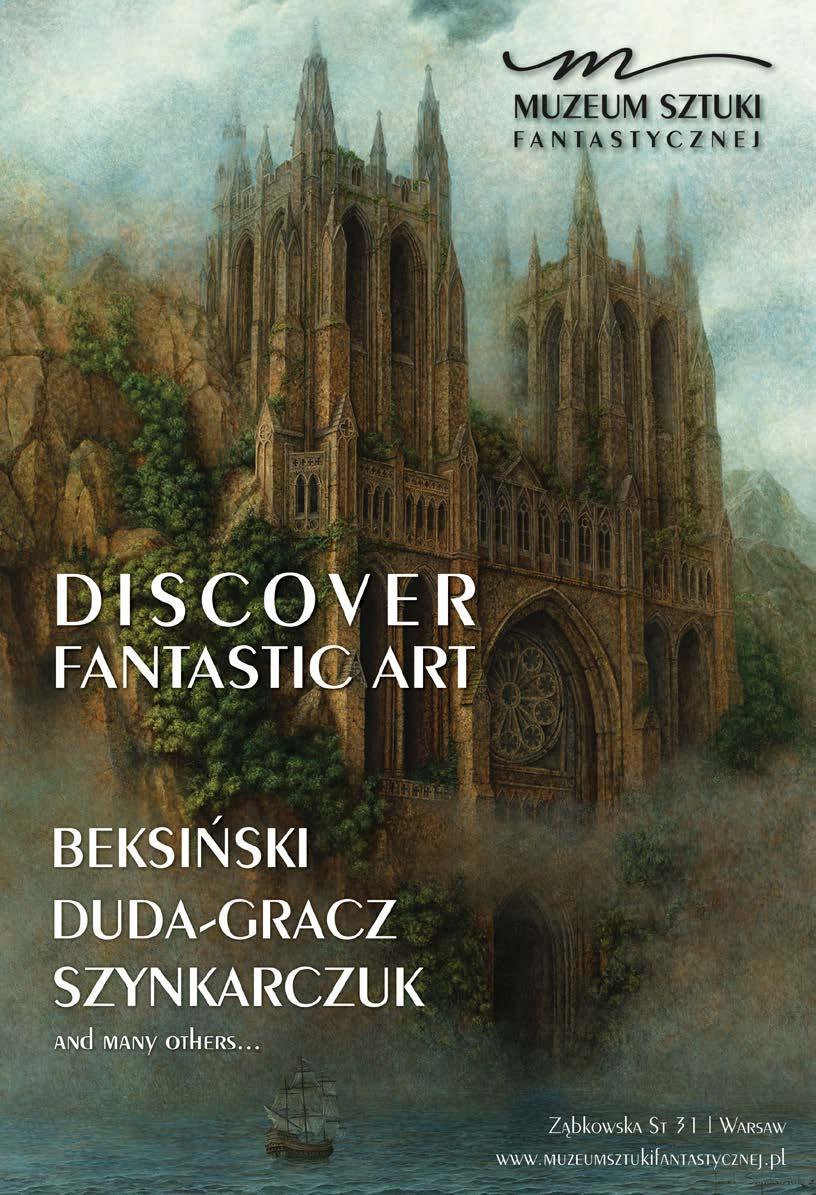
Jewish Warsaw
When Nazi Germany invaded Poland in September 1939, Warsaw’s thriving Jewish population numbered approximately 350,000 - only New York City could boast a larger community.
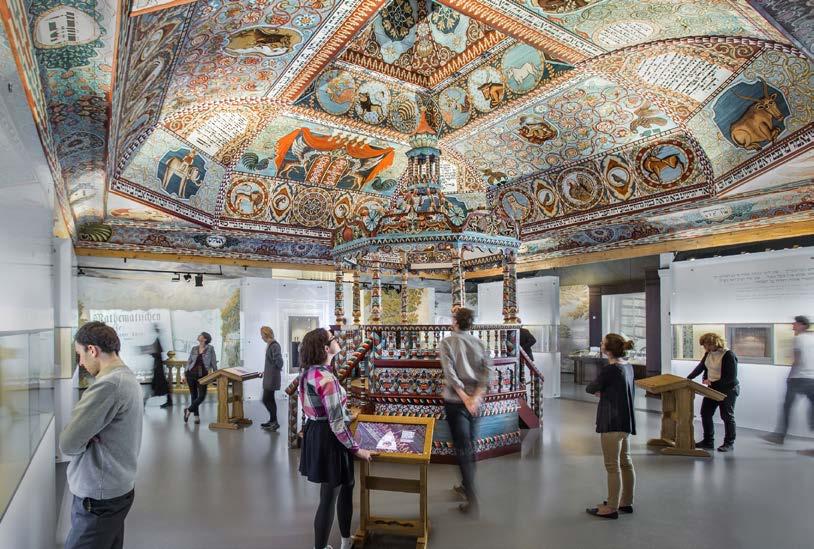
Although anti-Semitism was by no means rare, Poland had been seen as a relative safe haven, and it attracted Jewish settlers forced into flight by more discriminatory regimes elsewhere. By the inter-war years the Jewish population had made significant contributions to the social, political and cultural fabric of Poland.
As we know, Nazi occupation meant the complete dehumanisation and systematic destruction of Poland’s Jews, who were first forced into ghettos, where they faced violence, starvation and disease, and then deported to Nazi death camps where they were executed. The Warsaw Ghetto was the largest of WWII and occupied much of the City Centre, as you can see by its outline on the maps in this guide (p.2, p.23). At its height it imprisoned 460,000 Jews in an area of 3.4km2. After more than 254,000 Varsovian Jews were sent to their deaths at Treblinka in the summer of 1942, those remaining began building bunkers and smuggling weapons into the Ghetto in preparation for what would be the war’s largest act of Jewish resistance. Beginning on April 19, 1943, Jewish fighting units engaged German troops in
guerilla warfare within the walls of the Ghetto in a final, doomed act of bravery, defiance and protest against the world’s silence and inaction. When the Warsaw Ghetto Uprising ended 27 days later with the German command’s symbolic detonation of the Great Synagogue, 13,000 Jews had been killed, almost half of them perishing from the fire and smoke as the Nazis burned the Ghetto to the ground, building by building. Of the remaining 50,000 Jews, almost all of them were captured and perished at the Majdanek or Treblinka Nazi death camps.
Following WWII, much of Warsaw’s surviving Jewish population chose to emigrate to the U.S., the British mandate of Palestine (taking an active part in the creation of Israel) and elsewhere. Today Warsaw’s Jewish community is estimated at only about 2,000, but the city’s Jewish heritage remains an essential part of its identity, honoured today by innumerable monuments, memorials, museums and events, foremost among them the POLIN Museum, presenting the history of Polish Jews, and the annual Singer’s Warsaw Festival For a full list of Jewish tourism sites in Warsaw, visit our website
66
The spectacular wooden synagogue installation at POLIN Museum.
Worth Visiting
Anielewicz Bunker
Only 350m from the POLIN Museum, this small mound and memorial marks the site of the large bunker from which the Warsaw Ghetto Uprising was lead by the Jewish Combat Organisation (ŻOB). Located beneath the tenement at the wartime address of ul. Miła 18 (today Miła 2), the bunker was discovered and surrounded by the Nazis on May 8, 1943, with about 300 people hiding inside. Given the chance to surrender, half of the occupants - mostly civilians - gave themselves up, but the ŻOB insurrectionists chose to stay and fight. When the Nazis used gas to force them out, many of the ŻOB fighters chose suicide. 120 fighters died, including ŻOB commander Mordechai Anielewicz and his girlfriend Mira Fuchrer; only about 15 survived (many of whom perished later). The bodies of the dead were never exhumed and covered over with rubble from the surrounding tenements to make this mound after the war. Today two monuments can be found on/near the memorial with inscriptions commemorating their sacrifice.
Jewish Historical Institute
This amazing historical building that stood next to Warsaw’s Great Synagogue houses the Oneg Shabbat Archive, also known as the Ringelblum Archive - a secretly kept collection of documents, reports, essays, letters and other materials recording exactly what life was like in the Warsaw Ghetto, by those who were experiencing it, as it happened. As the Ghetto came under siege in 1943, the vast and carefully organised archive was secretly buried in three containers in three separate locations. Sadly, only the first two have been recovered, but they represent such extraordinary witness testimony that they were inscribed on UNESCO’s Memory of the World List. In the permanent exhibit here you will see the original documents of the Archive, the authentic containers and more. Incredibly powerful and important, if you don’t have the time for the POLIN Museum, this is a great alternative. There are also temporary exhibits and an excellent bookshop. Visiting time: 90mins.QE-5, ul. Tłomackie 3/5, MRatusz Arsenał, tel. (+48) 22 827 92 21, www.jhi.pl. Open 09:0018:00; Tue 09:00-20:00; Fri 09:0016:00; Sun 10:00-18:00; closed Sat. Admission 15/10zł. Mon free.
Okopowa Street Jewish Cemetery
A beautiful and poignant place to visit, this is Warsaw’s only active Jewish cemetery. Established in 1806 beyond the city trenches (‘okopy,’ where today’s Okopowa Street runs), the cemetery houses some 200,000 tombs and is the final resting place of many generations of Varsovian Jews, including Ludwik Zamenhof, inventor of the international language Esperanto.QB-5, ul. Okopowa 49/51, tel. (+48) 22 838 26 22, www.cemetery.jewish.org.pl. Open 10:00-16:00; Fri 10:00-15:00; closed Sat. Admission 10zł. N
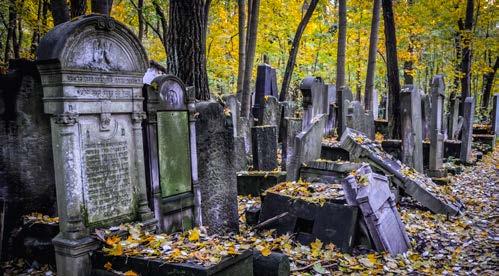
POLIN Museum
One of the best museums in Poland, the POLIN Museum explains a millennium of Polish Jewish history and relations through multimedia displays that earned the 2016 European Museum of the Year award. Located within the former Warsaw Ghetto, the modern building itself is a stunning structure of copper and glass. Inside, each gallery addresses a different era in the history of the Jewish people in PL, from the 10th century to the tragic events of the 20th. While the Holocaust is described in detail, the permanent exhibit is primarily a celebration of 1,000 years of Jewish life in PL. Exhaustive and fascinating, it takes the better part of a day to explore. The temporary exhibits are of such quality that they require their own ticket, and the museum is also home to a cafe and an excellent restaurant serving traditional Jewish cuisine (kosher dishes available). In the middle of a green public square, outside the museum visitors will also see several monuments, including a massive memorial the heroes of the Warsaw Ghetto. See website for more details! Visiting time: 3hrs.QD-4, ul. Anielewicza 6, MRatusz Arsenał, tel. (+48) 22 471 03 01, www.polin. pl. Open 10:00-18:00; Sat 10:00-20:00; closed Tue. Perm. exhibit 30/20zł; temp. exhibit 20/15zł; students and kids 7-26 1zł; kids under 7 free; Thu free. Audioguide 12zł. U
67 Art, History & Culture | Jewish Warsaw
QD-3, ul. Miła 2, MDworzec Gdański.
Okopowa Jewish Cemetery (B-4) in the Wola district. Photo by Fotokon / Adobestock.
Warsaw Uprising
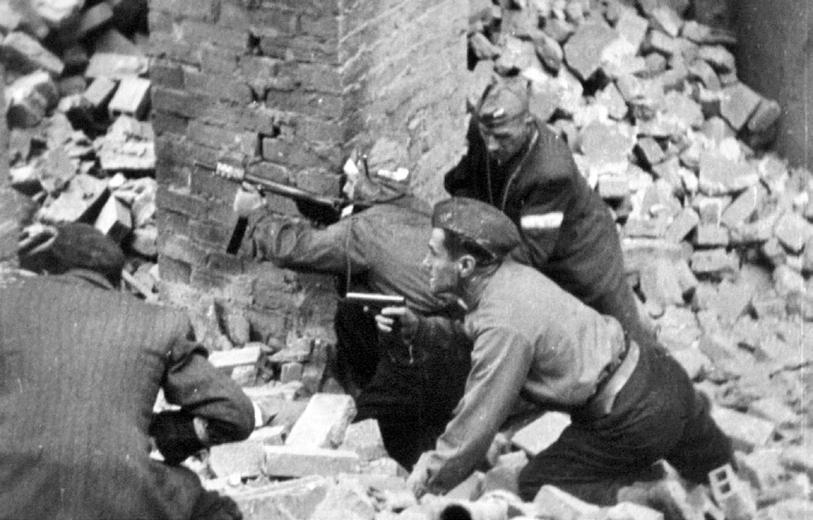
August 1, 1944 . Warsaw, subject to five years of fascist hegemony, rose up in rebellion in what would be the largest uprising in the German occupied territories.
With German morale in ribbons, a retreat from Warsaw in full swing, and the Red Army on the east bank of the Vistula, no time seemed better than the present. Following close contact with the Polish government-in-exile, and assurances of Allied aid, the Home Army (Poland’s wartime military movement a.k.a the ‘Armia Krajowa’ or AK) launched a military strike with the aim of liberating Warsaw and installing an independent government. What ensued was an epic 63-day struggle during which the Home Army faced the full wrath of Hitler’s forces.
17:00 - W-Hour
On orders from General Tadeusz ‘Bor’ Komorowski, 17:00 signalled W-Hour (‘Wybuch’ standing for outbreak), the time when some 40,000 members of the Home Army would simultaneously attack key German positions. Warsaw at the time was held by a garrison of 15,000 Germans, though any numerical supremacy the Poles had was offset by a lack of weaponry. Nonetheless the Germans were caught off guard, and the Poles captured a string of strategic targets, including the Old Town, Prudential Tower and the post office. The first day cost the lives of 2,000 Poles, yet for the first time since occupation the Polish flag fluttered once more over the capital.
Within days German reinforcements poured in, and on August 5th and 6th Nazi troops rampaged through the western Wola district, massacring over 40,000 men, women and children in what would become one of the most savage episodes of the Uprising. It was to prove a mixed first week for the Poles. In liberated areas, cultural life thrived. Better still, the first allied airdrops hinted at the support of the west. As it turned out, this was just papering over the cracks. The Germans, under the command of Erich von dem Bach, replied with heavy artillery, aerial attacks, armoured trains and tanks.
Fantastically ill-equipped, the one thing on the insurgents' side was an almost suicidal fanaticism and belief. Casualties were almost 20 times as high as those inflicted on the Germans, yet the Poles carried on the fight with stoic self-assurance. Airdrops were vital if the uprising was to succeed, though hopes were scuppered with Stalin’s refusal to allow Allied planes landing rights in Soviet-held airports. Instead the RAF set up a new route running from the Italian town of Brindisi to Warsaw, though casualty rates proved high with over 16% of aircraft lost, and the drops often inaccurate. All hopes rested on the Russians.
68
Polish Home Army soldiers in action, 1944
After six weeks of inaction Red Army Marshal Rokossovsky finally gave the go-ahead for a Polish force under General Berling to cross the river. The operation was a debacle, with heavy casualties and no headway made. This single attempt at crossing the Wisla was enough; Warsaw was on its own. Already by this time the situation in Warsaw’s Old Town had become untenable, and a daring escape route was hatched through the sewers running under the city. The Germans were now free to focus on wiping out the remaining outposts of resistance, a task undertaken with glee. Abandoned by her allies the Poles were forced to capitulate, some 63 days after they had taken on the Reich.
The Aftermath
Having deposited their weaponry, 11,668 Polish soldiers marched into German captivity. The battle had cost up to 200,000 civilian lives, while military casualties between Germans and Poles would add a further 40,000 to the figure. Remaining inhabitants were exiled (though around 2,000 are believed to have seen the liberation by hiding in the ruins), and the Germans set about obliterating what was left of the city. ‘No stone can remain standing,’ warned Himmler, and what happened next can only be described as the methodical and calculated murder of a city. Buildings of importance to Polish culture were dynamited by teams of engineers, while less historic areas were simply burned to the ground. Modern studies estimate the cost of damage at around $54bn. In human terms Poland lost much more. With the Uprising died a golden generation, the very foundation a new post-war Poland could build on.

Warsaw Rising Museum
Opened in 2004, this remains one of Poland’s best museums. Packed with interactive, multimedia displays, period artefacts, photos, video footage and plenty of sounds effects, this museum is guaranteed to leave a mark on all visitors. Occupying a former tram power station, the 2,000m2 space is split over several levels, leading visitors through the chronological story of the 1944 Uprising - provided they don’t make any wrong turns; it’s a common mistake, and, as such, an audiguide is handy (follow the numbers even if you don’t have one). Crowded on weekends, weekdays are the best time to visit, and you should set aside several hours for the experience.
Visitors start by learning about life under Nazi rule, with immersive displays including a clandestine radio station and covert printing press. The mezzanine level features a film detailing the first month of battle, including the opportunity to clamber through a mock sewer. There is also an exact replica of the B24 Allied planes used to make supply drops over the besieged city. The final sections are devoted to the creation of a Soviet puppet state, a hall of remembrance, and a particularly poignant display about the city’s destruction; take time to watch the black and white ‘before and after’ shots of important Warsaw landmarks being systematically obliterated by the Nazis.
Near the exit check out the film City of Ruins, a silence-inducing 5min 3D aerial ‘film’ that uses old photos and new tech to recreate the desolation of ‘liberated’Warsaw in March 1945. A viewing platform (open weather permitting) and ‘peace garden’ wrap up this high impact experience. Visiting time: 3hrs. QB-7, ul. Grzybowska 79, MRondo Daszyńskiego, tel. (+48) 22 539 79 05, www.1944.pl. Open 09:0018:00; Sat, Sun 10:00-18:00; closed Tue. Admission 30/25zł (kids under 7 free), Mon free. Audioguides in 27 languages 10zł/person. U

69 Art, History & Culture | Warsaw Uprising
The Old Town Market Square in ruins, 1945.
© City of Warsaw
Activities & Experiences
Hey, it doesn’t all have to be exhausting museums and knee-lifts as you explore Poland’s largest city. Check out the local activities below if you’re looking for fun alternatives to traditional sightseeing, ready to try something new, or simply want some rest and relaxation.
Hulakula Leisure Centre
This modern indoor family entertainment centre has it all. Strut you stuff on one of their 28 10-pin bowling lanes, break balls on one of 8 LEO Black King billiard tables, or go old-school with their classic arcade games, pinball machines and air hockey tables. There’s a soft-toy toddler zone, plush castle maze playground for older kids, restaurant, bar, seasonal grill and even DJ parties after the kids go home.Qul. Jagiellońska 82B, MDworzec Wileński, tel. (+48) 669 00 10 01, www.hulakula. com.pl. Open 12:00-23:00; Wed 12:00-01:00; Thu 12:00-02:00; Fri 12:00-03:00; Sat 10:00-03:00; Sun 10:00-23:00. U
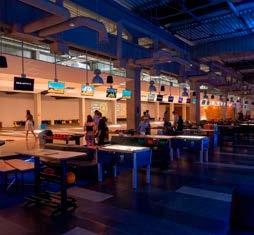
Stacja Grawitacja
Gravity getting you down? Get the bounce back in your step at this huge trampoline park that also features 3D virtual reality gaming by Hologate, a ropes course, obstacle course, basketball and volleyball courts and even a climbing wall with routes for all ages and abilities. Put on anti-slip socks and join the fun. Children ages 3-6 must be accompanied by adults; older kids can be let loose while their parents hang out at the well-stocked cafe.
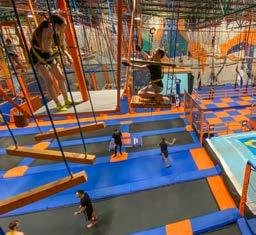
Qal. Bohaterów Września 12, tel. (+48) 726 13 06 66, www. stacjagrawitacja.pl. Open 10:00-22:00; Sat, Sun 10:00-21:00.
Thai Bali Spa
Thai Bali Spa continues a 2000-year-old tradition of massage therapy which aids in keeping the mind, body and soul healthy. Choose from traditional, oriental massages that use appropriate lighting, plus music, smell and touch to put you in a state of deep relaxation and tranquility. The skilled massage therapists - all of whom hail from Thailand or Bali - will have you feeling fresh and rejuvenated in no time. Also at ul. Grzybowska 3 (E-7).QG-7, ul. Nowy Świat 48, MNowy Świat-Uniwersytet, tel. (+48) 663 55 11 22, www.thaibalispa.pl. Open 11:00-21:00.

70
World of Illusion
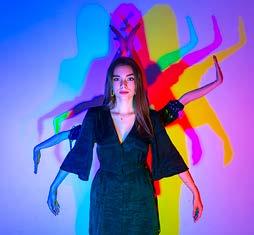
MK Bowling Entertainment Center
Found inside Galeria Młociny in the northern district of Bielany, this modern entertainment centre is just 2 mins away from the final stop of the M1 metro line ‘Metro Młociny’. Once you’re there, you have the choice of 12 bowling lanes and 3 billiards tables, all serviced with a bar (also an activity for many) that also dishes out Neapolitanstyle pizza. Call in advance to reserve.Qul. Zgrupowania AK Kampinos 15 (Galeria Młociny, 2nd floor), MMłociny, tel. (+48) 600 80 05 56, www.mkbowling.pl/start-warszawa. Open 12:00-22:00; Fri 12:00-24:00; Sat 10:00-24:00; Sun 10:00-22:00.
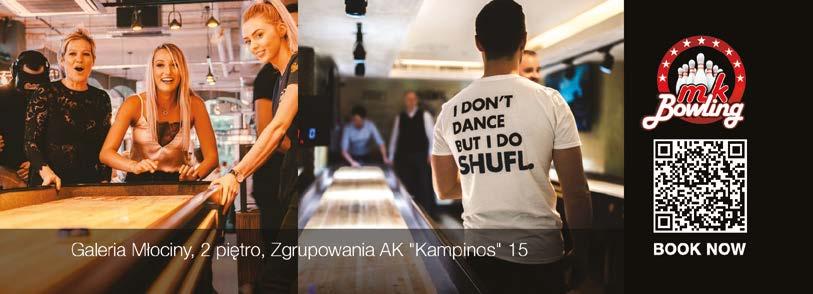
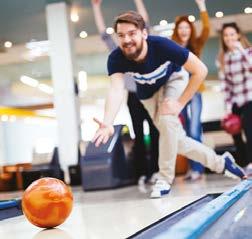
A strict break from the stuffiness of the Old Town, this fun, colourful museum is exciting and educational for all ages. Enter the Matrix, a mirror room, a vortex, the room of shadows, and a brand new upsidedown room - each and every one out-of-this world! Pefect for groups and pairs, make sure your phone is fully charged so you don’t miss these photo-ops, and go discover the extent to which the mind can be tricked by the eye.QF-4, Rynek Starego Miasta 21, MRatusz Arsenał, tel. (+48) 501 80 80 06, www.swiatiluzji.pl. Open 09:00-20:00; Sat, Sun 10:00-21:00. Admission 35/27zł. 6
Salinarium - Inhalatorium Solne
Relax in an armchair within a mesmerising salt-brick interior, whilst you experience its sensual sands between your toes, a soundtrack of calming atmospheric music, and the revitalising tang of salted air in your lungs and on your skin! Inhalatorium Solne is a certified salt therapy centre, practising the treatment of dry salt aerosol (AKA ‘halotherapy’), the healing properties of which have a tonne of respiratory and dermitalogical benefits!QD-5, Al. Solidarności 82 lok. U8, MRatusz Arsenał, tel. (+48) 512 13 70 04, www.inhalatoriumsolne.pl Open 10:00-20:00. Admission 25/22zł.

71
Kids & Families
While Warsaw has plenty of wonders, not every cultural site is going to be engaging for young visitors. The first step to having a successful family vacation is probably to just accept that what you and your kids want to do are not going to be one and the same. That said, there’s common ground to be found in some of Warsaw’s most popular attractions.
Wandering the Old Town (p.32) or Łazienki (p.50) will likely please everyone, as will a walk along the Vistula Boulevards (p.46) - a great outing with plenty of diversions like riverside playgrounds, and the Copernicus Science Centre (p.48), In Fabryka Norblina (p.26) you’ll Smart Kids Planet (p.73), the first ever ‘edutainment’ centre in Poland, as well as Apple Museum Poland (p.62) with an interactive section of modern and vintage games!
Although it may sound more like punishment, kids really respond to the interactive exhibits of the highly modern Warsaw Rising Museum (p.69), which features areas designed specifically for young visitors. Some of Warsaw’s more niche museums like the NBP Money Centre (p.64) and Photoplasticon (p.73) are also good choices for families. Slightly older children, as well as those who are showing creative potential, should spend some time in the Museum of Fantastic Art (p.64) as well as the other galleries listed on p.59. On bad-weather days, don’t forget that Warsaw has plenty of other action-packed indoor attractions (p.62).

Panoramic viewpoints are also a winner with kids, so in addition to those at the Rising Museum and University Gardens, check out St. Anne’s tower (p.40) near Plac Zamkowy, and the viewing terrace on the 30th floor of the Palace of Culture & Science (p.26).
Pinball Station
Listen here, sonny boy. Back in the days before every whippersnapper on the block had a gaming console in their blue jeans, folks used to go down to the arcade and play the pinball machines for a little entertainment. Relive those pre-digital days in this wildly fun and nostalgic pinball museum, featuring over 100 working machines you can actually play on, some of which date back to the 1930s. A great place to introduce this old school game to younger generations, admission gets you unlimited play for the entire day; you can even leave and come back later.QB-9, ul. Kolejowa 8A, MRondo Daszyńskiego, tel. (+48) 600 63 31 15, www.pinballstation.pl. Open 12:00-22:00; Fri 12:00-24:00; Sat 11:00-24:00; Sun 11:00-22:00. Admission 45/39zł; kids under 12, 29zł.
72
In addition to bouncy floors, Stacja Grawitacja (p.70) also boasts the best 3D VR gaming experience in Poland!
Warsaw Photoplasticon
Hidden in a darkened pre-war tenement near the train station, a visit here really is a trip back in time. A popular form of entertainment in the pre-cinema era, a ‘photoplasticon’ is basically a 3D peep show (no, not the saucy kind) where visitors sit in front of a viewing station to see vivid photos as they slowly rotate by. Although photoplasticons were quickly made obsolete by moving pictures, this one, which has been located here since 1905, somehow stayed open! Check online to see what’s loaded into the machine (does it matter?) from their collection of over 7,000 stereoscopic images of times, places and people long gone. Visiting time: 20mins.QF-8, Al. Jerozolimskie 51, MCentrum, tel. (+48) 22 629 60 78, www.fotoplastikonwarszawski.pl. Open 10:00-18:00; closed Tue. Admission 10/6zł; Thu free.
Warsaw Zoo
Opened in 1928, Warsaw Zoo covers an area of 40 hectares and attracts some 500,000 visitors each year. In total there are 13,000 animals here, across 500 species. Conditions have improved dramatically in recent years, though a visit here will do little to change any opinions you have on locking animals in cages. QH-3, ul. Ratuszowa 1/3, MDworzec Wileński, tel. (+48) 22 619 40 41, www.zoo.waw.pl. Open 09:0018:00; Sat 09:00-19:00. Admission 30/20zł.
Smart Kids Planet
Young families visiting Warsaw need not worry about wholesome and constructive fun for the kids! Head along to Fabryka Norblina (p.26) and you will find Smart Kids Planet - the first edutainment center in Poland, that is, a recreational format that bridges the gap between playrooms and science centers. Divided into 9 thematic zones and with over 50 engaging activities throughout, young minds can journey through many different worlds - building construction, food and fresh produce, sports, the magic of machinery and production lines, and right out into the cosmos with their very own designs coming to life before their eyes! It’s a world of limitless imagination and exploration, whilst at the same time, children increase their understanding of new technologies and the environment, learn how to cooperate and problem-solve, and expand their minds to the wondrous possibilities of the universe. For parents, Smart Kids Planet also includes 3 rest zones, a cafe with a kids menu, and the Smart Kids Store (p.98) where different products allow for the educational fun to be continued at home! For children aged 0-10 QD-8, ul. Żelazna 51/53 (Fabryka Norblina), MRondo ONZ, tel. (+48) 727 77 08 80, www. smartkidsplanet.pl/. Open 09:00-20:00. PUL

73 Activities | Kids & Families
Dining in Warsaw
Nowhere is Warsaw’s vibrancy and diversity more apparent than in its progressive culinary scene. What follows are some of the most noteworthy dining establishments in the capital, divided into basic categories with the type of cuisine listed under the venue name; for more options visit our website. In terms of tipping, 10% is standard (easy math). Smacznego!
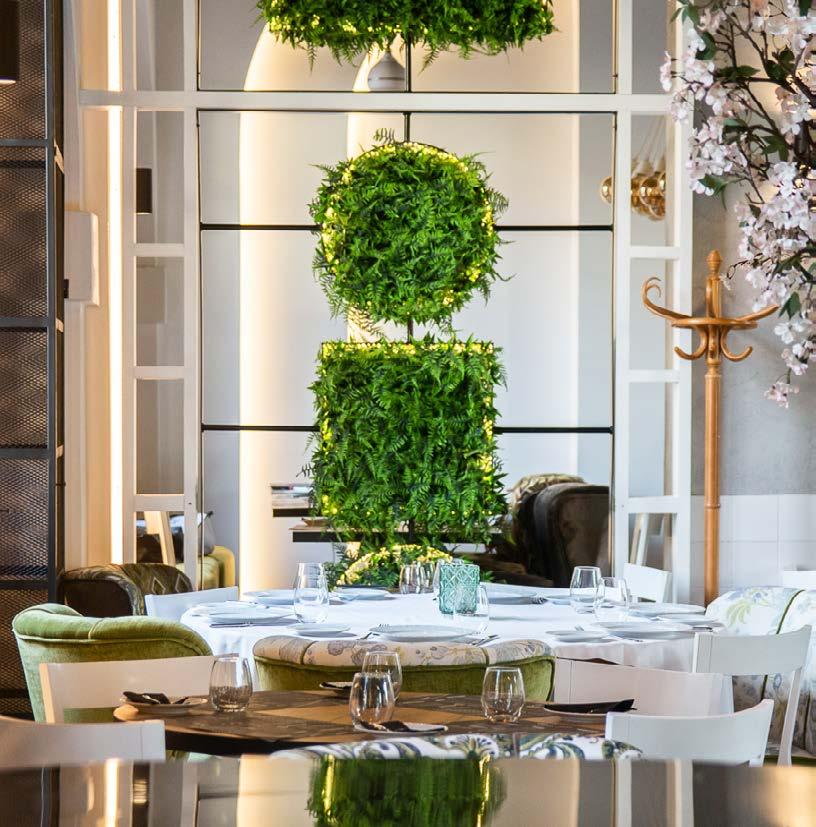
74
The lush modern decor within U Kucharzy w Arsenale’s historic location (p.85).
Beef n’ Pepper
utensils Steak

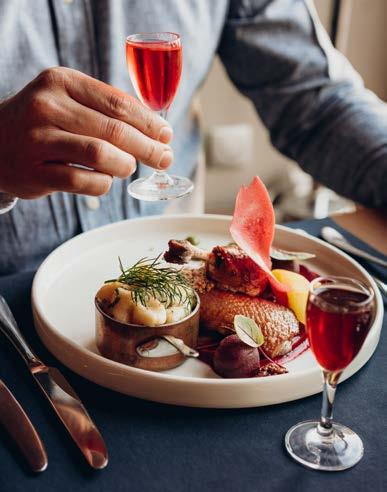
Hidden away in a small alleyway alongside the famous Roma Theatre, the exterior may look like you’re about to enter a 1970’s Texas shopping mall, but inside it’s a smart, urban steakhouse and bar. The quality of the cuts here is excellent (28 days wet-aged or 30 days dry-aged) and the fact that they use the finest local meats means the prices are surprisingly reasonable. Seafood and Louisiana Chicken Wings struggle for a lookin as beef rules. In addition to a fine wine list, the slick bar has a brilliant selection of whiskies and bourbons, and there’s live music every Tuesday from 19:00.
QF-9, ul. Nowogrodzka 47A, MCentrum, tel. (+48) 785 02 50 25, www.beefandpepper.pl
Open 12:00-23:00; Fri, Sat 12:00-01:00; Sun 12:00-22:00.
€€€€.
TUE6
Elixir by Dom Wódki
utensils Polish
Top marks to the masterminds behind this classy establishment, especially for individualism! At their Vodka Atelier you can try over 600 vodkas from around Poland and the globe; the range goes from PRL era classics to Polish ‘small batch’ distillers, designer vodkas, flavoured vodkas and culminates in the staggeringly priced Młody Ziemniak (25ml for 50zł). The stunningly-presented, contemporary takes on Polish classic dishes are accompanied by a unique food and vodka pairing system, which recommends specific vodkas to complement the ingredients and flavours of each dish! Such a system is unrivaled anywhere in Poland and the world at large, so this spot is an Absolut (pardon the pun!) top-spot and a truly unique venue on Warsaw’s culinary map. Kitchen open until 23:00.
QF-5, ul. Wierzbowa 9/11, MRatusz Arsenał
tel. (+48) 22 828 22 11, www.domwodki.pl.
Open 12:00-24:00.
€€€€. T
75 Dining | Featured
Breakfast & Brunch
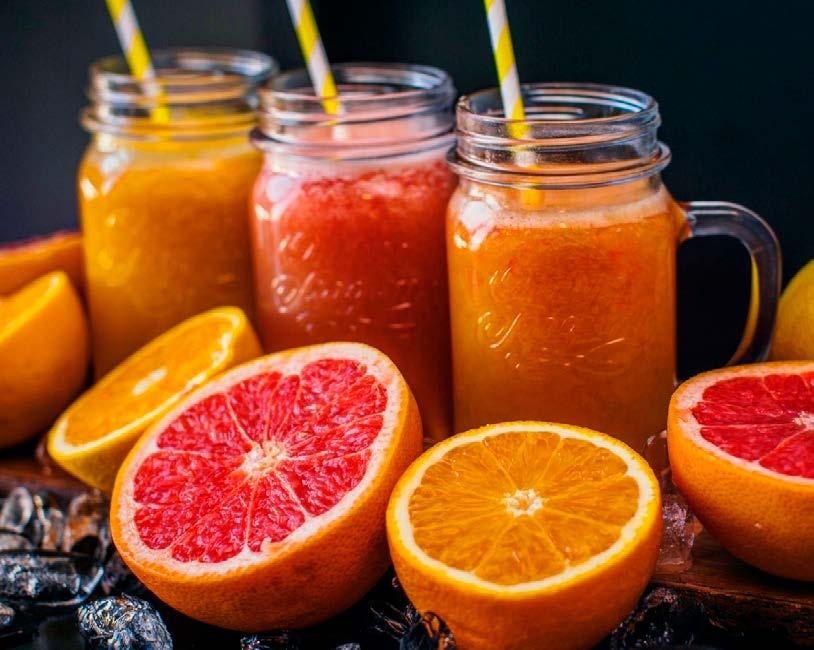
For some the direction of the day depends on the ability to eat a good breakfast, so we’ve highlighted some of our favourite places in Warsaw that specialise in śniadania (the Polish word for breakfast). Whether you’re an early bird that’s tired of eating worms, or a late riser that overdid it a bit last night, get a good first feed in the places listed here.
Być Może
Start your day with the aroma of coffee and croissants in this sophisticated French bakery/bistro in the heart of Powiśle. Filling breakfasts include their fresh-baked bread and are served all day. Choose from stacked bagel sandwiches, shakshuka, French toast, loaded oatmeal, granola or chia pudding bowls, or their take on the notorious Croque Madame. When it comes to our tastes, the poached egg (something we’ll never master at home) reigns supreme, and is featured in several hearty sets (Eggs Benedict, Eggs Florentine) we’re working our way through, and then later working off via walks along the river. Find a second location at ul. Bagatela 14 near Łazienki Park (H-12).QI-6, ul. Dobra 22/24, tel. (+48) 519 00 00 14. Open 07:00-22:00. T6
Charlotte. Chleb i Wino
This French bakery/bistro is already a popular breakfast spot, and a communal table in the centre of the restaurant is a genius solution for the many solo diners ducking in for a pastry and a latte. Enjoy croissants with jam or traditional egg dishes anytime since trendy Charlotte slings all day breakfast. All ingredients are sourced locally, and vary depeneding on the season. Their chocolates and jams are made with home recipes, giving that extra dose of niceness. Also found at ul. Próżna 7, Nowy Świat 6/12 and ul. Kieślowskiego 7 QG-10, Al. Wyzwolenia 18 (entrance from Pl. Zbawiciela), MPolitechnika, tel. (+48) 508 90 92 22, www.bistrocharlotte.com. Open 07:0024:00; Fri 07:00-01:00; Sat 08:00-01:00; Sun 08:00-24:00.
T6
76
Get energised with fresh juices from Vita Cafe in Browary Warszawskie (p.14)
Chaud Pain
A lovely French bakery and a rare encounter with a French-language pun: Chaud Pain (Hot Bread) sounds like the last name of Warsaw’s darling, Fryderyk Chopin (p.11). This airy boulangerie just off Krakowskie Przedmieście churns out artisanal breads, baguettes, croissants, pastries and other baked deliciousness. Some of their creations are turned into tasty sandwiches, which you can grab to go or enjoy at their counters with a cup of good coffee. There’s even a delicatessen section with high-quality caviar, canned seafood, meats, cheeses and more. Très chic.QG-5, ul. Ossolińskich 3, MNowy ŚwiatUniwersytet, tel. (+48) 797 01 29 41, www.chaudpain. pl. Open 08:30-19:00; Sat 09:00-19:00; Sun 08:30-18:00.
TU6
Croque Madame
A mighty fine French-style cafe, bakery and cake shop which neatly manages to walk the difficult line of being neither too trendy nor too oldfashioned, attracting a nice mix of customers as a result. The beautiful interior is all delicate whites and pale greys and the attention to every detail is immediately noticeable. Enjoy an all-day breakfast (Polish & French style), soups, entrees, freshly made sandwiches and light and colourful salads while marvelling at the daily selection of cakes and sweets. Whatever you decide to order (it’s not easy), it all comes simply, yet perfectly presented, served by staff who genuinely seem be as pleased as their customers to be there. Q G - 7, ul. Nowy
Świat 41, M Nowy Świat-Uniwersytet, tel. (+48) 531 43 13 00. Open 09:00-22:00; Fri, Sat 09:00-23:00.
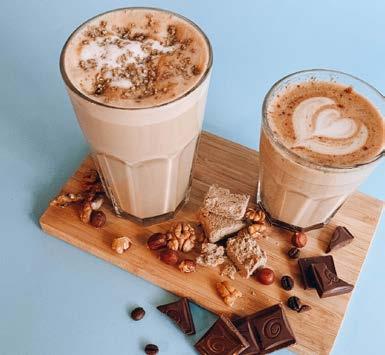
B6
SAM Powiśle
At this stellar bakery/bistro it all starts with their own artisanal bread, which forms the basis for many of their breakfast options (served all day), including stacked bagels, sandwiches, French toast and more. But SAM offers a wide menu of delicious, diverse and healthy dishes, including many vegetarian/vegan and gluten-free options, plus vitamin-rich juice cocktails. Taking their healthy philosophy further, everything they offer is all natural and made from scratch. With such strong credentials, and a location next to the University Library, you can bet it’s popular, so don’t be surprised by slow service at peak times; the full house of hipsters let’s you know it’s worth the wait. Also at ul. Twarda 4 (Plac Grzybowski, E-7). Q H - 6, ul. Lipowa 7A, M Centrum Nauki Kopernik, tel. (+48) 600 80 60 84, www.sam.info.pl . Open 08:00-22:00; Fri, Sat, Sun 09:00-22:00. €€. TU6
The Cool Cat
One of our favourites, The Cool Cat is part Asian-fusion bistro, part cocktail dive bar, all Varsovian awesome. If you need evidence that this laidback cult hangout has hipness to spare, they sells jars of their own vegan mayo and kimchi. In terms of dining in, The Cool Cat specialises in ramen (of course) and serves an iconic bao donut dessert topped with matcha ice cream and caramel miso. The best time to visit is all the time, but especially on weekends, when epic 37zł brunches are served until 14:00 (don’t sleep on this one!). They also have weekday lunch specials for only 30zł (12:0016:00), exceptional coffee, wacky cocktails, craft beer and natural wines. Honestly, there’s no reason not to be here. 2nd location at ul. Marszałkowska 8 (H-12).
QI-7, ul. Solec 38, MCentrum Nauki Kopernik, tel. (+48) 574 81 18 16. Open 10:00-21:00; Fri 10:00-22:00; Sat 09:30-22:00; Sun 09:30-21:00. €€. T6
To Lubię
Escape just beyond the medieval confines of the Old Town walls to find this charmingly twee cafe specialising in coffee, cakes, quiche and delicious fruit crumbles. If you enjoy Kraków’s cosy cafe culture, this spot is right up that alley, as opposed to the capital’s overabundance of postindustrial spaces with modern, minimal furnishings. When it comes to indulging in aromatic coffee and rich cakes, we’ll take the former. Breakfast is served all day, as well as wraps and some savoury snacks. In winter this is a great spot for wrapping up in a blanket and drinking some hot cocoa or warm mead. The name translates to ‘I like this’ and indeed we do.QF-3, ul. Freta 8, MRatusz Arsenał, tel. (+48) 22 635 90 23, www.tolubie.pl. Open 09:00-22:00. €. 6
77 Dining | Breakfast
Warm up to the day with dobro&dobro cafe in Browary Warszawskie (p.14)
Casual dining
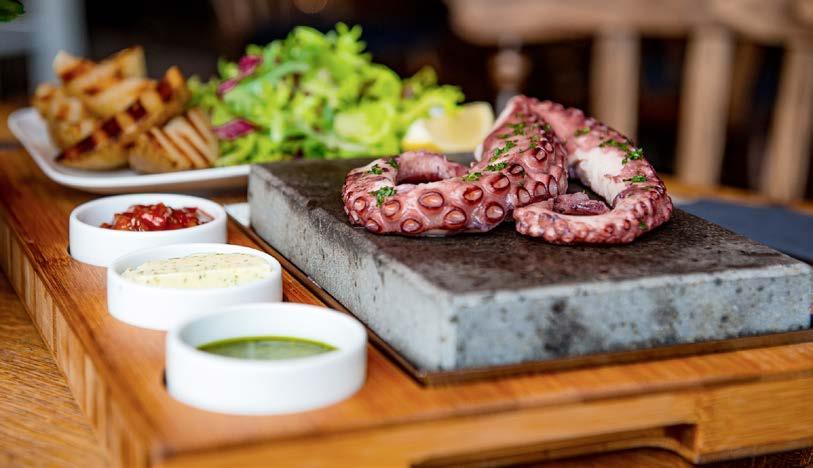
Sometimes you just need a casual and convenient place to relax, enjoy good food, vibes and hospitality. The following venues deliver in that regard. While our listed opening hours seem self-explanatory, be aware that some venues close their doors if business is slow, while others stay open after the kitchen has closed. In such cases, the hours we list are for the kitchen.
Browar Warszawski
The revamped Warsaw Brewery is one of the largest, most modern brewpubs in the region, producing 19 craft beers on site, from contemporary IPAs to legacy ales from the days of the Haberbusch & Schiele Brewery. Choosing is hard, so try a tasting set. The menu is tailored to complement your liquid meal, and includes a truffle burger, fresh seafood, platters from the Josper grill, plus veggie options, signature cocktails and single malt whiskys. The post-industrial interior has plenty of intimate spaces, and also gives you a peak at the brewing process. All around a top venue for drinks, dining and making the rounds.QC-7, ul. Haberbuscha i Schielego 2, MRondo Daszyńskiego, tel. (+48) 799 00 00 21, www.browarwarszawski.com. Open 16:00-24:00; Sat 14:00-24:00; Sun 14:00-22:00. €€€. E
& Price Key
Ciao Napoli
Extremely popular with the locals, Ciao Napoli brings a charming slice of Naples to the centre of Warsaw, and its location near the Old Town square offers plenty of space and an extensive menu without compromising on the friendly cosiness that they’re known for. With greatness comes exclusiveness, and they are now only open from Friday to Sunday. It’s certainly worth the wait, however, with a fantastic selection of antipasti, salads, seafood, and desserts, and, of course, their Neapolitan pizzas with fantastic thin and crispy dough that sets this place apart from others. Lunch is only available on Fridays, as is their happy hour, where you can grab 2 selected cocktails for the price of one! Second location at Wąski Dunaj 4/6/8 (F-4)QF-3, ul. Długa 6, MRatusz Arsenał, tel. (+48) 666 32 27 33, www.ciaonapoli.pl. Open Fri, Sat 12:00-23:00, Sun 12:00-22:00 only. €€. TB6
€ most mains under 25zł
€€ most mains 25-45zł
€€€ most mains 45-75zł
€€€€ most mains 75-115zł
€€€€€ most mains over 115zł
78
Award-winning culinary curiosities at The Alchemist Grzybowska (p.80).
utensils Category of Cuisine E Live music C-1 Map Coordinate N Credit cards not accepted M Metro o Year-round Garden T Child-friendly X Smoking room available U Facilities for the disabled 6 Animal friendly
Symbol
Clash Restaurant & Bar at NYX Hotel Warsaw
Making a hotel more than just a place for its sleepover guests, NYX has created an inviting firstfloor space where urban art and culture collide, and anyone can drop in. With an open floor plan that features traditional dining areas flowing into more casual zones with sofas and armchairs, The Clash’s unique visual aesthetic includes retro and modern furnishings, elegant place settings and gold cutlery, plus edgy photography and street art installations. Dine on a unique fusion of Polish-Israeli cuisine, order a signature cocktail, or challenge their bar staff to make you a custom drink. Take advantage of Happy Hour specials from 17:00-19:00, and don’t be surprised to hear live bands or a DJ dialling up the vibes (check their FB to see what’s on).QD/E-8, ul.
Chmielna 71, MCentrum, tel. (+48) 22 346 29 00, www. leonardo-hotels.com/nyx-hotel-warsaw. Open 14:3023:00. €€€. TUE6
Czerwony Wieprz
Workers of the world unite around a large choice of well-presented Socialist Bloc cuisine. Deriving its name from a former meeting place for members of the early communist movement, legend has it that even Lenin paid this place a visit in 1909. The interior is based on the style favoured by the 1950’s -1960’s party elite, and the walls are bedecked with memorabilia of the era. Somehow the owners have managed to carefully side swerve tackiness and the whole experience has a lovely, faded and nostalgic glam to it. Immensely popular with locals and tourists alike (including Bruce Willis, Lennox Lewis and the Real Madrid football squad), 2012 saw ‘The Hog’ voted one of the 25 best and most interesting restaurants in the world by the Spanish Trade Leaders’ Club. Keep their lunch menu in mind, on offer from Mon to Fri, 12:00-16:00. Kitchen is open till 22:30.QC-7, ul. Żelazna 68, MRondo ONZ, tel. (+48) 22 850 31 44, www.czerwonywieprz.pl. Open 12:0024:00. €€€. TUB
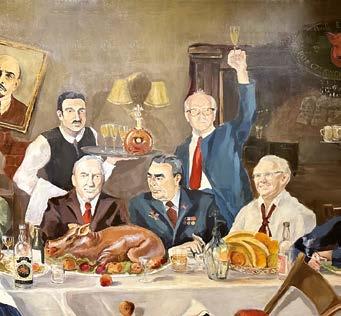
Gościniec Polskie Pierogi
You can’t visit the capital of Poland without trying some traditional Polish food, right? Gościniec has just that - hearty soups, plump dumplings, potato pancakes and various cutlets - all prepared ‘as they should be’ and at very reasonable prices. You can’t go wrong with pierogi, but we’d personally recommend the pork chops or cabbage rolls stuffed with meat (known locally as gołąbki: go-womp-ki). The drinks on offer are quite funky (cold/hot options), and it’s all served up by friendly staff wearing folk attire. Kitschiness aside, but the food hits the mark and the portions are immense. Additional locations at ul. Nowy
79 Dining | Casual
Świat 41 (G-7), and deep in the Old Town at ul. Podwale 19 and ul. Piwna 14 (F-4).QG-5, ul. Krakowskie
Przedmieście 29, MRatusz Arsenał, tel. (+48) 22 273 69 36, www.gosciniec.waw.pl. Open 11:00-22:00; Fri 11:0023:00. €€. T6
Gospoda pod Zygmuntem
Located directly between the Royal Castle and the Old Town Square, this veteran Polish restaurant is as simple and traditional as it gets. A good option for tourists, families and anyone looking for their first foray into Polish cuisine, the modestly-priced, bilingual menu includes photos of almost every dish. There is a lot to choice, from classics like pierogi (15 types), potato pancakes with goulash and mushroom soup served in a bread bowl, to old school staples that have dropped off most modern menus like tripe soup and chicken livers with fried onions and baked apples. With a tidy, colourful interior and fast service, the experience is easy, accessible and satisfying.QF-4, ul. Świętojańska 15, MRatusz Arsenał, tel. (+48) 22 428 39 43, www.gospoda. waw.pl/. Open 11:00-22:00; Fri 11:00-23:00. €€. T6
Namaste India
Over seventeen years ago, what began as a modest Indian-owned grocery store quickly developed by demand into multiple full-service restaurants. This - the expanded original location - remains the consensus best Indian food in the capital, just ask anyone who lives here. The prices are set so low you can’t help but wonder what’s the catch - there isn’t one; we’ve tried the entire menu and it’s all delicious. Consider ringing ahead for takeaway because waiting times can be torture and ask about booking their private room for parties and meetings.QG-8, ul. Nowogrodzka 15, MCentrum, tel. (+48) 22 357 09 39, www.namasteindia. pl. Open 11:00-23:00; Sun 12:00-22:00. €€.
Tehran Restaurant
Experience new tastes and celebrate Warsaw’s multiculturalism in Tehran - the capital’s only authentic Persian restaurant. This popular diner has won the adoration of locals with their beautiful, large portions of exotic Iranian specialities. The menu features lots of grilled mutton and lamb, halal kebab and eggplant paste, flavoured with mint, rose, pomegranate and saffron (don’t miss the Persian ice cream!). Vegan, halal and kosher restrictions can be easily accommodated, there’s a terrace and to top it all off, they are just the nicest damn people, you can’t suppress the good vibes. For the full effect, do your digesting with a traditional shisha pipe and a cocktail.QG-7, ul. Gałczyńskiego 9, MNowy Świat - Uniwersytet, tel. (+48) 537 10 02 51, www.tehran-kuchniaperska.pl. Open 12:3021:00. €€€. SV6
The Alchemist Grzybowska
We’ve always loved The Alchemist for their craft beer and cocktail chemistry, but these days the real reason to visit is their award-winning food (Gault & Millau 2020). While you can get gourmet interpretations of Polish standards, fresh seafood and bar classics like burgers and fish & chips, their specialty is juicy steaks served on hot lava plates. The presentation is as sleek and pleasing as the interior design. Perfect for a business lunch, after-work drink, social gathering, romantic date...well, we can’t think of any occasion we wouldn’t want to come here for. Also at Pl. Piłsudskiego 3 (F-5).QE-7, ul. Grzybowska 5A, MŚwiętokrzyska, tel. (+48) 22 375 92 22, www. thealchemist.pl. Open 12:00-23:00; Fri, Sat 12:00-24:00.
€€. B6
Tokyo Sushi
Located right on Nowy Świat (with a lovely seasonal terrace, plus additional locales in the Blue City and Galeria Mokotów shopping malls), Tokyo Sushi is a great place to take a break from shopping or sightseeing for a healthy and filling lunch. The menu is absolutely exhaustive, encompassing almost any kind and combination of sushi you could desire, plus soups, salads, sashimi, gunkan, tartar, hot dishes with rice and 650ml bowls of ramen. If you can’t decide what you want, simply grab what looks good (everything?!) from the ready-made sushi rolls and salads going by on the conveyor; each is colourcoded by price from 8-15zł. Popular with the local business lunch crowd, there are many value deals to be had in the afternoon - including weekends - and the sheer volume of food being served ensures that all the ingredients are exceptionally fresh. QG-7, ul. Nowy Świat 50, MNowy Świat-Uniwersytet, tel. (+48) 22 657 15 89, www.tokyosushi.com.pl. Open 11:00-23:00. €€€. TV6
U Barssa
The Old Town is packed with places to eat, but this is one of the few truly great. As you walk from the market square into the elegant dining room, you will discover a world of luxury, craft and privilege. The signature duck baked with beetroot, fried apples and cranberry sauce, and the Angus steak with green pepper are just two of the winning dishes on the menu, and we have to mention the outstanding wine list. They also have a huge summer garden, so call ahead to reserve your space in this charming place.QF-4, Rynek Starego Miasta 12/14, MRatusz Arsenał, tel. (+48) 22 635 24 76, www.ubarssa.pl. Open 11:00-22:00; Fri 11:00-23:00; Sat, Sun 10:00-23:00. €€€.
80
| Dining
Casual
T
Vegan & Vegetarian
As the capital of a country that traditionally feasts on meat, and smears lard on bread as a snack, you might be surprised to learn that in 2021 National Geographic named Warsaw the top city for vegans in the world
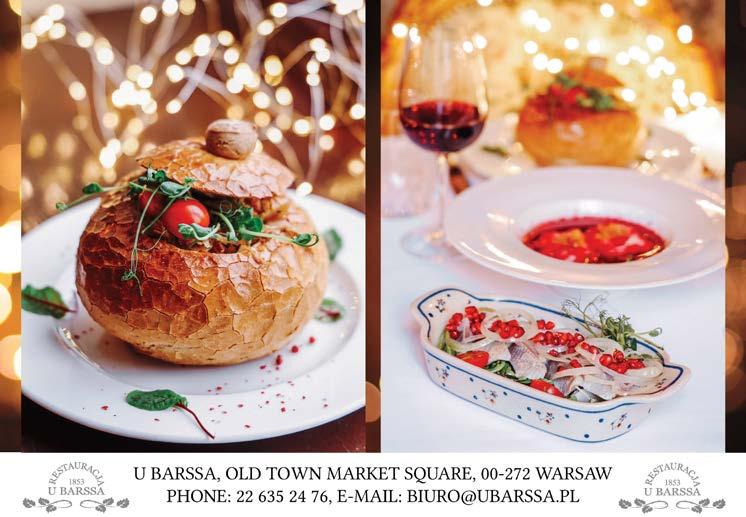
Lokal Vegan Bistro
This humble restaurant run by the ‘Margins’ Social Cooperative has achieved what not long ago was considered by many to be inconceivable: their hearty vegan variations of traditional Polish dishes are as, if not more, delicious than their meat-and-egg-based counterparts. That’s quite an accomplishment in a country that fed itself in ‘milk bars’ not so long ago. Alongside seitan, soy and cabbage ‘cutlets’ on their frequently changing menu, you’ll also find vegan versions of popular dishes from international cuisines, plus a few surprises. Large portions, fresh ingredients and low prices make this a great option for a healthy meal, but it’s also a great place to connect with Warsaw’s activist communities.QG-9, ul. Krucza 23/31, MCentrum, tel. (+48) 517 61 51 22, www. lokalveganbistro.pl. Open 12:00-21:00; Sun 12:0020:00. €€. TU6
Tel Aviv Urban Food
Opened in 2010, Tel Aviv was one of the first strictly vegan restaurants in PL, earning a cult following and launching a franchise that now has several locations around the capital. This - their original foray into Middle Eastern-inspired vegan street food - remains a popular bastion of foodie culture and social consciousness. Drop in early for sweet baghrir (Maghreb pancakes), take advantage of their generous weekday lunch offer from 12:00-16:00, munch on mezze, inhale their hummus and uncork with some wine. There’s also a decent kids’ menu. Doing well to show that vegan cuisine can be rich, exotic and visually stunning, this place has earned its accolades. Note that though they are open later, the kitchen closes at 22:00 (23:00 on Fri, Sat). However, if they have a lot of customers, they will typically be open later.QF-9, ul. Poznańska 11, MCentrum, tel. (+48) 22 621 11 28, www.telaviv.pl. Open 10:00-00:30; Fri, Sat 10:00-02:00; Sun 10:00-23:00. €€. T6
81 Dining | Casual
Fine dining
If you want to splash out on some of Warsaw's finest cuisine, we definitely have you covered - testing the food was our pleasure. Whether you're looking for the right venue to impress a potential client, romantic partner or celebrate any kind of special moment, the following pages will keep you right. Bear in mind that reservations are almost essential in any of these venues.
AleGloria
utensils Polish
Magnificent, enjoyably over-the-top restaurant in the finest part of Warsaw where the strawberrythemed decor appears amazingly at home and where their take on modern Polish cuisine will leave you determined to come back for more. AleGloria is another successful gastronomic venture looked over by the discerning eye of Magda Gessler (for those who don’t know the name, she is Poland’s most successful celebrity chef) and, therefore, it makes sense how such a restaurant can so seamlessly present the pure pleasure and simplicity of Polish cuisine while at the same time elevating it to world-class gourmet standards! Amongst the tantalising dishes with lavish descriptions on the menu, goose meat makes a lot of regular appearances, as well as other eccentric birds like ducks and gamey cuts of venison. The ‘pierogi according to Magda Gessler’ section features an especially-fascinating filling - black pudding and cinnamon, with beef tail, mushrooms, Gorgonzola,
spinach and pike! Delicious! The whimsical interior includes an illuminated salt-brick bar, with an impressive range of alcoholic beverages, including a concise list of red and white wines. Matching the boarding and fluffy bits hanging off the chandelier is a bright white upright piano, which regularly serenades the guests. AleGloria is far from a dim-lit affair, and an dine-in here is an absolutely delightful experience. Highly recommended, of course!QH-9, Pl. Trzech Krzyży 3, MCentrum, tel. (+48) 22 584 70 80, www.alegloria.pl. Open 14:00-21:00. Sat 13:0021:00, Sun 13:00-20:00. €€€€. TU
Der Elefant
utensils International
Opened back in 1990, this long-running establishment is spread over various rooms and floors, with a choice of dining experiences. From the street you’ll find their diner-style seafood bar with plenty of fresh fish; alternatively, enter through the courtyard to find a mock shop inside which you’ll see the chefs racing to fill the rapid

82
Snap up an exquisite Galician-inspired culinary delight at Rest. Baczewskich (p.84)
flow of orders. The concise but diverse menu offers a choice of hot and cold starters (including the recommended Hemingway’s Oyster), burgers, steaks, seafood and some salad and pasta options. They also have a Mon-Fri lunch offer of soup, entree and dessert for 30zł. An attractive layout and prices lower than you would expect considering the location make Der Elefant insanely popular.
Q E - 5, Pl. Bankowy 1, M Ratusz Arsenał, tel. (+48) 22 890 00 10, www.derelefant.pl . Open 12:00-24:00. €€€. TUE
Epoka
utensils Polish
This fine food experience in the Europejski luxury hotel comes courtesy of ‘Top Chef Poland’ winner Marcin Przybysz, whose modern interpretations of traditional Polish cuisine can be rivalled by few. Offering Krótkie Historie (Short Stories) and Historie (Stories) tasting menus, both play on the Polish word’s connotation to ‘history,’ taking diners on a creative culinary journey in which each dish represents a different epoch (hence the name, Epoka ) of Poland’s past, and is paired with wine by the professional sommeliers. The gleaming interiors simply ooze elegance and are worth a look even if you can’t stay for the full experience. Perfect for a pre-theatre meal or making someone feel very special, you won’t be underwhelmed. Note that though they stay open late, the kitchen closes at 21:30. Q G - 5, ul.

Ossolińskich 3, M Nowy Świat-Uniwersytet, tel.
(+48) 666 11 55 66, www.epoka.restaurant . Open 18:00-24:00; closed Mon, Sun. €€€€€. TU6
Klonn
utensils International
Nature, food and art intersect at this lovely restaurant enviably located metres from Ujazdowski Castle. The owners have brought their knack for design to the artsy, elegant interiors, while the outside seating envelops a 200-year-old tree. Head chef Michał Gniadek, awarded by Michelin and Gault & Millau, creates exquisite dishes out of fresh, seasonal ingredients, many of which are designed for sharing. The octopus is particularly buttery and delicious, there are dishes for children, and the wine list is truly excellent. Honestly, a visit here is so rewarding, it makes a trip to the nearby museums and parks that much more enticing. Don’t miss it.Q H - 11, ul. Jazdów 1B, M Politechnika, tel. (+48) 22 100 63 63, www.klonn.pl . Open 17:00-22:00; Sat 12:00-22:00; Sun 12:00-20:00; closed Mon. €€€.
TBE6
83 Dining | Upscale
Rest. Baczewskich utensils Polish
The ‘20s and ‘30s of the last century are often remembered with a great sense of nostalgia, and the vision of a young and newly-independent Poland is no different. At Warsaw’s Rest. Baczewskich, the legacy of art, culture and culinary traditions from this historic period are some of the key inspirations behind their menu and everything you see in its fabulous interior. The heart and soul of this gastronomic concept is Dmitriy Babak, born and raised in Lviv, Ukraine, a student of the Basque Culinary Center in San Sebastian, Spain, and an intern of prestigious restaurants in Warsaw and London, including “Dinner” by Heston Blumenthal, which boasts 2 Michellin stars. Babak’s home region, historically known as Galicia, is the other key influence here. This multicultural region and its unique cuisine has inspired the team to source from their own smokehouse, not to mention their own bakery section, as well as necessary ingredients for unique sweets, desserts and liqueurs. The agrarian south-eastern corner of interwar Poland (now Ukraine) gives things a slightly rustic touch, as well as varying the menu for seasonal dishes to keep the offer varied and exciting for the many return visitors that have been turned on to the magic of this place! Additionally, the Baczewskich Bar has one of the biggest ranges of liqueurs in Poland, showing off over 100 different flavors that bolster the already sizeable list of classic beverages. Lavish events and old-school cabaret numbers are also an essential part of the Baczewskich experience. A must dine!Q H - 11, Aleja Jana Chrystiana Szucha 17/19, M Politechnika, tel. +48 888 52 26 68, www.baczewskich.rest . Open 12:00-23:00. €€€€€.
TU6
Seafood Station Restaurant & Oyster Bar utensils Seafood
Just metres from the train station, this large, classy restaurant offers fresh, exquisite seafood combined with locally-sourced ingredients for one of the best meals in town. Enjoy Oysters Rockefeller, lobster, king crab, grilled tuna steak or traditional fish and chips, accompanied with wine, beer or a classic cocktail. The spacious, industrial design features an open kitchen, mezzanine, marble tables and regal touches galore, while rooting its inspiration in working class fish markets (lots of tile). The food may be simple, but the ingredients are simply top-notch and really emphasise the bounty of the sea. A feast fit for Neptune!QD/E-9, Aleje Jerozolimskie 93, MRondo ONZ, tel. (+48) 22 660 22 66, www.seafoodstation.pl. Open 12:00-23:00; Fri, Sat 12:00-24:00; Sun 12:00-22:00. €€€. U6
Thai Thai
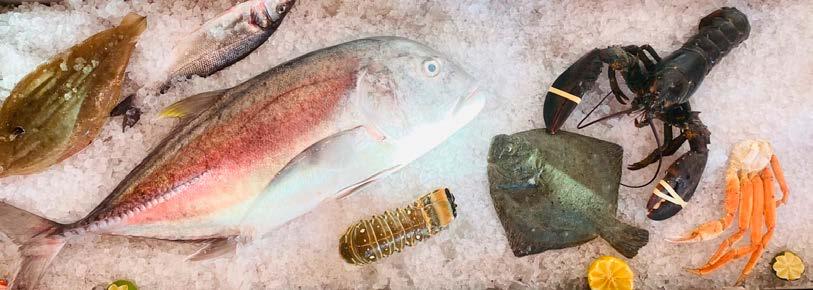
utensils Thai
Run by Warsaw’s Godfather of Thai cuisine, Surachart Urajaroen, this restaurant is 100% the real deal. No messing around with fusion concepts or making compromises. The Thai kitchen team stick firmly to tradition, and the spectacular results have earned a Thai Select certificate. Inside the National Theatre, the exterior of hefty, grey stonework gives no inkling of the opulence that awaits. Black walls with Thai designs and gold archways create a calming environment. The well laid out dining area also offers several more private spaces, great for business meetings or intimate dinner dates. Business lunch is served Mon-Fri 12:0016:00 for 39zł. Thai Thai’s Kitchen is open until 22:30 and the restaurant closes at 23:00! QF-5, Pl. Teatralny 3, MRatusz Arsenał, tel. (+48) 601 81 82 83, www.thaithai. pl/thai-thai-warszawa/. Open 12:00-22:30. €€€. XT
84 Upscale | Dining
Seafood Station: Only a crustacean would eat elsewhere.
U Fukiera
utensils Polish
Warsaw’s oldest and most famous restaurant, with a tradition going all the way back to the 16th century. Under the star stewardship of Magda Gessler (of Polish MasterChef fame), this enchanting establishment’s interior is a work of art, bedecked with oil paintings and ornate antiques, creating a fantastic ambience. It’s easy to feel like you’re a part of history when dining here, and the guestbook - with such haughty names as Naomi Campbell, Henry Kissinger and Sarah Ferguson - suggests that indeed you are. Right on the Old Town Square, enjoy the delicious, perfectly-presented food and soak up the regal atmosphere.QF-4, Rynek Starego Miasta 27, MRatusz Arsenał, tel. (+48) 600 99 99 33, www.ufukiera.pl. Open 12:00-23:00. €€€€. T6

U Kucharzy w Arsenale
utensils Polish
Located in the city arsenal - a 17th century building once used as a royal arms warehouse - this longrunning restaurant has come back from renovation with more contemporary touches and an infusion of greenery. Aptly dubbed ‘At the Chefs’ due to the huge kitchen island in the middle, watching the cooks prepare your meal is good theatre, and creates a unique dining environment. This team outputs exquisite Polish and European cuisine, including lots of courtly game dishes, rich soups and fresh fish - all of it skillfully prepared and elegantly presented. An excellent choice, especially considering its location right near the lovely Krasiński Garden!QE-5, ul. Długa 52, MRatusz Arsenał, tel. (+48) 885 88 61 50, www. ukucharzy.pl. Open 12:00-22:00. €€€. TUE
Wabu Sushi & Japanese Tapas
utensils Japanese
Sometimes stiff formality and pretence go hand in hand with fine dining, and though the food may be great, the overall experience can be a bit awkward or even, ugh...tiring. As such, it’s nice to experience exclusive dining in the Japanese Izakaya style (informal eating). Wabu is very much a place for all types of people, from businessmen to couples to tourists and even families, so relax and enjoy. The interior is a minimal and elegantly unfussy gem, that blends in nicely with its modern surroundings on Plac Europejski. The menu is extensive and diverse, and includes a special menu for kids, and a mighty lunch offer (Mon-Fri 12:00-15:00, soup and 8 pieces of sushi for 49zł). Simple and elegant, Wabu has our hearty endorsement.QC-7, Plac Europejski 2, MRondo Daszyńskiego, tel. (+48) 668 92 59 59, www.wabu.pl Open 12:00-23:00. €€€€. TU6
85 Dining | Upscale
Food Markets
The popularity of street food and fast gastro concepts has led to an explosion of food markets and indoor dining halls in Warsaw, offering dozens of diverse eating options. Not only a place to slay your hunger, these modern food markets are also trendsetting urban social spaces, featuring bars and hosting events.
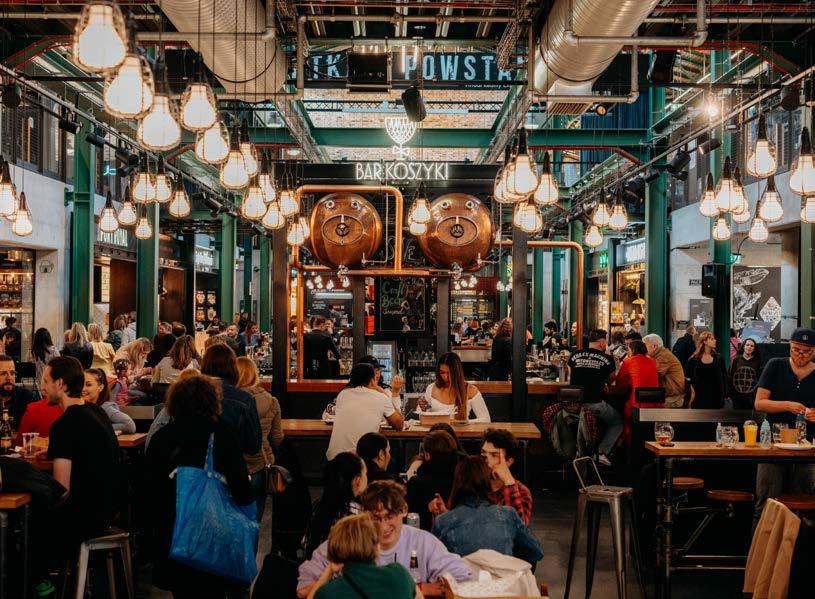
Food Hall Browary
Occupying a large, brick-walled space in the historic Brewery Cellars, this impressive food hall is arguably the social centre of the Browary Warszawskie district (p.14). With 12 different contemporary food concepts and its centrally-located bar to choose from - ranging from Silk & Spicy’s authentic Thai cuisine to Dziurka od Klucza’s new panozzo sandwich venture, ‘a’Panu occo?!’ - there are plenty of enticing options, including special breakfast and lunch offers. The focal points are the impressively long Central Bar - well-stocked with craft beer, fine wine, and cool cocktails courtesy of legendary local bartender Karim Bibars, and the small stage which hosts DJs, bands and a range of thematic events in every season of the year! Grab a seat at a communal table and get socialising.QC-7, ul. Haberbuscha i Schielego 2, MRondo Daszyńskiego, www.foodhallbrowary.pl. Open 12:00-22:00; Fri, Sat 12:00-24:00.
FOOD TOWN - Fabryka Norblina
Anchoring Warsaw’s most impressive urban revitalisation project to date, Fabryka Norblina (p.26), this massive 3200sqm indoor gastronomy market features 23 diverse culinary concepts and no less than 5 (6 in warm weather) atmospheric bars, allowing you to globetrot from Indian to Israeli to Cuban cuisine with ease. Buzzing with energy that spills out into the central courtyard, but also a covered passage in case of rain or cold, there are events 7 days a weekeverything from stand-up to fashion shows to trade fairs. DJs and live music in the courtyards and at Gimlet Live Hall - a separate 290sqm performance space. Stop by any time for a quick bite, slow sit-down meal, craft cocktail or entertainment.QC/D-8, ul. Żelazna 51/53, MRondo Daszyńskiego, tel. (+48) 577 77 74 89, www. fabrykanorblina.pl/food-town-w-fabryce-norblina/. Open Mon, Tue 08:00-22:00; Wed, Thu 08:00-23:00; Fri 08:0001:00; Sat 09:00-01:00; Sun 09:00-22:00. TU6
86
Hala Koszyki’s phenomenal urban dining offer - international restaurants, bars cafés and more!
Hala Gwardii
The grimier twin number of Hala Mirowska - its adjacent neighbour to the west (p.24) - these two enormous brick buildings were built as market halls at the turn of the century. Miraculous survivors of WWII, while Mirowska quickly returned to its function as a vast indoor market where you can buy almost anything, Hala Gwardii served as a bus depot, eventually becoming a sports hall and home to the ‘Gwardia’ Policemen’s Sports Club - hence the name. Today it still features a boxing ring, small boxing museum and portraits of Polish boxing legends on the walls, but since 2017 has returned to a modern version of its roots - as an eclectic indoor food hall and hipster marketplace focused on local and organic products. The neglected exterior gives it an alternative edge, while inside you have dozens of the city’s top gastro concepts to choose from, plus coffee, alcohol and other drinks, as well as a market of local food products. Worth checking out each weekend for frequent food festivals and other very cool events.QE-6, Plac Żelaznej Bramy 1, MRondo ONZ, www.halagwardii.pl. Open Fri, Sat 09:00-01:00; Sun 10:00-21:30 only. 6
Hala Koszyki
This historic Art Nouveau market hall originally opened in 1906, but was renovated, redeveloped into a modern mixed-use facility full of bars, restaurants, bookstores and designer boutiques, and reopened in 2016. Smashingly popular, drop in to the ground floor dining area to choose from dozens of diverse options, ranging from topclass independent bistros - like Sobremesa Tapas Bar, Port Royal and Zachodni Brzeg - to some of Warsaw’s top name gastro brands, like Ćma and Warszawski Sen. One of THE places to be seen in the capital - easily accomplished thanks to the open floor plan - sometimes the place is so packed that mere availability and access dictate which places inside that you’re able to patronage. Even if you can’t find a table at any of the cool eateries and bars, we urge you to spend some time taking in this stunning market hall, which also features shops downstairs and space for cultural events upstairs. Don’t forget to look up, down and sideways as beautiful details abound! Q F - 10, ul. Koszykowa 63, M Politechnika, www.koszyki.com . Open 08:0001:00.

87 Dining | Food Markets
Food Hall Browary - the energetic culinary court of Browary Warszawskie (p.14).
Nightlife in Warsaw
In Warsaw you’re never far from a great night out. If the weather’s warm, simply head to the river. Elsewhere skint students patronise the dive bars of The Pavilions (G-7, courtyards of ul. Nowy Świat 22/28); for a more mature alternative crowd seek out the artsy bars across the river in Praga (p.56); for a lark with the lads, hit the party strip on ul. Mazowiecka (F-6/7). In practice, bars will stay open well past their given hours if business is good, but also bolt the doors early if not. Visit our website to refine your search and see more reviews. Na zdrowie (cheers!)!

88
Experience wild and otherworldly indulgences of Pepper Night.
Pepper Night Club
Lurking about in the centre of Warsaw’s urban jungle, the beast that is Pepper Night adds a dose of spiciness to the untamed nightlife of the Polish capital. The unique atmosphere of its sophisticated interior coupled with a stunning year-round garden is perfectly complemented by a cocktail bar of the highest calibre. It’s not the only thing that will drive your senses and inhibitions to the wildest and most-euphoric heights. Throughout the night, a menu of indecently delicious food is in constant operation - something of a ‘forbidden fruit’ that other establishments of such measure dare not touch! The impressive kitchen, operated by one of Warsaw’s highest-level gastro team, is open literally all night, so you need not worry about going without! Until the early hours, Pepper Night will awaken your body with the strength of the beat - the best music straight from the DJ console.
QF-9, ul. Nowogrodzka 47A, MCentrum, tel. (+48) 730 06 80 68, www.peppernight.pl. Open Fri, Sat 20:00-04:00 only.
Bar Setki Powodów
Cocktail Bar
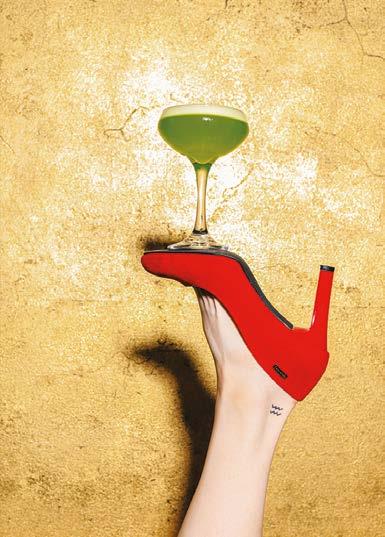
A recent (and very exciting addition) to Warsaw’s Polish Vodka Museum (p.57), Bar Setki Powodów (Bar of 100 Reasons) guarantees musical feasts, dishes out of this world, drinks poured from the stick, and an almost-constant program of grooving live music - indie rock, jazz, hip hop, experimental, and much more! Furnished in a style reminiscent of the nearby Neon Museum (p.57), this Praga nightspot shows off a concise list of cocktails, flanked by a string of other ‘reasons’ to come here. Consume as you wish, and enjoy the small-but-punchy live music stage in the corner.
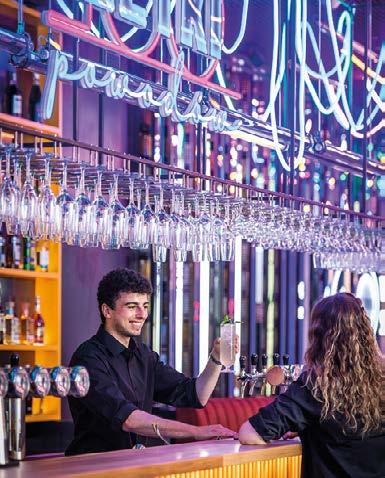
QK-2/3, Pl. Konesera 1, MDworzec Wileński, tel. (+48) 511 69 29 63, www.muzeumpolskiejwodki.pl
Open Tue, Wed 12:00-22:00; Thu 12:00-24:00; Fri, Sat 12:00-02:00; Sun 12:00-21:00; closed Mon.
89 Nightlife | Featured
UE
PoEW
Bars & Clubs
3/4 Koneser Bar
Cocktail Bar
If you’re eager to experience Polish vodka the right way (sip, don’t shoot!), go straight to the source. Located on the 3rd floor of the Polish Vodka Museum (p.57), this spectacular bar makes dozens of their own artisanal alcohol infusions - earl grey, beetroot and lemoncake are just a few of their surprising and constantly changing flavours. Sip them straight or in delicious modern cocktails inside the refined post-industrial interior that transports you back to Warsaw’s interwar glory days. The lovely seasonal terrace offers great views of the heart of Praga and they also host live music from time to time. Na zdrowie!QK-2/3, Pl. Konesera
1, MDworzec Wileński, tel. (+48) 22 419 31 52, www.koneserbar.com/. Open 16:00-24:00; Fri, Sat 18:00-03:00; Sun 16:00-21:00; closed Mon. Subject to change. UB6
AURA Bar
Cocktail Bar
Chances are you wouldn’t find this place on your own, which is why you should seek it out! Though hardly bigger than a bedroom, the locals are eager to squeeze into this corner bar located in a lovely pre-war residential building. With high ceilings and a beautiful design of oriental patterns, warm lighting and brass fixtures, Aura has a real glow to it and a friendly neighbourhood vibe. What sets it apart however, is the huge selection of bourbons. This is the kind of place where the drinks come in tumblers and the seasonal cocktails are as delicious as the atmosphere. If an ‘Old-Fashioned’ is your go-to bar order, this is your go-to bar, where they serve 11 unique varieties of the classic drink. Refreshingly relaxed, but clearly refined, great things come in small packages.QG-9, ul. Hoża 27, MCentrum, tel. (+48) 576 36 73 79. Open 17:00-01:00; Fri, Sat 18:00-02:00. B6
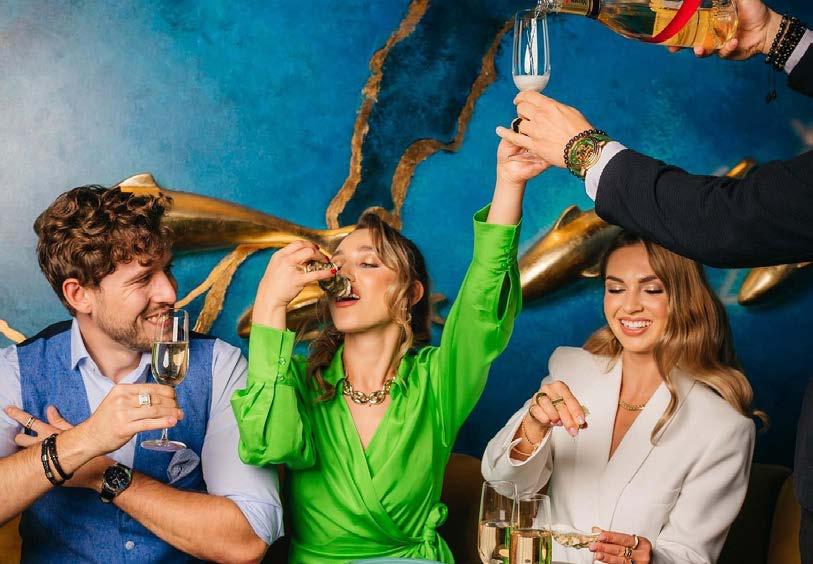
90
Drink, dine and dance the night away at Baila Show & Dining in Browary Warszawskie (p.14).
N Credit cards not accepted E Live music C-1 Map Coordinate U Facilities for the disabled o Year-round Garden M Metro X Smoking room available 6 Animal friendly
Symbol Key Category
Baila Show & Dining Club
Baila literally means dance in Spanish, and here it’s a literal call to action and command to live in the moment. This exotic establishment in Browary Warszawskie (p.14) delivers on the promise of their name, hosting live DJ sets Wednesday to Friday, while Saturday sees this place pack out with patrons eager to enjoy delicious Latin American dishes and premier eye-pleasing performances on their stage (starts at 20:30, reservations required). Afterwards, they go wild themselves during DJed afterparties. Dripping with intrigue, Baila adheres to a ‘what happens in Vegas’ philosophy and the less you know about what you’re getting into, the better the payoff. During the week, enjoy the colourful interior and oysters, steaks, salsas and other menu items with a bit less titilation. To add some extra exotic flavour, Baila switches hats and brings out its arsenal of shishas after 18:00! Choose from three types of shisha, three smoking intensities, and more than 30 flavours to choose from the best quality of tobacco. At this rate, we can say without hesitation that Baila is the best shisha bar in Warsaw!QC-7, ul. Grzybowska 60, tel. (+48) 514 06 06 24, www.bailawarsaw.com. Open 17:00-01:00; Tue 17:00-23:00; Sat 17:00-03:00; closed Mon, Sun. €€€€. E
Cuda na Kiju Multi-tap Bar

Housed in the former communist party HQ, just next to the statue of General Charles De Gaulle, this 3-level bar was Warsaw’s first multi-tap and boasts an impressive 16 taps pouring craft beers from around Poland and Europe, plus pizza for your late-night feed. The interior design is unobtrusive and kept to a minimum, making for a nice and airy atmosphere, and features three outdoor seating areas. The owners should really be given a special prize for this brilliant initiative; instead, in true Warsaw tradition, they quickly got dozens of copycat bars. Still, we stay true to our first-love multi-tap bar.QH-8, ul. Nowy Świat 6/12, MNowy Świat-Uniwersytet, tel. (+48) 784 48 97 27. Open 12:00-01:00; Fri, Sat 12:00-02:00; Sun 12:0024:00.
DZiK (Dom Zabawy i Kultury) Club
Located right near Łazienki, DZiK is one of those wonderful places that defies concise characterisation. In essence it’s an old residence (1927 to be exact, which is fitting as it seems like a place that Gatsby would have enjoyed if he’d ever made it to Warsaw), with lots of original furnishings, a glorious 1000m2 courtyard garden, and a wide spectrum
91 Nightlife | Bars & Clubs
E
of happenings that attract a diverse and inclusive crowd - everything from burlesque, cabaret, concerts and DJ nights to children’s events and yoga sessions. The restaurant serves European cuisine and it’s a lovely place to drop in for a date or a glass of wine. We list it here in clubs because the dance parties last loooong on the weekends, but you never know what could be happening here. QI-13, ul. Belwederska 44 A, MPolitechnika. Open 12:00-24:00; Fri 12:00-03:00; Sat 12:00-04:00; closed Mon, Tue. BE
Executive Lounge
Cocktail Bar
Marked by a geometric logo with a chalice embedded in it, Executive Lounge in Browary Warszawskie (p.14) is a place made for the world of refined tastes. Decorated in numerous shades of gold and brown, the premesis is divided into a larger room and separate boxes allowing for greater intimacy, ideal for those who do not want to be too conspicuous. This unique environment is complemented by sophisticated wall decorations, indicating that the individuals behind Executive Lounge know what a high-calibre atmosphere should look and feel like. The interiors of the ‘Living Room’ can accommodate about 30 people, and the bar garden will host another 15. As for the menu, original cocktails are the top dog here - Mai Tai, Champagne Shower, and the Violette 75, are all effortless creations by the bartender service, who are sublimely apt at attending to each and every occasion. There are, of course, classic cocktails and a wide range of strong alcohols, as well as an excellent selection of wines. The liquers on offer here include Fernets, which are rarely found in Warsaw,
Cynar, a unique artichoke liqueur, and the mysterious P31. Executive Lounge is particularly recommended for private events, whether it’s for business or for pleasure, and their sumptuous food menu is here to support it Find delights such as burrata, eggplant mousse, beef sirloin tartare, and beef carpaccio, or impress your colleagues with an order of their gorgeously-prepared tapas!QC-7, ul. Krochmalna 59/ U3, tel. (+48) 690 41 12 29, www.browarywarszawskie. com.pl/wizytowka-executive-lounge. Open 17:0000:00; Fri, Sat 17:00-01:00.
Hulakula Club
Entertainment centre by both day and night, but once the kids are getting tucked in, Hulakula drops its family-friendly daytime disposition for party vibes. Although unusual, the idea to also use this huge entertainment centre as an afterhours hangout place with friends is absolutely brilliant and the fun is irrepressible as this place turns into a different kind of rumpus room. DJs often play weekends, and it’s worth checking their calendar for other concerts and events. Read more about their playful offer of bowling, arcade madness and other kidsplay on p. 70 Q J - 4, ul. Jagiellońska 82B, M Dworzec Wileński, tel. (+48) 669 00 10 01, www.hulakula.com.pl . Open 12:00-23:00; Wed 12:00-01:00; Thu 12:00-02:00; Fri 12:00-03:00; Sat 10:00-03:00; Sun 10:00-23:00.
PXTUBEWKi
Hydrozagadka Club
You will not find a more unkempt bar than Hydrozagadka; this place has barely changed since it opened way back in 2007, and it still looks like it’s been ransacked by students; it’s almost advisable to check yourself for fleas when leaving. Decorations aren’t so much limited as virtually non-existent, and you won’t find much more than brick walls and a collection of seats that appear to have been rescued from the rubbish. Have we scared you off? We hope not, for while it looks scruffy, they don’t need to change a damn thing as this has emerged as one of the best places in town, found right in the heart of Stara Praga (old Praga) as both an artistic and music venue with off-beat performances enjoyed by a crowd that doesn’t get out of bed till way after noon. Q J - 1/2, ul. 11
Listopada 22 (Praga Północ), M Dworzec Wileński, tel. (+48) 502 07 09 16, www.hydrozagadka.com .
Well…all we can say about this photo from Myata Lounge is…that’s not how you use a straw.
Open Fri, Sat 22:00-03:30 only and during events. XUE6
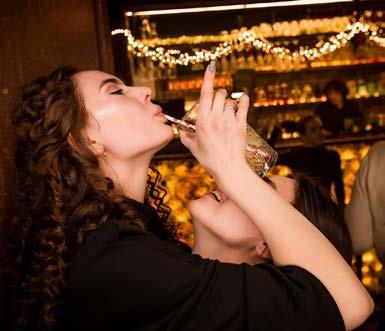
92 Bars & Clubs | Nightlife
Level 27 Club
To anyone with vertigo, a word of warning: as the name suggests, this is not some dingy cellar club, but rather an ecstatic rooftop party that puts you in the centre of Warsaw’s skyline. Rated one of the best clubs in the world, Level 27 occupies the top floor of a modern skyscraper, and includes a 450m2 open-air terrace in the summer. A showcase for high society’s beautiful people, DJs typically spin R&B and hip hop, but anything can happen from fire shows to fashion runways (check their FB). Arrive early for an incredible sunset, or better yet, keep pace with these party people to see it come up again from the best vantage point in town. Are you on the level?QC-9, Al. Jerozolimskie 123A, tel. (+48) 733 66 10 94, www. level27.pl. Open Fri, Sat 23:00-05:00 only. E
Myata Lounge
Cocktail Bar
The first Myata Lounge in PL, this franchise might be familiar to those who have wandered over the border east, and as such, the clientele skews sexy Slav. Known for good food, great drinks, shisha smoke and general debauchery in a sleek, modern interior full of plush love seats, Myata covers a lot of bases, but what makes it special is its regulars, who would rather go hard than go home. It’s a few-fucks-given kind of vibe that only the young and beautiful can pull off, and they do it here. The menu ranges from wasabi shrimp and teriyaki salmon to burgers and quesadillas, and they offer almost 300(!) flavours of shisha. There’s live music every Sunday from 21:00 and also Guinness on draught, but you’ll find most guests sipping their signature cocktails. If you were hoping Warsaw would be a bit more Wild, Wild East, check this place out.QG-8, ul. Żurawia 6, MCentrum, tel. (+48) 534 72 73 25, www.myatawarszawa.tilda.ws Open 12:00-01:00; Fri 12:00-04:00; Sat 16:00-04:00; Sun 16:00-01:00. XE
NINE’s Restaurant & Sports Bar Sports Bar
NINE’s Restaurant & Sports Bar is a one-of-a-kind dining and entertainment experience located in the Browary Warszawskie complex in Warsaw. Owned and co-run by Polish soccer god Robert Lewandowski, the restaurant serves up American cuisine with an Asian and Polish twist, and each dish is made with the philosophy of serving decent portions that are both well-prepared and presented. One interesting item on NINE’s menu is the artisanal pretzels, made in-house and taste the nutritional almond milk produced daily on site. The Sports Bar section is, quite simply, a sports lover’s
paradise. With over 20 screens in one space, they provide an unparalleled viewing experience and the octagonal bar serves as the focal point, making it easy to catch all the action from anywhere in the bar! NINE’s also features a fan zone, an event space designed for corporate events and large sports events. The fan zone features real stands and a screen that’s several dozen inches, making it feel like a cinema hall. The space is perfect for corporate events as well as for the largest sports events. NINE’s is a truly unique dining and entertainment experience, with its combination of delicious food, refreshing drinks, and live sports action. It’s ideal for relaxing, unwinding, and having a great time with simple-and-effective food and an unbeatable sports atmosphere created by some of the world’s best. QC-7, ul. Haberbuscha i Schielego 6, MRondo Daszyńskiego, tel. (+48) 660 15 26 11, www.nines.com.pl/. Open 12:00-22:00; Fri, Sat 12:00-23:00; Sun 12:00-21:00. Sports Bar open for select events only. U6
Selavi Club
Part fine dining restaurant, the menu features a wide variety of well-crafted European fare, including excellent seafood and steaks; for the more budget conscious, who still like to enjoy a bit of decadence, the set menu lunch gets the approval of both our wallet and palate. On weekday evenings, Selavi is a top-notch cocktail bar, while at the weekends it morphs into a late night club, where some of Warsaw’s most beautiful inhabitants come to dance the night away and usher in the dawn.QF-6, Plac Małachowskiego 2, MNowy Świat-Uniwersytet, tel. (+48) 535 31 89 33, www.selaviwarsaw.pl. Open 12:00-22:00; Fri, Sat 12:00-04:00; Sun 13:00-20:00. BE
SLA Warsaw Club
Don’t let the stately, nondescript facade fool you, once you enter you’ll be met with an incredibly eclectic selection of food, drinks, smokes (by which we mean shisha) and décor. It’s fitting, as ‘SLA’ refers to the mythical Shangri-La, where everyone lives in harmony and enjoys the finer things in life. With a menu that ranges from bau and tempura calamari to beef tartare, as well as some fine pizzas, there should be something to please everyone. It’s after dark, however, that SLA really shines, with every drink imaginable served from behind a 14-metre bar - said to be the longest in all of Poland, and unforgettable parties.QG-7, ul. Świętokrzyska 3, MNowy ŚwiatUniwersytet, tel. (+48) 505 60 69 36, www.slawarsaw. com. Open 18:00-01:00; Fri, Sat 18:00-05:00. E
93 Nightlife | Bars & Clubs
Smolna Club
This bunker club based on the Berlin techno model is situated in a grand old City Centre townhouse, with music delving into the diverse, murky depths of electronica. Three dancefloors - including one outdoors - three bars and a chillout room make up this hugely popular venue. Keeping things enigmatic and secretive, they have a strict ‘no photos/no smartphone’ policy and pretty cryptic marketing campaigns so you know they’re serious. QH-8, ul. Smolna 38, MNowy Świat-Uniwersytet, www.smolna38.com. Open Fri, Sat 23:00-08:00 only.
Teatro Cubano Warsaw Club

What’s that warm Caribbean breeze blowing through the centre of Warsaw? Must the blast of fresh air emanating from this sultry, rhythmic Cuban lounge and dance club. With giant palms flanking the entrance, as you enter you are enveloped by the joyful vibes and vibrant blues and yellows of this huge, spacious club with high ceilings and a massive bar at its centre, behind which is the large stage which regularly hosts international touring acts and DJs mixing Latino and pop music. Attracting a young, international crowd of students, locals and travellers, diversity is something PL could use more of, and this boisterous club embraces it. Stop by some time!QF-5, ul. Fredry 6, MRatusz Arsenał, tel. (+48) 538 19 44 94, www.teatrocubano.com. Open 22:00-03:00; Thu 22:0004:00; Fri, Sat 22:00-05:00. XE
The Alchemist Metropolitan Cocktail Bar
Patenting the ‘future of drinking’ themselves, The Alchemist’s ‘Beer Wall’ was the first of its kind in Europe. With a handy ‘Beer Wall’ card, you can pour yourself as many drinks as you like from the 8 taps on the wall, typically offering local craft beer and prosecco. Futuristic guzzling gizmos aside, however, the signature cocktails that shimmer, swirl and smoke are where the Alchemist earns its name, and their award-winning food (Gault & Millau 2020) makes this venue a must-visit. On the card of international eats are excellent Polish dishes, delicious seafood, steaks, burgers and more. If all this wasn’t enough, in the summer it’s the spacious terrace that draws the locals to lounge around for hours enjoying The Alchemist’s experimentation. Second location (without the Beer Wall) at ul. Grzybowska 5A (E-7).QF-5, Pl. Piłsudskiego 3, MRatusz Arsenał, tel. (+48) 22 628 00 23, www.thealchemist.pl. Open 12:00-23:00; Fri, Sat 12:0024:00. TU6
94
& Clubs | Nightlife
Bars
Adult Entertainment
If you’re in Warsaw and simply have your mind set on going to a strip club, we advise you to stick to our recommendations, which are vetted and centrally-located. When it comes to these types of establishments, we’ve heard reports of 8,000zł being spent willingly in one club listed here, and another of 8,000 sterling being spent unwillingly in one we don’t list. As ever, we urge you to be mindful, mind your manners, deal only in cash, don’t let anyone order drinks for you, and generally keep your wits about you. A good rule of thumb is to avoid street solicitation of any kind, especially if it comes in the form of a sweet girl with an umbrella inviting you to a club for a ‘drink’; also don’t get roped into buying a drink unless you know its price and can afford it. If you’re going to the club of your choice by taxi, make sure the driver takes you to the correct club, and not one miles away with whom they have a partnership. Employ good common sense and we’re confident you’ll have a night to remember, not regret.
Playhouse Gentleman’s Club

This smart gentlemen’s club, located in a chunky communist era building on al. Solidarności, has sustained their success with a classy approach to showing off the female form in luxurious surroundings. Their reputation in this market has even gone international, with influential website AskMen.com voting them the ‘Best Strip Club in the World’ back in 2013. Three floors covering over 800m2, four bars, three VIP rooms, an in-house ATM and 57 sizzling hot women make Playhouse THE place to visit for the discerning gent with a penchant for the erotic. Payment methods accepted: cash, card, Bitcoin and Paypal.QD-5, Al. Solidarności 82A, MRatusz Arsenał, www.playhouse.pl. Open 21:0005:00. X
Sogo Club
The largest of all the strip clubs in Warsaw at a size of 1200m2. Sogo is ridiculously easy to get to from any part of Warsaw. Simply head to the beginning of ul. Nowy Świat (G-8, at the Palm Tree) and you’ll see the brightly-lit building in the distance. The place consists of three levels: the main hall containing two bars and hundreds of seats, the VIP rooms, and even conference facilities. Should you want more privacy, the Gold Club option provides private rooms with a dedicated lounge bar and washroom facilities. The club has their customers’ desires in mind and will stay open longer if you feel you simply cannot leave by 05:00.QH-7/8, Al. Jerozolimskie 6, MCentrum, www.sogoclub.pl. Open 20:00-05:00. X
95 Nightlife | Adult Entertainment
Shopping in Warsaw
Warsaw offers a wide diversity of shopping experiences, from old school markets to luxury boutiques (primarily along ul. Nowy Świat and ul. Mokotowska: G-7, H-8/9) to some of Central Europe’s most modern shopping malls. For visitors, it’s an opportunity to shop exclusive designer brands, catch bargains on known commodities or find forgotten treasures. Happy hunting!
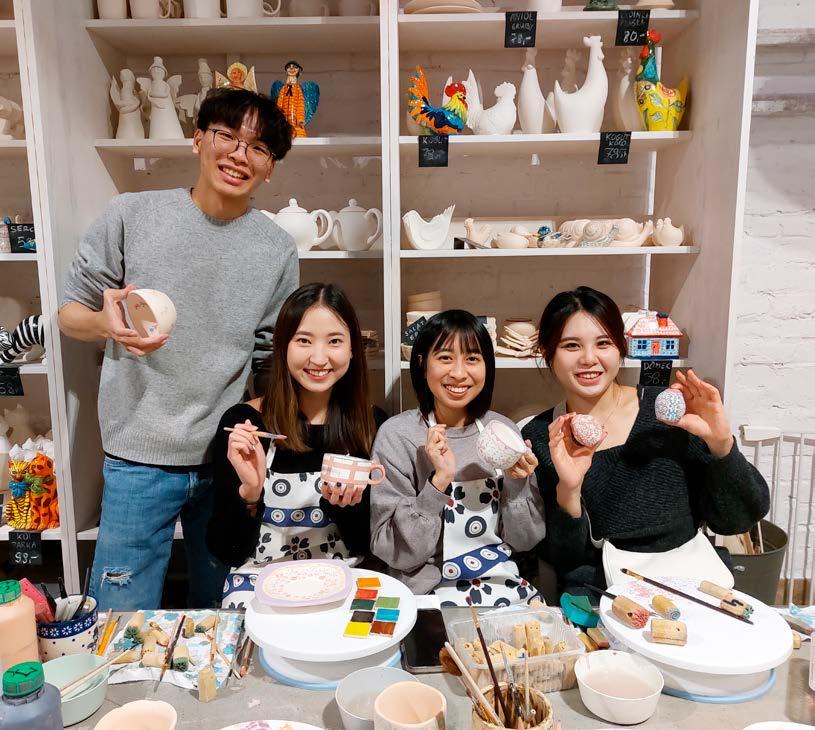
96
Pomaluj.Art (p.98) - Buy the world-famous Bolesławiec ceramics brand or make your own using the same traditional methods.
Alcohol & Tobacco
Alembik
If you’ve just come out of the Polish Vodka Museum in Praga Koneser Center (p.57) with a new appreciation for Poland’s national drink, then right around the corner, in the same building, you will find Alembik, a small but impressively stocked shop where you can purchase your very own vodkas. Here you will find Polish brands such as Luksusowa and Wyborowa, but not only, as they also sell premium whiskeys, cognacs, rums, gins and champagnes. Those showing the initiative to spend more can also taste some exclusive products in their 2nd private room!QK-2/3, Plac Konesera 1, MDworzec Wileński, tel. (+48) 513 28 92 60, www.alembik.com.pl. Open 12:00-20:00; Fri, Sat 12:00-21:00; closed Sun.
Amber & Jewellery
Amber Art Gallery - Silver Line
This gorgeous gallery specialises in luxury handcrafted jewellery of the amber variety, but crystal, silver and gold items can be purchased here too. This is the location of the largest and oldest amber dealer in the city, a family run business going back to 1988, proudly selling amber of Polish origin - certified by the International Amber Association. Even heads of State and royalty have been spotted procuring presents here, from Bill Clinton to Japanese princesses (whose thank you letters you can see inside)! Choose from pieces by Polish artisans and top designers, plus high quality jewellery made with other precious stones.QF-4, Rynek Starego Miasta 9/11/13, MRatusz Arsenał, tel. (+48) 22 831 69 61, www.warsawamber.pl. Open 11:00-18:00; Sat 11:00-19:00; Sun 11:00-17:00.
Lilou
A phenomenally successful Polish jewellery chain where customers can select their own components to create a unique and personalised piece. The range continues to grow, with the original luxury charm bracelet still the biggest seller. Choose a bracelet type and any number of simple silver or gold plated charms in a variety of shapes, then have it hand-engraved with whatever or whoever means a lot to you. A ‘must-have’ item amongst local celebs and fashionistas. Also at ul. Francuska 27 (L-7), Westfield Arkadia (B/C-2), Galeria Mokotów and Sadyba Best Mall QH-9, ul. Mokotowska 63, MCentrum, tel. (+48) 506 19 08 97, www.lilouparis. com. Open 11:00-19:00; Sat 11:00-18:00; Sun 11:0016:00*.
Fashion & Accessories
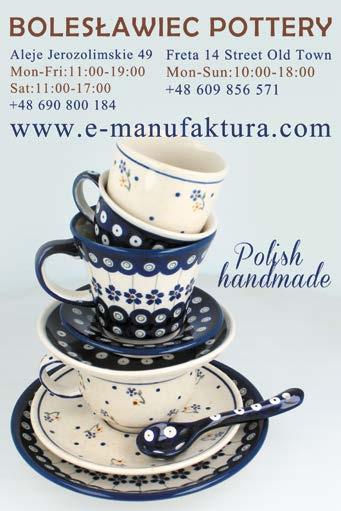
Victoria’s Secret
The brand that has become synonymous with stylish lingerie and glitzy angel-winged fashion shows. Warsaw, it seems, is delighted to have Poland’s only VS stores, and although previously their only boutiques in the city were on the smaller scale of grand, focusing mainly on accessories & perfumes, the new store in the city centre’s Złote Tarasy shopping mall is much bigger than before (now including Victoria’s Secret PINK), but the opening of Poland’s first VS flagship store located near the entrance of Westfield Arkadia Shopping Mall, with the full selection of clothing, including their lingerie, perfumes and accessories has gone down well with fashion bloggers and Varsovians alike!QC-2, Al. Jana Pawła II 82 (Arkadia), MDworzec Gdański, tel. (+48) 22 323 72 33, www.victoriassecret.pl. Open 10:00-22:00; Sun 10:00-21:00*.
97 Shopping
Find our full Warsaw Shopping Directory online iyp.me/warsaw/shopping
Shopping
Food & Sweets
E. Wedel Chocolate Lounge “OldFashioned Shop”
Ground zero for all things dark, milk and achingly sweet, Wedel is the country’s longest established chocolate manufacturer and one of the best known brands in Poland. A true Polish legend that’s been operating since Karol Wedel first opened a chocolate factory in ul. Szpitalna in 1851. In here you’ll be able to find all manner of chocolate treats, whather for yourself or as a gift for someone. Be careful when entering: chocolate comas are inevitable. Try their other city centre location on Krakowskie
Przedmieście 45 QG-7, ul. Szpitalna 8, MCentrum, tel. (+48) 22 827 29 16, www.wedelpijalnie.pl. Open 09:0022:00; Sun 09:00-21:00.
Gifts & Souvenirs
E-Manufaktura
It’s sometimes hard to find that perfect gift from Poland to take back home with you. We understand the problem, and it may be the case you get home, only to regret not having bought that sweet little tea cup you had your eye on. Now this is why we whole heartedly recommend E-Manufaktura, which is not only a shop in Warsaw, but also an online shop for you to look through an extensive catalogue in the comfort of your home. From egg cups, plates, bowls, and all other kitchenware you can think of, you’ll find it here! The famous hand-painted ceramics, Bolesławiec, make up the core of what’s on offer. It doesn’t get more Polish than this. A must use service.
QF-3, ul. Freta 14, MRatusz Arsenał, tel. (+48) 22 636 06 84, www.e-manufaktura.com. Open 10:00-18:00.
*Sunday Shopping in PL
In its effort to get people out of shopping malls and into churches, the Polish government has imposed regulations preventing most businesses from opening their doors on Sundays. Of course, there are exceptions, including 7 special Sundays when shops are open each year, and the rules don’t apply to restaurants, bars, cafes, pharmacies, gas stations, kiosks, bakeries, open-air markets, souvenir shops and anywhere the business owner is personally working behind the counter. When you see an asterisk* after the Sunday hours in our guide, that means the venue is closed on Sundays, aside from the following ‘shopping Sundays’: April 2, 30.
Pomaluj.art - Galeria Bolesławiec & Studio Ceramiki
Of all Polish gifts, none are as visually exciting as Bolesławiec pottery. At Pomaluj.art you not only get the chance to buy gifts, but you can join workshops (offered Tue-Sat 14:00-20:00) to make and paint anything you want in the studio! The staff speak English and will teach you the history of Bolesławiec pottery during your session! Show the Warsaw In Your Pocket guide or map to receive an 8% discount!QF-8, Al. Jerozolimskie 49, MCentrum, tel. (+48) 690 80 01 84, www.pomaluj.art. Open 11:00-19:00; closed Sun.
Smart Kids Store
Smart Kids Store is an extension of the innovative educational center Smart Kids Planet (p.73), and a one-stop-shop that offers a wide range of products and services related to children’s education and development. The wide selection of educational toys and games, include interactive and STEMbased toys, puzzles, and games that are designed to support children’s cognitive development and encourage problem-solving and critical thinking skills. The shop also offers a variety of art and craft supplies, which are perfect for encouraging children’s creativity and imagination. You can also find wide range of educational books, workbooks, and activity books, including storybooks, picture books, and non-fiction books in various languages, which are perfect for encouraging children to read and develop their language skills. Additionally, there’s variety of educational software and apps, which can be used to supplement children’s learning at home!QD-8, ul. Żelazna 51/53 (Fabryka Norblina), MRondo ONZ, tel. (+48) 727 77 08 80, www.smartkidsplanet.pl/. Open 11:00-20:00; Sat, Sun 09:00-20:00. UL
Zakłady Ceramiczne Bolesławiec
The official store of Bolesławiec in Warsaw is an ideal place for buying traditional, high-quality, hand-decorated ceramics. A wide wide selection of dishes, accessories and decorative elements can be found here, thay are both as beautiful as they are highly-durable and functional. Each element is handformed and then decorated with a unique stamping technique. Attention to detail, the characteristic shade of cobalt, and deep roots in tradition have made Bolesławiec ceramics known not only in Poland but all over the world. This particular store is located in the center of Warsaw, at the Rondo ONZ metro station, 800m from the central station and the Palace of Culture and Science. Also in Wrocław QD-7, ul. Prosta 2/14, MRondo ONZ, tel. (+48) 22 624 84 08, www.ceramicboleslawiec.com.pl. Open 10:00-18:00; Sat 08:00-16:00; closed Sun.
98
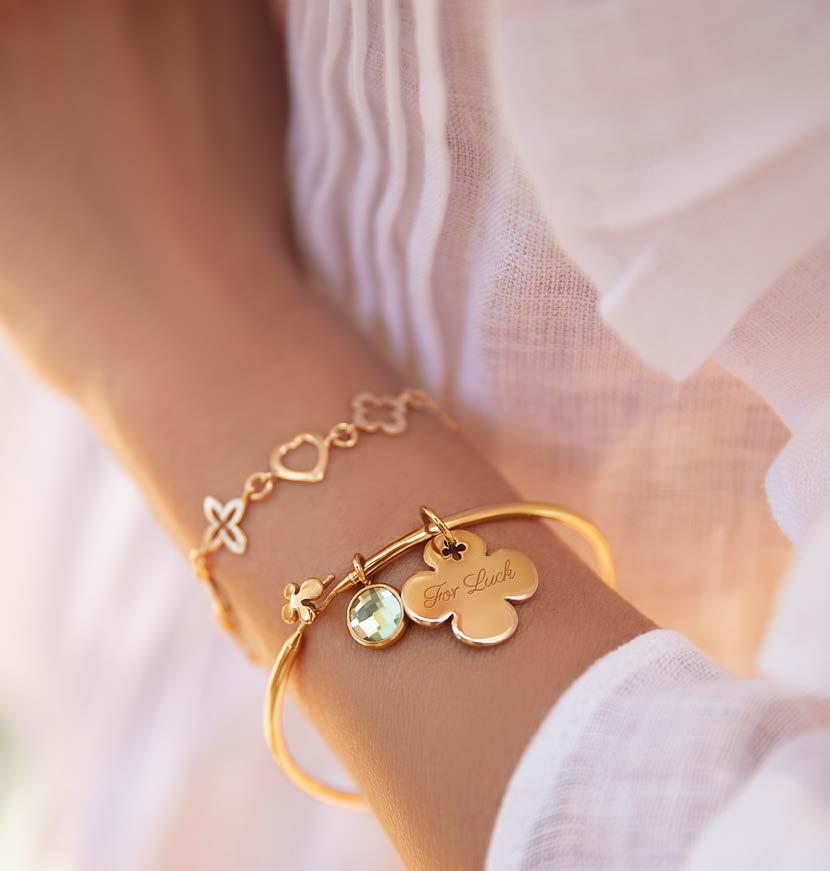
Shopping Markets
BioBazar
Once a thrice-weekly event in Mokot ó w, this popular organic food and produce market has found a permanent, daily address inside the newly revamped Norblin Factory. A lovely space packed with outstanding food products that are not only certified organice, ecological and health-conscious, but also locally-produced as well, you can bet on a daily selection of fresh fish, meats, dairy, fruits and veg, baked goods, oils, cosmetics and more. If you have the budget, food shopping doesn’t get any more appealing than this. There’s also an organice bistro on-site where you can a healthy breakfast, lunch or a glass of natural wine. Q C - 7, ul. Żelazna 51/53, M Rondo ONZ, tel. (+48) 22 508 71 74 45, www.biobazar.org. pl . Open 10:00-18:00; Sat 07:30-16:00; closed Mon, Sun.
Shopping Malls
Designer Outlet Warszawa
Set inside an impressive collection of buildings evoking the Baroque style of Warsaw’s Old Town, this is a premium outlet mall, with the interior specifically made to make you feel like you’re walking through a fashion high street. Here you’ll find discounts ranging from 30-70% off on brands like Adidas, Armani, Boss, Calvin Klein, Coccinelle, Desigual, Gant, Guess, Furla, KARL LAGERFELD, Levis, Liu Jo, Luisa Spagnoli, Michael Kors, Nike, Polo Ralph Lauren, Timberland, Tommy Hilfiger and many more. Found just 30mins from Warsaw’s city centre, and 20mins from Warsaw Chopin Airport, it’s easily reached by car and public transport (for the latter get off at ‘Energetyczna 01’ and use a zone 2 ticket).Qul. Puławska 42E, Piaseczno, MWilanowska, tel. (+48) 22 737 31 15, www.designeroutletwarszawa.pl. Open 10:00-22:00; Sun 10:00-21:00*. TU
Dom Mody KLIF
Klif has been attracting fashion lovers for over 20 years, with locations across Poland. If you think you’ve seen this all before, however, you’re mistaken. This is the capital, after all, and the quality of brands is exceptionally high, not to mention the stunning showrooms inside. Shop top tags like MaxMara, Elisabetta Franchi, PennyBlack, Michael Kors, Karl Lagerfeld and DM Moda, as well as respected mainstream brands like Olsen and S’Portofino. Another draw is the convenient, easy
to get to location - roll in by tram, bus or car. What’s more, anyone can use the services of the pro stylists at FASHION STUDIO, and this is also the only shopping centre to have a concierge point QB-4, ul. Okopowa 58/72, MRondo Daszyńskiego, tel. (+48) 535 41 14 58, www.klif.pl. Open 09:00-21:00; Sun 10:00-20:00*. Eurospar open Mon-Sat 08:3022:00; Sun 09:00-20:00*.
FACTORY Outlet Annopol
This massive outlet mall is closer than you think! Save up to 70% on premium name brands like Nike, Ecco, Medicine, Guess, Under Armour, Pepe Jeans, Marc O’Polo, Converse, Vans, Puma, Tefal, Tommy Hilfiger, Smyk, 4F, RTV Euro AGD and more. To get there take Metro M2 from ‘Świętokrzyska’ to ‘Bró dno’ and then change to tram no. 1, 3, 4 or 25 and get off at ‘Toruńska’ or ‘Annopol’. Check jakdojade.pl for live timetables.
Q ul. Annopol 2 (Białołęka), tel. (+48) 22 441 90 00, www.annopol.factory.pl. Open 10:00-21:00; Sun 10:00-20:00*. 6
FACTORY Outlet Ursus
This outlet shopping mall southwest of the city centre is preoccupied with fashion, offering top brand names at 30-70% discounts over regular rack rates. Recognisable brands include Desigual, Adidas, O Bag, Etam, Gant, ASICS, United Colors of Benetton, Smyk, Empik, Rossmann, Medicine, New Balance and many more. One of the only such outlet centres in Europe, you can get there quickly by car via the S8 route or Nowolazurowa street. You can also reach it about 30mins by train or bus; check jakdojade. pl for accurate, up-to-the-minute connections.
QPl. Czerwca 1976r. 6 (Ursus), tel. (+48) 22 478 22 70, www.ursus.factory.pl. Open 10:00-21:00; Sun 10:00-20:00*.
Galeria Młociny
Found in the north-western district of Bielany, and easily accessible via metro to the final stop, ‘Metro Młociny Bus, Tram & Metro Station,’ this is one of Warsaw’s newest, most impressive shopping malls. With over 200 stores (including Poland’s first Primark), a ‘meet and eat’ dining area containing food and drink venues (open Sundays), a super-modern cinema complex, gym and MK Bowling alley (also all open on Sundays). The topping on the cake is the impressive rooftop terrace where you can enjoy various cultural events such as dances, shows and concerts. There are also 2000 parking spots should you choose to drive.Qul. Zgrupowania AK Kampinos 15, MMłociny, www.galeriamlociny.pl. Open 10:0022:00; Sun 10:00-21:00*.
100
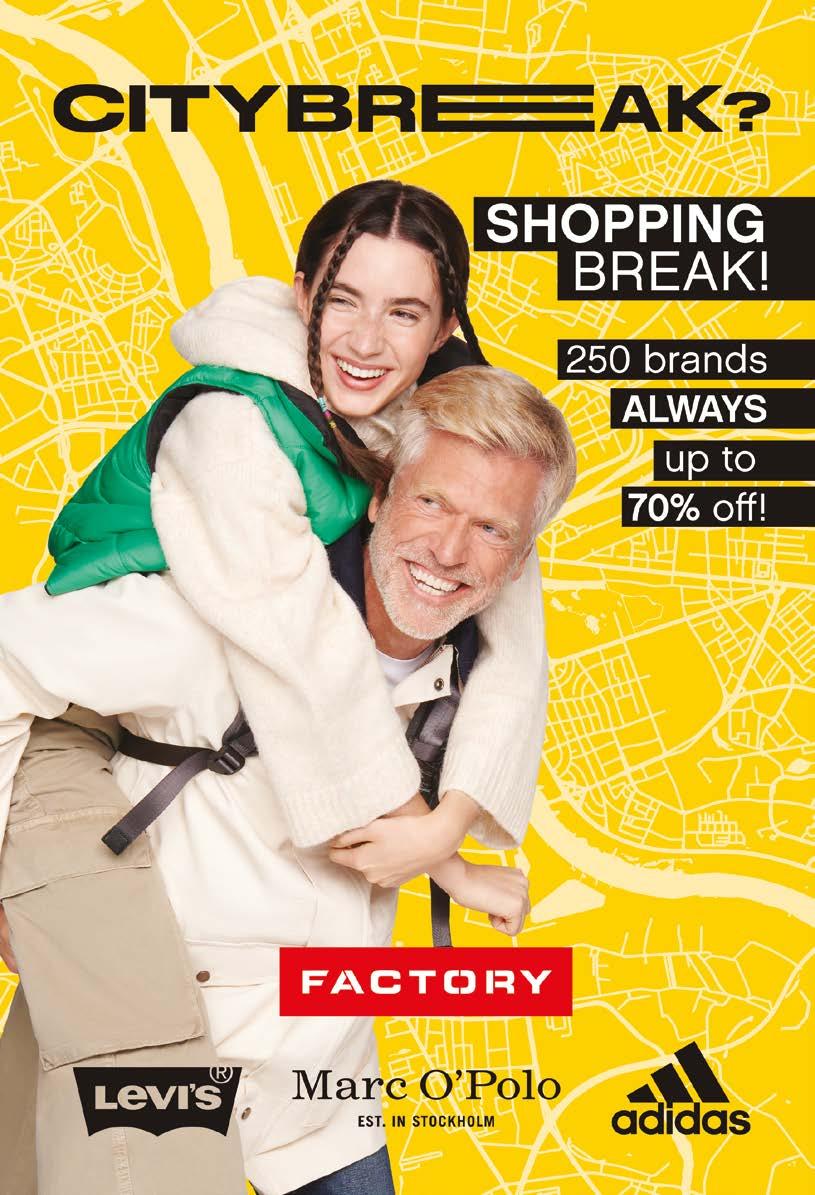
Print space is finite, but the internet is a vast, vacuous void we’ve devoted our lives to filling. If the venue you’re looking for isn’t listed here, you’ll likely find it amongst the hundreds of places in Warsaw listed on our website: warsaw.inyourpocket.com
102
NBP Money Centre 64 Neon Museum 57 Nicolaus Copernicus Monument 43 NINE's Restaurant & Sports Bar 93 Officer Cadets School 52 Okopowa Street Jewish Cemetery 67 Old Orangery 52 Old Town Defensive Ramparts 35 Old Town Square 36 Palace of Culture & Science 26 Palace on the Island 52 Pasaż Wiecha 27 Pepper Night 89 Pinball Station 72 Plac Europejski & Warsaw Spire 25 Plac Grzybowski 26 Plac Piłsudskiego 24 Plac Zamkowy 33 Plac Zbawiciela 28 Playhouse Gentleman's Club 95 POLIN Museum 67 Polish Vodka Museum 57 Pomaluj.art - Galeria Bolesławiec & Studio Ceramiki 98 Potocki Mausoleum 55 Powiśle Mermaid Statue 47 Praga Koneser Center 57 Praga Museum of Warsaw 57 Presidential Palace 42 Rest. Baczewskich 84 Royal Castle 34 Salinarium - Halotherapy Center 71 SAM Powiśle 77 Saxon Garden 24 Seafood Station Restaurant & Oyster Bar 84 Selavi 93 Skyfall Warsaw 21 SLA Warsaw 93 Smart Kids Planet 73 Smart Kids Store 98 Smolna 94
Venue Index
3/4 Koneser Bar 90 Adam Mickiewicz Monument 41 AleGloria 82 Alembik 97 Amber Art Gallery - Silver Line 97 Anielewicz Bunker 67 Apple Museum 62 Archdiocese Museum 62 AURA Bar 90 Baila Show & Dining 91 Bar Setki Powodów 89 Beef n’ Pepper 75 Belvedere Palace 51 BioBazar 100 Bristol & Europejski Hotels 42 Browar Warszawski 78 Browary Warszawskie 25 Być Może 76 Charlotte. Chleb i Wino 76 Chaud Pain 77 Chopin Monument 51 Chopin Recitals 43 Ciao Napoli 78 Clash Restaurant & Bar at NYX Hotel Warsaw 79 Copernicus Science Centre 48 Croque Madame 77 Cuda na Kiju 91 Czerwony Wieprz 79 Der Elefant 82 Designer Outlet Warszawa 100 Dom Mody KLIF 100 DZiK (Dom Zabawy i Kultury) 91 Elektrownia Powiśle 47 Elixir by Dom Wódki 75 E-Manufaktura 98 Epoka 83 E. Wedel Chocolate Lounge "Old-Fashioned Shop" 98 Executive Lounge 92 Fabryka Norblina 26 FACTORY Outlet Annopol 100 FACTORY Outlet Ursus 100 Food Hall Browary 86 FOOD TOWN - Fabryka Norblina 86 Fryderyk Chopin Museum 46 Galeria Młociny 100 Gnojna Góra 37 Gościniec Polskie Pierogi 79 Gospoda pod Zygmuntem 80 Hala Gwardii 87 Hala Koszyki 87 Hala Mirowska 24 Hulakula 92 Hulakula Leisure Centre 70 Hydrozagadka 92 Invisible Exhibition 63 Jan Kiliński Monument 34 Jewish Historical Institute 67 Katyń Museum 63 Klonn 83 Level 27 93 Lilou 97 Lokal Vegan Bistro 81 Maria Skłodowska-Curie Museum 63 Mariensztat 49 MK Bowling Entertainment Center 71 Museum of Fantastic Art 64 Museum of Hunting & Horsemanship 53 Museum of Warsaw, Main Branch 37 Museum on the Vistula 49 Myata Lounge 93 Myślewicki Palace 53 Namaste India 80 Sogo Club 95 Stacja Grawitacja 70 St. Anne's Church 55 St. Anne's Church & Tower 40 St. John the Baptist Cathedral 39 Teatro Cubano Warsaw 94 Tehran Restaurant 80 Tel Aviv Urban Food 81 Thai Thai 84 The Alchemist Grzybowska 80 The Alchemist Metropolitan 94 The Cool Cat 77 The Little Insurgent Monument 35 The University of Warsaw 42 Thai Bali Spa 70 Tokyo Sushi 80 To Lubię 77 U Barssa 80 U Fukiera 85 Ujazdowski Castle Centre for Contemporary Art 64 U Kucharzy w Arsenale 85 Ul. Kanonia 38 ul. Nowy Świat 44 ul. Ząbkowska 57 Victoria’s Secret 97 Vistula River Boulevards 47 Wabu Sushi & Japanese Tapas 85 Warsaw Barbican 36 Warsaw National Museum 64 Warsaw Photoplasticon 73 Warsaw Rising Museum 69 Warsaw University of Technology 28 Warsaw Zoo 73 White Pavilion 52 Wilanów Palace Museum 55 Wilanów Park & Gardens 54 World of Illusion 71 Zachęta National Gallery of Art 64 Zakłady Ceramiczne Bolesławiec 98

